Topic outline
UNIT1:Myself and My Community

My goals
After studying this unit, I will be able to:
⦿ Use: ‘can’, ‘may’, ‘have to’, ‘paragraphs’, ‘more’, ‘fewer’, ‘no’.
⦿ Describe leisure time activities, internet use, reading habits, facilities
in the community, the structure of local government and the provision
of social services, in speech and writing.
⦿ Compare facilities, jobs and transport in town and country in speech
and writing.
⦿ Show readiness to execute my role and responsibility as a communitymember.
A: Listening and Speaking
Describing hobbies and leisure time


Myself and My Community

Activity 3
Now answer these questions.
1. Describe the activities taking place in photos 1-6.
2. Identify which of the activities in the photos you think are done
as hobbies and those that are done as leisure activities.
3. In your opinion, do you think hobbies and leisure activities are the
same? Use the photographs to explain your answer.
4. Explain the importance of hobbies and leisure time activities in
our lives.
Recounting activitiesActivity 1
Discussion
1. Think of the activities you did over the weekend. Narrate them
to your fellow members. Now write an essay or a composition
describing those activities. Exchange your compositions with afriend to read through and compare the activities.
Describing internet activity
Activity 1
1. Use the internet from your school computer laboratory, if there
is one. If your school does not have one, visit an internet café
near your school. An internet café is a place where people get the
internet at a fee. It is also possible that some people have an internet
connection in their homes. If you have a friend who has it at home,
you can request him or her to let you use it to search the web (a
source of information on the internet about a particular subject,
published by an individual or organisation) for information.
2. Think about a topic that interests you. It could be about football,
culture, music, nature, and others. Download it in Microsoft Word
and edit the details, including the photographs and the content.Send it as an e-mail to a classmate.
Activity 2
1. Discuss with classmates. In turns, share the leisure activities that
people in your community engage in.
After class, interact with some of the people in your communityto find out why they prefer particular leisure activities to others.
Activity 3
Discussion
Think about this proverb!
“All work without play makes Jack a dull boy”.
(a) Share with a classmate what you understand by this proverb.
(b) Do you agree with this proverb? Give reasons for your answer.
(c) Explain the problems likely to be caused by a lot of leisure.
(d) How would you advise your young brother or sister to usehis or her leisure time?
B: Reading and Comprehension
Describing reading habitsActivity 1
1. Carefully study the photographs below.

(a) What do you think the people could be reading in each
photo? Give reasons.
(b) Explain the similarities and differences between photo B
and the rest of the photographs.
(c) Why do you think people engage in the kind of reading
shown in photo C?
(d) How helpful is the kind of reading shown in photo D?
Activity 2
Discussion
1. Share your views about these questions.
(a) Tell your class members what you normally like reading
about. Give reasons for your opinion.
(b) What do people in your community like to read about?
(c) Compare what you read at your school and what is read by
people in your community.
(d) The comparison in (c) above will bring out three issues:
(i) things read by people in the community but not read
at your school.
(ii) things read at your school but not read by people in
the community.
(iii) things read both by people in the community and also
read at your school.2. Give reasons for each situation above.
Reading extracts from Literature
Activity 1
Discussion
1. We have discussed reading as a form of spending our leisure time.
Tell your class members the books or magazines you have ever read.
2. Describe a memorable story you have ever enjoyed reading.
3. Stories are classfied as: fiction, comedy, drama, horror, non-fiction,
romance, satire, adventure, tragedy, tragi-comedy and fantasy. Find
out what each story type encompasses. Which of these stories do
you normally read? Explain your preference for those stories.
Activity 3
Read and enjoy the story
My father’s family name being Pirrip, and my Christian name Philip, my
infant tongue could make of both names nothing longer or more explicit
than Pip. So, I called myself Pip, and came to be called Pip.
I give Pirrip as my father’s family name, on the authority of his tombstone
and my sister - Mrs. Joe Gargery, who married the blacksmith. As I
never saw my father or my mother, and never saw any likeness of either
of them (for their days were long before the days of photographs), my
first fancies regarding what they were like, were unreasonably derived
from their tombstones. The shape of the letters on my father’s, gave
me an odd idea that he was a square, stout, dark man, with curly black
hair. From the character and turn of the inscription, “Also Georgiana
Wife of the Above,” I drew a childish conclusion that my mother was
freckled and sickly. To five little stone lozenges, each about a foot and
a half long, which were arranged in a neat row beside their grave, and
were sacred to the memory of five little brothers of mine - who gave
up trying to get a living, exceedingly early in that universal struggle - I
am indebted for a belief I religiously entertained that they had all been
born on their backs with their hands in their trouser-pockets, and had
never taken them out in this state of existence.
Ours was the marsh country, down by the river, within, as the river wound,
twenty miles of the sea. My first most vivid and broad impression of the
identity of things, seems to me to have been gained on a memorable raw
afternoon towards evening. At such a time I found out for certain, that this
bleak place overgrown with nettles was the churchyard; and that Philip
Pirrip, late of this parish, and also Georgiana wife of the above, were
dead and buried; and that Alexander, Bartholomew, Abraham, Tobias,
and Roger, infant children of the aforesaid, were also dead and buried;
and that the dark flat wilderness beyond the churchyard, intersected
with dykes and mounds and gates, with scattered cattle feeding on it,
was the marshes; and that the low leaden line beyond, was the river;
and that the distant savage lair from which the wind was rushing, was
the sea; and that the small bundle of shivers growing afraid of it all and
beginning to cry, was Pip.
“Hold your noise!” cried a terrible voice, as a man started up from among
the graves at the side of the church porch. “Keep still, you little devil,or I’ll cut your throat!”
A fearful man, all in coarse grey, with a great iron on his leg. A man
with no hat, and with broken shoes, and with an old rag tied round his
head. A man who had been soaked in water, and smothered in mud,
and lamed by stones, and cut by flints, and stung by nettles, and torn by
briars; who limped, and shivered, and glared and growled; and whose
teeth chattered in his head as he seized me by the chin.
“O! Don’t cut my throat, sir,” I pleaded in terror. “Pray don’t do it, sir.”
“Tell us your name!” said the man. “Quick!”
“Pip, sir.”
“Once more,” said the man, staring at me. “Give it mouth!”
“Pip. Pip, sir.”
“Show us where you live,” said the man. “Point out the place!”
I pointed to where our village lay, on the flat in-shore among
the aldertrees and pollards, a mile or more from the church.
The man, after looking at me for a moment, turned me upside down, and
emptied my pockets. There was nothing in them but a piece of bread.
When the church came to itself - for he was so sudden and strong that
he made it go head over heels before me, and I saw the steeple under
my feet - when the church came to itself, I say, I was seated on a high
tombstone, trembling, while he ate the bread ravenously. “You young
dog,” said the man, licking his lips, “what fat cheeks you ha’ got.” I
believe they were fat, though I was at that time undersized for my years,
and not strong.
“Darn me if I couldn’t eat ’em,” said the man, with a threatening shake
of his head, “and if I han’t half a mind to’t!”
I earnestly expressed my hope that he wouldn’t, and held tighter to the
tombstone on which he had put me; partly, to keep myself upon it; partly,
to keep myself from crying.
“Now lookee here!” said the man. “Where’s your mother?”
“There, sir!” said I.
He started, made a short run, and stopped and looked over his shoulder.
“There, sir!” I timidly explained. “Also Georgiana. That’s my mother.”
“Oh!” said he, coming back. “And is that your father alonger your
mother?”
“Yes, sir,” said I; “him too; late of this parish.”
“Ha!” he muttered then, considering. “Who d’ye live with - supposin’
you’re kindly let to live, which I han’t made up my mind about?”
“My sister, sir - Mrs. Joe Gargery - wife of Joe Gargery, the blacksmith, sir.”
“Blacksmith, eh?” said he. And looked down at his leg.
After darkly looking at his leg and me several times, he came closer to
my tombstone, took me by both arms, and tilted me back as far as he
could hold me; so that his eyes looked most powerfully down into mine,
and mine looked most helplessly up into his.
“Now lookee here,” he said, “the question being whether you’re to be
let to live. You know what a file is?”
“Yes, sir.”
“And you know what wittles is?”
“Yes, sir.”
After each question he tilted me over a little more, so as to give me a
greater sense of helplessness and danger.
“You get me a file.” He tilted me again. “And you get me wittles.” He
tilted me again. “You bring’ em both to me.” He tilted me again. “Or
I’ll have your heart and liver out.” He tilted me again.
I was dreadfully frightened, and so giddy that I clung to him with both
hands, and said, “If you would kindly please to let me keep upright, sir,
perhaps I shouldn’t be sick, and perhaps I could attend more.”
He gave me a most tremendous dip and roll, so that the church jumped
over its own weather-cock. Then, he held me by the arms, in an upright
position on the top of the stone, and went on in these fearful terms:
“You bring me, to-morrow morning early, that file and them wittles. You
bring the lot to me, at that old Battery over yonder. You do it, and you
never dare to say a word or dare to make a sign concerning your having
seen such a person as me, or any person sumever, and you shall be let
to live. You fail, or you go from my words in any partickler, no matter
how small it is, and your heart and your liver shall be tore out, roasted
and ate. Now, I ain’t alone, as you may think I am. There’s a young man
hid with me, in comparison with which young man I am a Angel. That
young man hears the words I speak.
“That young man has a secret way pecooliar to himself, of getting at a
boy, and at his heart, and at his liver. It is in wain for a boy to attempt
to hide himself from that young man. A boy may lock his door, may be
warm in bed, may tuck himself up, may draw the clothes over his head,
may think himself comfortable and safe, but that young man will softlycreep and creep his way to him and tear him open.
“I am a-keeping that young man from harming of you at the present
moment, with great difficulty. I find it wery hard to hold that young man
off of your inside. Now, what do you say?”
I said that I would get him the file, and I would get him what broken
bits of food I could, and I would come to him at the Battery, early in
the morning.
“Say Lord strike you dead if you don’t!” said the man.
I said so, and he took me down.
“Now,” he pursued, “you remember what you’ve undertook, and you
remember that young man, and you get home!”
“Goo-good night, sir,” I faltered.
“Much of that!” said he, glancing about him over the cold wet flat. “I
wish I was a frog. Or a eel!”
At the same time, he hugged his shuddering body in both his arms -
clasping himself, as if to hold himself together - and limped towards the
low church wall. As I saw him go, picking his way among the nettles,
and among the brambles that bound the green mounds, he looked in my
young eyes as if he were eluding the hands of the dead people, stretching
up cautiously out of their graves, to get a twist upon his ankle and pull
him in.
When he came to the low church wall, he got over it, like a man whose
legs were numbed and stiff, and then turned round to look for me. When
I saw him turning, I set my face towards home, and made the best use
of my legs. But presently I looked over my shoulder, and saw him
going on again towards the river, still hugging himself in both arms,
and picking his way with his sore feet among the great stones dropped
into the marshes here and there, for stepping-places when the rains were
heavy, or the tide was in.
The marshes were just a long black horizontal line then, as I stopped to
look after him; and the river was just another horizontal line, not nearly
so broad nor yet so black; and the sky was just a row of long angry redlines and dense black lines intermixed
On the edge of the river I could faintly make out the only two black
things in all the prospect that seemed to be standing upright; one of these
was the beacon by which the sailors steered - like an unhooked cask
upon a pole - an ugly thing when you were near it; the other a gibbet,
with some chains hanging to it which had once held a pirate. The man
was limping on towards this latter, as if he were the pirate come to life,
and come down, and going back to hook himself up again. It gave me a
terrible turn when I thought so; and as I saw the cattle lifting their heads
to gaze after him, I wondered whether they thought so too. I looked all
round for the horrible young man, and could see no signs of him. But,
now I was frightened again, and ran home without stopping.(Source: Extract from “Great Expectations” by Charles Dickens)
Activity 4
1. Visit your library and borrow the novel ‘The Great Expectations’
written by Charles Dickens. Read it. Discuss the plot of the story.
Explain the challenges Pip faced and how he struggled to overcome
them.
2. Language can be categorised as formal or informal or slang. Use
the dictionary to find out the meanings of these terms.
3. The fierce man on page 10-11 uses slang. Identify the slang words
and provide their formal equivalent words. In literature all thesetypes of language are permitted for use.
DiscussionActivity 5
Think of a real–life situation where the story of Pip applied to your life.Discuss the situation with your friends.
Describing facilities in the communityActivity 1
Work
The table below shows facilities that are normally found in communities,
whether in towns and cities or in the countryside. Study the table
carefully. Fill in the missing information. Compare your answers with
other classmates.
(i) Use a tick (√ ) to show the facilities that exist in your
locality.
(ii) For those that are not found in your locality, show
them using a cross (×).
(iii) In the third column, indicate the importance of eachfacility to people’s lives.
Activity 2
Discussion
(a) Have you ever been to both the countryside and the city?
(b) Briefly describe the differences between the two places.
(c) Which of the two places would you prefer to live in? Givereasons for your choice.
Activity 3
Read the following passages
My country home
I live in a small village with my family. There is a narrow murram road
connecting my village with the nearby town. Most people walk or ride
bicycles to the town. There are fewer facilities compared to the city. We
have a health centre and a primary school in our community. However the
health centre does not have enough medicine. The primary school lacks
enough teachers and scholastic materials for proper studying. People
collect water from streams and wells or from boreholes. Shopping is
done at the nearby trading centre but many essential commodities are
often not there. People have to travel to town to shop for some essential
commodities. There is no post office, so people can only send letters by
travelling to town to post them. There may be people who want to bank
their money, but there is no bank in our village. In my village there ismore land than in the city which can be used for farming and other uses.
It is also easy to get cheap food in my village. Many people in the village
are farmers. They earn money by selling food. The incomes are lower
than those in the town but the cost of things is lower than that in the city.
My city home
I was born and brought up in Kigali City. The roads are good and are
connected to almost every part of the country. There is a large population
and there are many vehicles to transport people and goods. There are
many hospitals and schools with very good facilities. The buildings are
big, tall and amazing to look at. Most of the country’s administrative
offices and head offices of government departments and organisations
are found here.
It is also where we find the National Bank of Rwanda and head office
of the University of Rwanda. There are a number of industries where
people are employed. The people looking for jobs are usually more than
the available jobs. Others are government workers and they are paid
salaries. Incomes are higher but things are more expensive than in the
village. Many people have piped clean water supplied to their houses
and electricity. Shopping is made easy by the numerous supermarkets
and shops found all over the city. There are also various entertainment
centres. People often travel using their own vehicles or they use publictransport such as buses or taxis.
After reading the two passages, answer these questions
(a) Why do you think there is a large population in the city?
(b) Explain what makes the countryside a good place to live in.
(c) In your opinion, what are the problems faced by people
living in towns?
(d) In your opinion, where is life more challenging; in the townor in the village? Why?
Comparing facilities in the country/town
Activity 1
Discussion
(a) The photos (1 – 16) show facilities in the countryside andin town. Study them carefully.




Activity 2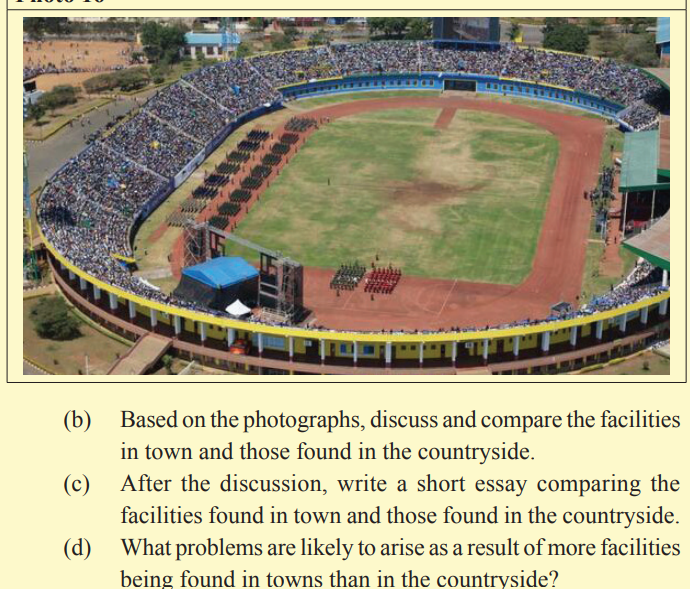
Debate the motion: Town life is better than village life. What would
be your points supporting the motion? What would be your arguments
against the motion?
Comparing jobs in the country/ townActivity 1
Discussion
Study the photographs and describe what is taking place. Where is onelikely to find the jobs being done in the photograph?

Comparing transport in the country/ town
Activity 1
Discussion
Discuss these questions:
(a) How do people normally travel in your community?
(b) Discuss the transport means available in your community.
(c) Explain the challenges your community members face in
terms of transportation of themselves and their goods.
Choose a secretary to present your findings to the class for comparison
and further discussion.
Describing social services
Activity 1
(a) Name the kind of services provided by the government to
your community. Explain the role each of them plays in
people’s lives.
(b) Explain how the government manages to get money to use
in providing services to the people.
(c) Apart from the government, non-governmental organisations
can also provide services to communities. Which of such
organisations are found in your community? Explain the
kind of services they provide.
(d) How do these organisations manage to get money to be ableto provide services to the community?
Activity 2
Read this text carefully
The provision of social services is done by the government or nongovernmental organisations for the benefit of the community. These
include education, medical care, housing, food, roads, welfare and
poverty reduction programmes.
In Rwanda, the Ministry of Health is committed to improving the health
of the Rwandan people by strengthening the quality of health care and
providing access to treatment through the health insurance scheme
(Mutuelles de Santé).
The ministry also launched a community-based insurance scheme in
the country. The scheme covers all services and medicine provided by
the health centres to sick people as well as ambulance transport to the
hospital.
The beneficiaries are required to contribute to the scheme. However, the
government pays for the very poor people as well as other vulnerable
groups who cannot manage to contribute to the insurance scheme.
Through the “Girinka programme”, the government has been able to
reduce poverty and child malnutrition among poor rural families. This
programme also known as “one cow per poor family” is a system by
which each poor family is given one cow. It is aimed at improving their
living conditions and giving them hope for survival.
This programme combines livestock and crop farming. The cows produce
milk which is a source of nutrition for the family as well as income from
the sale of surplus milk. The cows also provide organic manure used
to fertilise the soil. As a result, this improves their livelihood through
a more nutritious and balanced diet from milk, increased agricultural
output through higher soil fertility and higher incomes
The Rwandan government introduced the national human settlement
policy, which came to be known as “Imidugudu”, in December 1996.
This policy focused on group settlement as a way of solving the problem
of land scarcity. It aimed at establishing specific residential areas in each
village in efforts to promote proper land utilisation and the provision
of basic services.
With the help of United Nations agencies such as the United Nations
High Commissioner for Refugees (UNHCR) and a number of
nongovernmental organistions such as PREFER (Poverty Reduction
Education Family Empowerment), the government then began building
homes for the hundreds of thousands of people who were returning from
exile after the war. Most beneficiaries were the vulnerable survivors of
the genocide, many of whom were widows and orphans.
The programme since 1997 has been modified and extended to help
the rural people more generally. This is aimed at bringing scattered
households closer together in villages. The concept of Imidugudu was
seen to offer many advantages to the population because of the fact that
people would be living together in defined areas. This would make it
much easier and more efficient for the government to provide social and
economic services to the population.
Under this programme, the government focuses on the provision of
services such as health, education, water and sanitation. The government
also aims at providing roads and other communication networks,
agricultural extension services and easy reach to markets. This wouldeventually encourage development in these locations.
Questions
1. After reading, make notes on the text using topic headings of the
issues talked about in the text.
2. Briefly talk about other programmes the government has put inplace to help in the provision of social services to the people.
Activity 3
Activity - Research
The table below shows a number of agencies involved in the provision
of social services to Rwandan communities. You are advised to use the
library and the internet to fill in the table by stating the kind of services
provided by each provider and their source of funding. An example hasbeen given to assist you in completing the table.
Activity 4
By now you should have noticed that provision of social services can
be carried out by the government or non-governmental organisations
or private institutions which supplement the government’s efforts. In
order for social services to reach the ordinary or common people, the
government depends on local councils in communities to deliver the
services. Therefore, the role of local council officials is very important
in service delivery.
(a) Your school will invite an official from the local council to
come and talk to you about social service delivery. Listen
to him or her.
(b) You will have the opportunity to share ideas with the official.
(c) You will also ask questions about the provision of social
services in order to gain more knowledge about social
service providers, the kind of services they provide and howthey fund their activities
Describing local government processesActivity 1
(a) How are local leaders in your community elected?
(b) Explain some of the duties of local leaders in your
community.
(c) Is it important for the people in a community to get involved
in administrative processes of their communities? Give
reasons for your answer.
(d) Describe some of the administrative processes that the
people of your community participate in.
Activity 2
(a) Your school will invite an official from the local council to
talk to you about the organisational / administrative structure
of local government and the importance of local government
processes such as voting and council meetings.
(b) You will have the opportunity to share ideas with the official.
(c) You should ask questions about the how administrative
structures are formed right from the lowest level in village
communities to the national level.
Talking about responsibilities
Activity 1
Discussion
(a) Carefully study the diagram below showing the organisational
/ administrative structure of a district local government inRwanda.
(b) Draw a similar diagram showing the administrative structure
of your school. You may need to consult your head teacher
or any other teacher to guide you.(c) Compare your work for further discussion.
Activity 2
In Activity 1 above, you were shown the administrative structure of
a district local government in Rwanda. The diagram below shows
the process of service provision under the district local government
structure through different departments. Study it carefully and answerthe questions that follow.
(a) According to the diagram above, the provision of social
services starts with planning and budgeting. Why do you
think this is necessary?
(b) Of what importance are sport, leisure and culture in people’s
lives?
(c) Explain the steps taken by the local government to promote
agriculture in your area.
(d) Why do you think collecting taxes is necessary in theprovision of services?
Activity 3
Dialogue
Practice this dialogue before answering the questions that follow.
Gakwaya: Good afternoon, Keza.
Keza: Good afternoon, Gakwaya.
Gakwaya: Yesterday, I saw you walking across the road. Where
were you coming from?
Keza: Oh! I was coming from the District Council headquarters.
Gakwaya: What had you gone to do there?
Keza: I had gone to attend a discussion organised by the Mayor
involving other government officials.
Gakwaya: What was it about?
Keza: It was about sensitising people about the duties and
responsibilities of the government and the citizens
themselves towards the development of their communities
and Rwanda as a whole.
Gakwaya: It must have been very interesting. I wish I had known.
I would also have attended.
Keza: Sure, yes; it was not only interesting but also quite educative!
Gakwaya: Would you mind sharing with me what you learnt from there?
Keza: I don’t mind at all. First and foremost, we were informed
that we as citizens have the responsibility of keeping our
environment clean. We also have the duty to protect,
safeguard and promote the environment.
Gakwaya: But I thought that it is government that is responsible for
protecting and safeguarding the environment.
Keza: The environment includes all the things around us,
including the homes where we live. So some parts of the
environment require our personal effort to protect and
safeguard them. We don’t always have to wait for the
government to look after our homes
Gakwaya: That is correct. But what about our environment such
as forests and wetlands? Who is responsible for their
protection?
Keza: Well, the government plays a very big role in protecting
these. But we as citizens also have our part to play. For
example, we can protect our forests by not cutting down
trees. Wetlands such as swamps can be protected by not
draining them.
Gakwaya: What are other roles and responsibilities of the
government?
Keza: The government is responsible for providing health care
to the citizens and other social services and necessities
such as security, clean water, schools and roads.
Gakwaya: Is there any role played by citizens in the promotion of
security of their communities and the country as a whole?
Keza: Definitely. Security is a very sensitive issue and so it can
be best promoted through the involvement of everyone.
All citizens have the duty to safeguard peace, security
and democracy; and to participate in the defence of their
motherland. Citizens also have the duty to participate in
the development of the country.
Gakwaya: You really gained a lot of knowledge and understanding.
Is there any chance that there will be such a discussion
in future? I would certainly attend.
Keza: Yes. There is going to be another one in one month’s
time. I will remind you one week before it takes place.
Gakwaya: I will be very grateful. Goodbye for now.Keza: Goodbye to you
Exercise
1. Other than the duties and responsibilities mentioned above, state
the other responsibilities of:(a) the government (b) the citizens
2. Explain the responsibilities of:
(a) parents
(b) children
3. (a) Why do you think it is not a good idea to encroach on wetlands?
(b) In which other ways can we ensure that our forests are not
destroyed?
4. Explain how citizens contribute towards the promotion of peace
and security in their country.
5. How does peace contribute to the development of your country?C: Writing
y Language structure
Activity 1
Gap filling
Complete these sentences using the words in the box below. A wordmay be used more than once.
can, may, have to
1. I …………..be at home before dark because there are many thieves
on the way.
2. Driving a vehicle ……… be dangerous if you are not well trained.
3. You …………….. go for the trip if you have the money to pay.
4. I ……….. not go to town tomorrow if it rains.
5. My son ………. speak three languages: English, French and Swahili.
6. The head teacher says we ……… enter the office now.
7. Peter ……… have forgotten his phone at home.
8. We …….. study hard if we want to pass examinations.
9. She …….. go back home early because her child is sick.10. You ………. carry your umbrella. It is likely to rain today.
Activity 2
Rearrange the following sentences and use them to write
a paragraph.
1. He is in my class and he is very bright.
2. I talked to my father since he works with an organisation that
sponsors children’s education.
3. I met him the next day and took him to our home.
4. One day I was going to school.
5. My father then agreed to talk to his bosses about the boy’s
problem.
6. He told me to bring the boy to our home.
7. I met a poor boy who looked miserable.
8. He told me that he loved to go to school, too.
9. After talking to him, my father sympathised with the boy’s
situation.10. Fortunately my father’s bosses accepted to pay the boy’s fees.
Activity 3
Multiple choice
Choose the correct answer from the alternatives given.
1. She has ……………...... friends than me.
(a) many (b) more (c) much
2. We saw ……………. people in Kigali City.
(a) more (b) much (c) many
3. Rudasingwa doesn’t have ……….. friends at school.
(a) many (b) more (c) much
4. There are ……… schools here than in my village.
(a) many (b) more (c) much
5. There are too ……….. questions in this exercise!
(a) many (b) much (c) very
6. I am sure I did not make ………… mistakes in the examination.
(some/any)
7. I have ………. money, so I will buy you lunch. (any/some)
8. That is very kind of you because I don’t have ………… money
on me. (some/any)
9. I went to the butchery but I did not buy …… meat. It was very
expensive. (some/any)
10. Do you have any food left? No, I do not have ……… (some/any)
11. There are ………… people here than in the centre of the city.
(less/fewer)
12. ………… children are studying French these days. (Less/Fewer)
13. There are ………. jobs than the number of people applying for
them. (less/fewer)
14. We closed the business because there were………… customers
than we had expected. (less/fewer)
15. We witness ……….. accidents these days because of tougher
laws. (less/fewer)
16. ..................... of the soldiers who went on patrol has come back.
(No/None)
17. ............................... of his friends would help him. (No/None)
18. Have you any newspapers? I am sorry, sir, but there are .............
left. (some/none)
19. She wanted some sugar but there was……… in the house. (no/
none)20. ..................of them has come back. (Some/None)
Practice exercise
1. Write a composition comparing a nearby town with your home village.If you live in a town, compare your home town with a nearby village.
Arrange the composition as follows:
Paragraph 1: How big is it? What is found there?
Paragraph 2: What good things are found where you live?
Paragraph 3: What problems are found there?
Paragraph 4: What changes would you like to see in your town or
village?
2. Read the following poem and answer the questions that followHome sweet home
Whether it be a bungalow
All built with red burnt bricks
Roofed with beams and iron sheets
With levelled floor all covered in tiles
Still it be my home sweet home
Whether it be a little hut
All walls smeared with mud and clay
Thatched with grass, straw and poles
With hard beaten earthen floor
Still it be my home sweet home(Ivan Tuhairwe 2016
Exercise
1. How many types of houses are described in the poem?
2. Compare the top covering of each house.
3. Point out one similarity of the houses.
4. Explain where these houses would most likely be found. Give
reasons for your view.5. Which of the houses would you prefer to stay in? Why?
UNIT2:Climate Change and Wildlife Protection
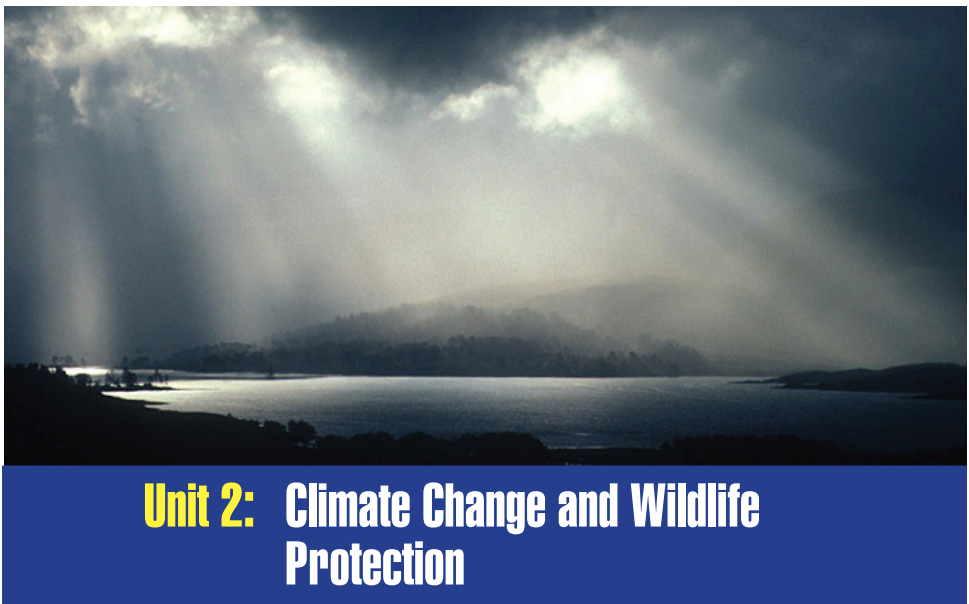
Introductory activity: Read the following text and answer
questions below:
Impact of climate change on human health
The impacts of climate change include warming temperatures, changes
in precipitation, increases in the frequency or intensity of some extreme
weather events, and rising sea levels. These impacts threaten our health by
affecting the food we eat, the water we drink, the air we breathe, and the
weather we experience.
The severity of these health risks will depend on the ability of public health
and safety systems to address or prepare for these changing threats, as well
as factors such as an individual’s behavior, age, gender, and economic status.
Impacts will vary based on where a person lives, how sensitive they are to
health threats, how much they are exposed to climate change impacts, and
how well they and their community are able to adapt to change.
People in developing countries may be the most vulnerable to healthrisks globally, but climate change poses significant threats to health even
in wealthy nations such as the United States. Certain populations, such as
children, pregnant women, older adults, and people with low incomes, face
increased risks.
Warmer average temperatures will lead to hotter days and more frequent
and longer heat waves. These changes will lead to an increase in
heatrelated deaths in the United States—reaching as much as thousands to tens
of thousands of additional deaths each year by the end of the century during
summer months.
These deaths will not be offset by the smaller reduction in cold-related deaths
projected in the winter months. However, adaptive responses, such as wider
use of air conditioning, are expected to reduce the projected increases in
death from extreme heat.
Exposure to extreme heat can lead to stroke and dehydration, as well as
cardiovascular, respiratory, and cerebrovascular disease. Excessive heat is
more likely to affect populations in northern latitudes where people are less
prepared to cope with excessive temperatures. Certain types of populations
are more vulnerable than others: for example, outdoor workers, student
athletes, and homeless people tend to be more exposed to extreme heat
because they spend more time outdoors.
Additionally, younger children, pregnant women, older adults, and
people with certain medical conditions are less able to regulate their bodytemperature and can therefore be more vulnerable to extreme heat.
Comprehension questions
1. Identify different impacts of climate change.
2. Explain how climate change impacts affect human health.
3. Which factors increase the severity of the climate change impacts
on human health?
4. What are the consequences of extreme climate changes? How can
these consequences be averted?
5. What are different diseases caused by extreme heat?6. What group of people that are mostly affected by excessive heat?
Vocabulary
Use each of the following words in your own sentence.
a) Precipitation
b) sea levels
c) severity
d) threats
e) vulnerable
f) longer heat waves
g) offset
h) stroke
i) dehydrationj) cerebrovascular disease
Application activity
Debate on the following motion:Areas with cold climate favors health more than those with hot climate
Language use: Describing climate
change
Describing climate change
Activity 1
1. Work with a classmate.
2. Look outside your classroom. In turns describe the weather you
see. Does the weather sometimes change?
3. Are there times when you experience very hot weather as opposed
to cold weather?4. What do you think brings about these weather changes?
Activity 2
Read the passage below carefully
Climate change is already beginning to transform life on Earth. Around
the globe, seasons are shifting, temperatures are increasing and sea levels
are rising. And meanwhile, our planet must still supply us – and all
living things – with air, water, food and safe places to live. If we don’t
act now, climate change will rapidly alter the lands and waters we all
depend upon for survival, leaving our children and grandchildren with
a very different world.
Heat-trapping gases emitted by power plants, automobiles, deforestation
and other sources are warming up the planet. In fact, the five hottest
years on record have all occurred since 1997 and the 10 hottest since1990, including the warmest years on record – 2005 and 2010.
Climate Change Impacts: Higher Temperatures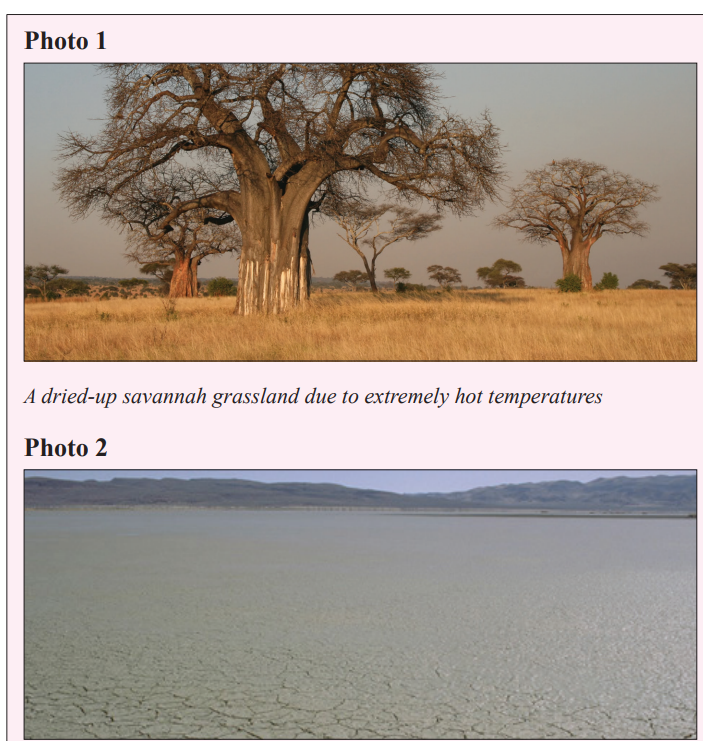
High temperatures are to blame for an increase in heat-related deaths
and illness, rising seas, increased storm intensity, and many of the other
dangerous consequences of climate change.
During the 20th century, the Earth’s average temperature rose one degree
Fahrenheit to its highest level in the past four centuries – believed to be
the fastest rise in a thousand years.
Scientists project that if emissions of heat-trapping carbon emissions
aren’t reduced, average surface temperatures could increase by 3 to 10degrees Fahrenheit by the end of the century.
A one-degree increase may be found in one place, a 12-degree increase
in another place, and yet other areas may become much colder.
The planet’s oceans are also warming, which is causing dangerous
consequences such as stronger storms, coral bleaching and rising seas.
Exercise
Answer these questions about the passage
1. Cite examples from the passage to explain what you understand
by climate change.
2. Explain how climate change alters the land.
3. How are industrial processes responsible for climate change?
4. Explain what carbon emissions are and describe what would
happen if heat-trapping carbon emissions are not reduced.
5. Look at photograph 2 of a lake that dried. What does this situation
teach you about humans checking their negative responsiveness
to the environment?
6. Some of the most dangerous consequences of climate change are
mentioned in the passage. Which one will have the most seriousimpact on our lives, or on the places we care about?
Activity 3
Vocabulary practice
Identify new words from the passage you are not familiar with. Find
their meaning either from a dictionary or ask your Geography teachers.
Form your own sentences using the words and phrases to show that
you have understood their meaning.
Describing climate change
In the previous lesson, in the reading section, we learnt about climate
change and concluded that if we do not check our human actions towardsthe environment, we are headed for doom.
Activity 4
Discussion
Share your opinions about these questions.
1. Explain the effects you think climate change can cause on our
natural resources like land, forests, animals, the air we breathe
and our water resources.
2. Suggest what you think should be done to protect these resources.
3. How about humans and other lives in general; what do you predict
will happen to us as a result of climate change?
Choose a secretary to present your findings to the class for furtherdiscussion and comparison of your views
Climate Change Impacts: Changing Landscapes
Activity 5
Study the photograph carefully and use it to explain the
effect of climate change on the land. What consequences
will follow in relation to food supply and human survival?Photo 3

Activity 6
Practice, and act out the dialogue for the class.
Justine: Hello Bruce. I’m most concerned that changing
temperatures are causing vegetation shifts and
conservation challenges.
Bruce: Indeed. Rising temperatures and changing patterns of rain
and snow are forcing trees and plants around the world
to move towards polar regions and up mountain slopes.
Justine: What do you predict will be the outcome of these drastic
changes?
Bruce: These vegetation shifts will undermine much of the
work the conservation community has accomplished to
date, with the potential to permanently change the face
of conservancy preserves, local land trusts, and even our
national parks.
Justine: That’s for real because in our geography lessons today we
were looking at how in the tundra, thawing permafrost
will allow shrubs and trees to take root. In the Great
Plains of the United States, grasslands will likely become
forests. And New England’s fiery fall foliage will
eventually fade as maple and beech forests shift north
towards cooler temperatures.
Bruce: The case is no different here in Africa; the average
temperature of the earth has risen in the last decade.
Since the last century, the snow on Mount Kilimanjaro
has tremendously reduced. The temperatures have risen.It is really a pity
Justine: And I guess wildlife has migrated to other areas.
Bruce: Oh, that is for sure! As plant communities try to adjust
to the changing climate by moving towards cooler areas,
the animals that depend on them will be forced to move.
Development and other barriers may block the migration
of both plants and animals.
In fact, some species that may not adapt to the new
environment will die.
Justine: Oh no! That is absurd. Our treasured wildlife is at risk!What should we do to rectify this precarious situation?
Activity 7
Composition
Write an essay that answers the last statement by Justine on what should
be done to solve the climate change problems in the dialogue. Exchange
your essays for comparison and discussion of your views.
Predicting the effects of climate change
Activity 1
Work together
From all the passages you have so far read in this unit about climate
change, give your prediction about what might or could occur in thefuture if global warming persists.
Activity 2
Read the passage belowClimate Change Impacts: Rising Seas, Higher Sea Levels
The rise of sea levels due to climate change could displace tens of millions
of people.
As the Earth heats up, sea levels rise because warmer water takes up
more room than colder water, a process known as thermal expansion.
Melting glaciers compound the problem by dumping even more fresh
water into the oceans.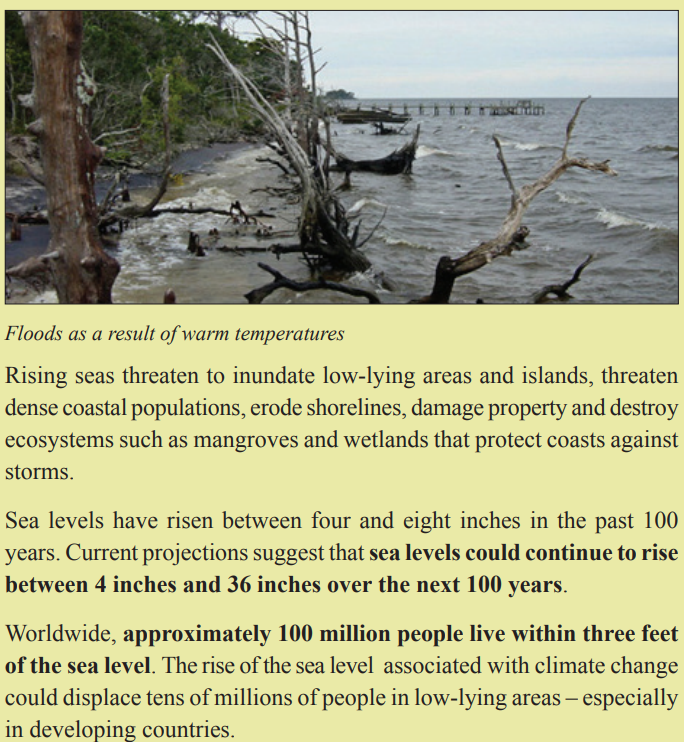
Inhabitants of some small island countries that rest barely above the
existing sea level are already abandoning their islands, some of theworld’s first climate change refugees.
Climate Change Impacts: Increased Risk of Drought,Fire, and Flood
Climate change is making floods, fires and droughts more frequent and severe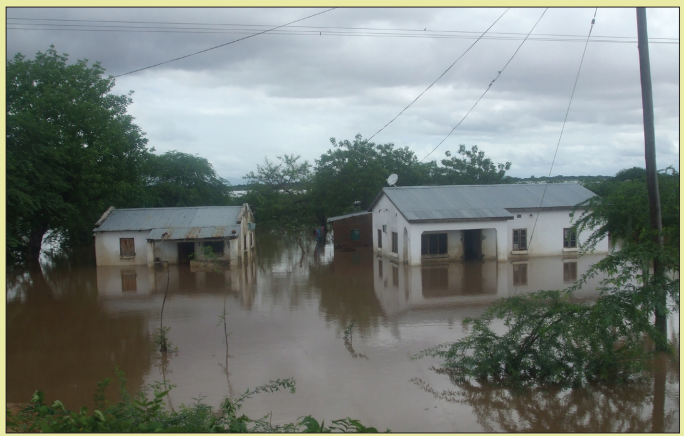
Climate change is intensifying the circulation of water on, above and
below the surface of the Earth — causing drought and floods to be more
frequent, severe and widespread.
Higher temperatures increase the amount of moisture that evaporates
from land and water, leading to drought in many areas. Lands affected
by drought are more vulnerable to flooding once rain falls.
As temperatures rise globally, droughts will become more frequent and
more severe, with potentially devastating consequences for agriculture,
water supply and human health. This phenomenon has already been
observed in some parts of Asia and Africa, where droughts have become
longer and more intense.
Hot temperatures and dry conditions also increase the likelihood of
forest fires.
Climate change will cause storms, hurricanes and tropical storms to become
more intense
Scientific research indicates that climate change will cause hurricanes
and tropical storms to become more intense — lasting longer, unleashing
stronger winds, and causing more damage to coastal ecosystems and
communities.
Scientists point to higher ocean temperatures as the main culprit, since
hurricanes and tropical storms get their energy from warm water. As sea
surface temperatures rise, developing storms will contain more energy.
At the same time, other factors such as rising sea levels, disappearing
wetlands, and increased coastal development threaten to intensify thedamage caused by hurricanes and tropical storms.
Climate Change Impacts: Heat-Related Illness and Disease
Climate change brings health risks to the world’s most
vulnerable communities.
As temperatures rise, so do the risks of heat-related illness and even
death for the most vulnerable human populations.
In 2003, for example, extreme heat waves caused more than 20,000 deaths
in Europe and more than 1,500 deaths in India. Scientists have linked thedeadly heat waves to climate change and warn of more to come
In addition to heat-related illness, climate change may increase the
spread of infectious diseases, mainly because warmer temperatures
allow disease-carrying insects, animals and microbes to survive in areas
where they were once thwarted by cold weather.
Diseases and pests that were once limited to the tropics — such as
mosquitoes that carry malaria — may find hospitable conditions in new
areas that were once too cold to support them.
The World Health Organisation (WHO) estimates that climate change
may have caused more than 150,000 deaths in the year 2000 alone, withan increase in deaths likely in the future.
Climate Change Impacts: Economic Loss and Damage
Climate change is already affecting economies around the world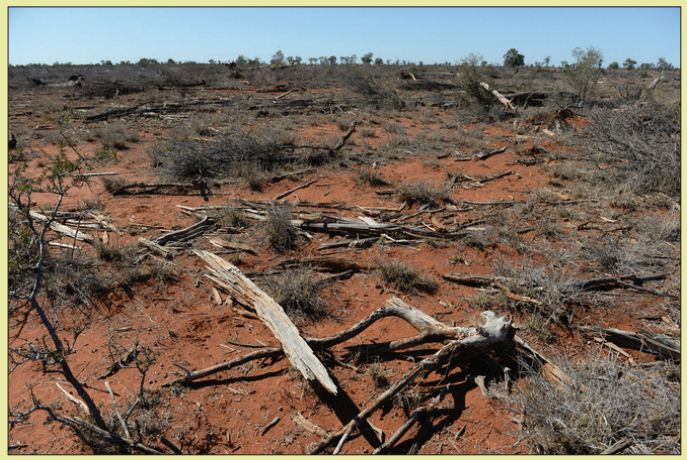
Declining crop yields could put hundreds of thousands of
people at risk for starvation.
Climate change is affecting businesses and economies at home andaround the world.
If action is not taken to curb global carbon emissions, climate change
could cost between 5 and 20 percent of the annual global gross domestic
product, according to a British government report. In comparison, it
would take 1 percent of GDP to lessen the most damaging effects of
climate change, the report says.
These global costs will be felt by local communities and businesses:
• In southern New England lobster catches have plummeted because
of heat stresses and growing parasite threats due to rising sea
temperatures.
• Ski resorts located at the lower altitudes of the Swiss Alps have
difficulty obtaining bank loans because of declining snow.
• In Lake Erie, climate change may significantly lower lake levels,
altering shoreline habitats and costing millions for the relocation
of ports and shore infrastructure.
Globally, more intense hurricanes and downpours could cause billions of
dollars in damage to property and infrastructure. Declining crop yields
due to prolonged drought and high temperatures, especially in Africa,
could put hundreds of thousands of people at risk of starvation.
High sea temperatures also threaten the survival of coral reefs, whichgenerate an estimated $375 billion per year in goods and services.
Model auxiliary verbs
Using: May, could, might
Activity 3
Identify and write modal sentences from the passage predicting what the
future will be like if climate change persists. Compare your sentences
with other classmates.
For exampleIt could be more difficult to grow crops. There might be more droughts.
Describing change in wildlife populations
Activity 1
Discuss this question
If animals migrate to other areas because of climate change, either hot
or cold conditions in which they have not lived before, how does thissituation affect us as human beings?
Listening practice
Activity 2
(Text books closed) Your teacher will read a passage.
Express your opinions and answer the questions that follow.
One-fourth of the Earth’s species could be headed for extinction by 2050
due to climate change.
Rising temperatures are changing weather and vegetation patterns
across the globe, forcing animal species to migrate to new, cooler areas
in order to survive.
The rapid nature of climate change is likely to exceed the ability of many
species to migrate or adjust. Experts predict that one-fourth of the
Earth’s species will be headed for extinction by 2050 if the warming
trend continues at its current rate.
Today, animals are fleeing global warming much faster than they were
less than a decade ago. A study found about 2,000 species are moving
north at a rate of more than 15 feet a day. Climate change appears to
be forcing many of the world’s creatures to migrate to more favourable
locales up to three times faster than previously believed, a study saidon Thursday
Climate Change Impacts: Wildlife at Risk
Extinction of animal species caused by high temperatures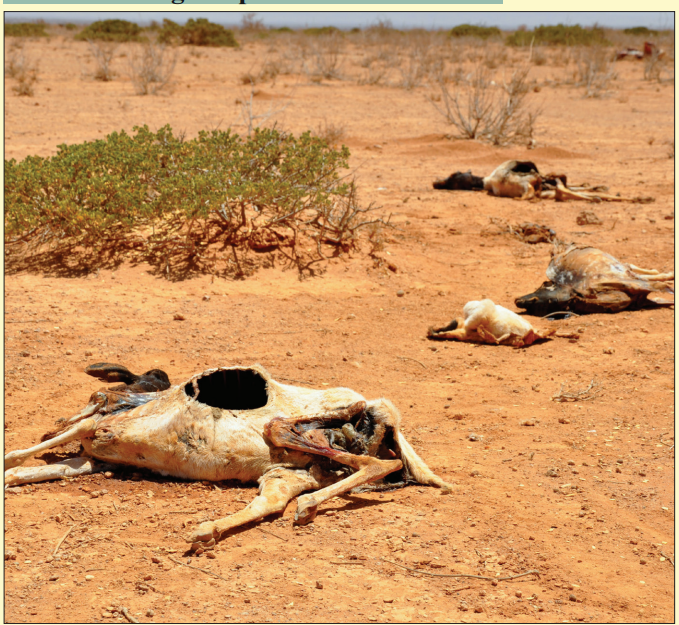
Researchers compiled past studies on species migration and combined
them into a meta-analysis that showed a clear trend towards cooler
climates, with the fastest moves in places where heating was most
intense. “These changes are equivalent to animals and plants shifting
away from the equator at around 20 centimetres per hour, for every hour
of the day, for every day of the year,” said project leader Chris Thomas,
biology professor at the University of York.
“This has been going on for the last 40 years and is set to continue for
at least the rest of this century.”
The study, which appears in the journal Science, was described by York
ecology professor and co-author Jane Hill as “a summary of the state
of world knowledge about how the ranges of species are responding toclimate change”.
“Our analysis shows that rates of response to climate change are two or
three times faster than previously realised,” she said.
The data came from studies of birds, mammals, reptiles, insects, spiders
and plants in Europe, North America, Chile, Malaysia, and South Africa’s
Marion Island.
By grouping the studies together and analysing their results, researchers
found for the first time a link between how hot it was getting and where
organisms were moving.
“This research shows that it is global warming that is causing species
to move towards the poles and to higher elevations,” said lead author
I-Ching Chen, now a researcher at the Academia Sinica in Taiwan.
“We have for the first time shown that the amount by which the
distributions of species have changed is correlated with the amount the
climate has changed in that region.”
Previous studies have suggested that some species are at risk of extinction
due to their change in habitat, but this study did not delve into which
species might be most in peril.
Instead, researchers said they hoped the analysis would give a more
accurate picture of the changes going on across the planet.
“Realisation of how fast species are moving because of climate change
indicates that many species may indeed be heading rapidly towards
extinction, where climatic conditions are deteriorating,” said Thomas.
“On the other hand, other species are moving to new areas where the
climate has become suitable; so there will be some winners as well asmany losers.”
Exercise
Answer these questions about the passage you have listened to.
1. Explain the effects of rising temperatures on animal species.
2. What will happen to most of the Earth’s species by the year 2050
if the warming trend continues?
3. Suggest mitigation measures to reduce the problem in question 3.
4. Compare the mobility levels of animal species today with a decade
ago. Why has this sudden change in the mobility trend happened?
5. Describe the results of research findings scientists found by
grouping the studies together and analysing their data.
6. Account for the risk to extinction of some species according toprevious studies.
Activity 3
Discussion
1. Choose a secretary to report your findings about the question
below to the class.
2. As a learner concerned about environmental and natural resources
conservation in Rwanda, suggest solutions which you think
can avert the concerns described in the passage you listened to.Compare your findings with other members.
Activity 4Vocabulary study
(a) Now open your textbooks. Identify the words in the box belowfrom the passage.
(b) Read the sentences in which they are used.
(c) Share their meanings with a classmate.
(d) Form your own sentences using each word to show that you haveunderstood their meanings.
Present perfect continuous
Activity 1
Work with a classmate
Look at this statement taken from the passage you listened to. Explain
the time the action is being performed.
“This has been going on for the last 40 years and is set to continue
for at least the rest of this century.”In turns discuss its meaning with a classmate.
Activity 2
Read
Read these sentences taken from the reading passage and re-write them
using the present perfect continuous tense as in the example above. Please
do not change their meaning. Compare your answers with other classmates.
1. One-fourth of the Earth’s species could be headed for extinction
due to climate change.
2. Rising temperatures are changing weather and vegetation patterns
across the globe, forcing animal species to migrate to new, cooler
areas in order to survive.
3. Experts predict that one-fourth of the Earth’s species will be
headed for extinction by 2050 if the warming trend continues at
its current rate.
4. Today, animals are fleeing global warming much faster than they
were less than a decade ago.
5. Climate change appears to be forcing many of the world’s creatures
to migrate to more favourable locales up to three times faster than
previously believed, a study said Thursday.
6. Researchers compiled past studies on species migration and
combined them into a meta-analysis that showed a clear trend
towards cooler climates, with the fastest moves in places where
heating was most intense.
7. These changes are equivalent to animals and plants shifting away
from the equator at around 20 centimetres per hour, for every hour
of the day, for every day of the year.
8. Our analysis shows that rates of response to climate change are
two or three times faster than previously realised.
9. Previous studies have suggested that some species are at risk of
extinction due to their change in habitat, but this study did not
delve into which species might be most in peril.
10. Species are moving to new areas where the climate has becomesuitable.
Describing causes
Activity 1
Composition
Use some of the information provided in the passages you read in this unit
to write a descriptive composition about the causes of climate change.
Your composition should not be less than 500 words.
Remember to give a title to your composition, develop the body and
conclude it. Please observe the paragraph structures whenever you are
introducing a new idea
Describing contrast
Using ‘although’, ‘despite’, ‘in spite of’
Read these sentences carefully and discuss their meaning with a
partner.
a) Although species are declining, the gorilla population is increasing.
b) The snow on Kilimanjaro has recently increased despite the global
increase in temperature.
Activity 1
Rewrite the same sentences using:
(a) Despite(b) In spite of
Activity 2
Matching beginnings and endings
Rewrite the following sentences as instructed withoutchanging their meaning.
1. The climate change is already beginning to transform life on
earth, but if we are cautious in our activities, we can reverse the
situation. (use: ‘although’)
2. Seasons are shifting and temperatures are increasing, but if
industries stop polluting the air, gradually normal temperature
conditions can be realised. (Begin: Despite…………)
3. We depend on forests for survival, but we use them faster than we
replace them. (Use: In spite of …………).
4. Industrialists are always warned about the dangers of dumping
refuse in our water sources, but some do not listen. (Start:
Despite………………..)
5. Scientists have warned that we shall all perish from the
surface of the Earth. Some people do not listen to them.
(Begin: Although…………………)
6. The vegetation cover continues disappearing and animals dying.
Poachers continue to kill game or wildlife. (Use ‘despite’)
7. We try our best to plant some trees, but temperatures continue
rising! (Use ‘in spite’)
8. Rising temperatures are changing weather and vegetation
patterns across the globe. Some animals adapt to the new climate
conditions. (Use ‘although’)
9. Although some species have compeletely perished, …………….
(Complete the sentence)
10. …………………….despite the fact that sea levels have risen.
(Complete the sentence).
11. There is lots of drought and floods, but the people somehow
manage to survive. (Use ‘although’)
12. There is little rainfall. We plant drought resistant crops.
(Join the sentences in to one using ‘despite’)
13. We have witnessed minimal temperature changes. This does not
guarantee that we could be affected by drought related illnesses.
(Begin: In spite………..)
14. Scientific research indicates that climate change will cause
hurricanes and tropical storms to become more intense, but we
should stay in our communities. (Use ‘despite’)
15. Extreme heat waves caused more than 20,000 deaths in Europe and
more than 1,500 deaths in India. Surprisingly, people still pollutethe enviroment. (Use ‘Athough …………………)
Activity 3 16.
Form five sentences using ‘although’, despite’, and ‘in spite of’ aboutclimate change. Compare your sentences with those of other classmates.
Describing wildlife protection
Activity 1
Research and report writing
Visit any Non-government Organisation or governmental body concerned
with protecting our environment. Inquire for information regarding the
steps the government is taking to conserve our environment. Write down
notes and then present a full report on your research. Compare your
reports with those of your classmates. For guidelines on how to write
a report, refer to your General Studies and Communication Skills Text
Book, Unit 9: Writing Official Documents and Mass Media for SeniorFive by Fountain Publishers.
Making suggestions about preserving the
environment
Using ‘must’, ‘ought’
Activity 1
Discussion
Discuss the measures that we should take in order to preserve our
environment. Write sentences about those measures using ‘must’ and
‘ought’. Compare your answers with those of other groups.
For example
We must use bicycles more instead of cars.
We ought to use fewer fossil fuels.UNIT:Traditional Family Life
Introductory activity: Read the following text and answer
questions below:
Health dietWhat is a healthy diet?
Eating a healthy diet is not about strict limitations, staying unrealistically
thin, or depriving yourself of the foods you love. Rather, it’s about
feeling great, having more energy, improving your health, and boosting
your mood.
Healthy eating doesn’t have to be overly complicated. If you feel
overwhelmed by all the conflicting nutrition and diet advice out there,
you’re not alone. It seems that for every expert who tells you a certain
food is good for you, you’ll find another saying exactly the opposite. The
truth is that while some specific foods or nutrients have been shown to
have a beneficial effect on mood, it’s your overall dietary pattern that is
most important. The cornerstone of a healthy diet should be to replaceprocessed food with real food whenever possible.
Eating food that is as close as possible to the way nature made it can make
a huge difference to the way you think, look, and feel.
The fundamentals of healthy eating
While some extreme diets may suggest otherwise, we all need a balance
of protein, fat, carbohydrates, fiber, vitamins, and minerals in our diets
to sustain a healthy body. You don’t need to eliminate certain categories
of food from your diet, but rather select the healthiest options from each
category.
Protein gives you the energy to get up and go—and keep going—while
also supporting mood and cognitive function. Too much protein can be
harmful to people with kidney disease, but the latest research suggests
that many of us need more high-quality protein, especially as we age.
That doesn’t mean you have to eat more animal products—a variety of
plant-based sources of protein each day can ensure your body gets all the
essential protein it needs. Most animal sources of protein, such as meat,
poultry, fish, eggs, and dairy, deliver all the amino acids your body needs,
while plant-based protein sources such as grains, beans, vegetables, and
nuts often lack one or more of the essential amino acids.
Fat. Not all fat is the same. While bad fats can wreck your diet and increase
your risk of certain diseases, good fats protect your brain and heart. In fact,
healthy fats—such as omega-3s—are vital to your physical and emotional
health. Including more healthy fat in your diet can help improve your
mood, boost your well-being, and even trim your waistline.
What are dietary fats?
Fat is a type of nutrient, and just like protein and carbohydrates, your body
needs some fat for energy, to absorb vitamins, and to protect your heart and
brain health. For years we’ve been told that eating fat will add inches to
your waistline, raise cholesterol, and cause a myriad of health problems.
But now we know that not all fat is the same.
“Bad” fats, such as artificial trans fats and saturated fats, are guilty of
the unhealthy things all fats have been blamed for—weight gain, clogged
arteries, an increased risk of certain diseases, and so forth. But “good” fatssuch as unsaturated fats and omega-3 fatty acids have the opposite effect.
In fact, healthy fats play a huge role in helping you manage your moods, stay
on top of your mental game, fight fatigue, and even control your weight.
NB: Saturated fat occurs naturally in red meat and dairy products. It’s also
found in baked goods and fried foods. Trans fat occurs naturally in small
amounts in red meat and dairy products. Trans fat can also be manufactured
by adding hydrogen to vegetable oil.
Dietary fat and cholesterol
Dietary fat plays a major role in your cholesterol levels. Cholesterol is a
fatty, wax-like substance that your body needs to function properly. In and
of itself, cholesterol isn’t bad. But when you get too much of it, it can have
a negative impact on your health. As with dietary fat, there are good and
bad types of cholesterol.
• High-Density Lipoprotein (HDL) cholesterol is the “good” kind of
cholesterol found in your blood.
• Low-Density Lipoprotein (LDL) cholesterol is the “bad” kind.
• The key is to keep LDL levels low and HDL high, which may protect
against heart disease and stroke.
• Conversely, high levels of LDL cholesterol can clog arteries and low
HDL can be a marker for increased cardiovascular risk.
Rather than the amount of cholesterol you eat, the biggest influence on your
cholesterol levels is the type of fats you consume. So instead of counting
cholesterol, it’s important to focus on replacing bad fats with good fats.
Healthy or “good” fats
Monounsaturated fats and polyunsaturated fats are known as the
“good fats” because they are good for your heart, your cholesterol, and
your overall health. These fats can help to:
• Lower the risk of heart disease and stroke.
• Lower bad LDL cholesterol levels, while increasing good HDL.
• Prevent abnormal heart rhythms.
• Lower triglycerides associated with heart disease and fight
inflammation.
• Lower blood pressure.
• Prevent atherosclerosis (hardening and narrowing of the arteries).
Adding more of these healthy fats to your diet may also help to make
you feel more satisfied after a meal, reducing hunger and thus promoting
weight loss.
Monounsaturated fat – good sources include:
• Olive, canola, peanut, and sesame oils
• Avocados
• Olives
• Nuts (almonds, peanuts, macadamia, hazelnuts, pecans, cashews)
• Peanut butter
Polyunsaturated fat – good sources include:
• Sunflower, sesame, and pumpkin seeds
• Flaxseed
• Walnuts
• Fatty fish (salmon, tuna, mackerel, herring, trout, sardines) and fish oil
• Soybean and safflower oil
• Soymilk
• Tofu
Unhealthy or “bad” fats
Trans fat. Small amounts of naturally occurring trans fats can be found
in meat and dairy products but it’s artificial trans fats that are considered
dangerous. This is the worst type of fat since it not only raises bad LDL
cholesterol but also lowers good HDL levels. Artificial trans fats can also
create inflammation, which is linked to heart disease, stroke, and other
chronic conditions and contributes to insulin resistance, which increases
your risk of developing Type 2 diabetes.
Trans fat – primary sources include:
• Commercially-baked pastries, cookies, doughnuts, muffins, cakes,
pizza dough
• Packaged snack foods (crackers, microwave popcorn, chips)
• Stick margarine, vegetable shortening
• Fried foods (French fries, fried chicken, chicken nuggets, breaded fish)
• Anything containing hydrogenated or partially hydrogenated vegetableoil, even if it claims to be “trans fat-free”
Saturated fat. While not as harmful as trans fat, saturated fat can raise bad
LDL cholesterol and too much can negatively impact heart health, so it’s
best consumed in moderation. While there’s no need to cut out all saturated
fat from your diet, most nutrition experts recommend limiting it to 10% of
your daily calories.
Saturated fat – primary sources include:
• Red meat (beef, lamb, pork)
• Chicken skin
• Whole-fat dairy products (milk, cream, cheese)
• Butter
• Ice cream
• Lard
• Tropical oils such as coconut and palm oil
Fiber. Eating foods high in dietary fiber (grains, fruit, vegetables, nuts,
and beans) can help you stay regular and lower your risk for heart disease,
stroke, and diabetes. It can also improve your skin and even help you to
lose weight. It may even help prevent colon cancer. Many different studies
have highlighted how eating a diet high in fiber can boost your immunesystem and overall health
High-Fiber Foods
What is fiber?
Fiber, also known as roughage, is the part of plant-based foods (grains,
fruits, vegetables, nuts, and beans) that the body can’t break down. It passes
through the body undigested, keeping your digestive system clean and
healthy, easing bowel movements, and flushing cholesterol and harmful
carcinogens out of the body.
Fiber comes in two varieties: insoluble and soluble.
Insoluble fiber does not dissolve in water. It is the bulky fiber that helps
to prevent constipation, and is found in whole grains, wheat cereals, and
vegetables such as carrots, celery, and tomatoes.
Soluble fiber dissolves in water and helps control blood sugar levels and
reduce cholesterol. Good sources include barley, oatmeal, beans, nuts, and
fruits such as apples, berries, citrus fruits, and pears.
Many foods contain both soluble and insoluble fiber. In general, the more
natural and unprocessed the food, the higher it is in fiber. There is no fiber
in meat, dairy, or sugar. Refined or “white” foods, such as white bread,
white rice, and pastries, have had all or most of their fiber removed.
The health benefits of fiber
Digestive health. Dietary fiber normalizes bowel movements by bulking
up stools and making them easier to pass. This can help relieve and prevent
both constipation and diarrhea. Eating plenty of fiber can also reduce
your risk for diverticulitis (inflammation of the intestine), hemorrhoids,
gallstones, kidney stones, and provide some relief for irritable bowel
syndrome (IBS). Some studies have also indicated that a high-fiber diet
may help to lower gastric acid and reduce your risk for gastroesophageal
reflux disorder (GERD) and ulcers.
Diabetes. A diet high in fiber—particularly insoluble fiber from cereals—
can lower your risk for type 2 diabetes. If you already have diabetes, eating
soluble fiber can slow the absorption of sugar and improve your blood
sugar levels.
Cancer. There is some research that suggests eating a high-fiber diet
can help prevent colorectal cancer, although the evidence is not yet
conclusive. Diets rich in high-fiber foods are also linked to a lower risk for
other common digestive system cancers, including stomach, mouth, and
pharynx.
Skin health. When yeast and fungus are excreted through the skin, they
can trigger outbreaks or acne. Eating fiber, especially psyllium husk (a
type of plant seed), can flush toxins out of your body, improving the health
and appearance of your skin.
Heart health. Fiber, particularly soluble fiber, is an important element of
any heart-healthy diet. Eating a diet high in fiber can improve cholesterol
levels by lowering LDL (bad) cholesterol. A high fiber intake can also
reduce your risk for metabolic syndrome, a group of risk factors linked
to coronary heart disease, diabetes, and stroke. Fiber can also help tolower blood pressure, reduce inflammation, improve levels of HDL (good)
cholesterol, and shed excess weight around the abdomen.
Fiber and weight loss
By regulating your blood sugar levels, it can help maintain your body’s fat
burning capacity and avoid insulin spikes that leave you feeling drained
and craving unhealthy foods.
Eating plenty of fiber can move fat through your digestive system at a
faster rate so that less of it can be absorbed.
When you fill up on high-fiber foods such as fruit, you’ll also have more
energy for exercising.
Calcium. As well as leading to osteoporosis, not getting enough calcium in
your diet can also contribute to anxiety, depression, and sleep difficulties.
Whatever your age or gender, it’s vital to include calcium-rich foods in
your diet, limit those that deplete calcium, and get enough magnesium
and vitamins D and K to help calcium do its job. In general rich sources of
magnesium are greens, nuts, seeds, dry beans, whole grains, wheat germ,
wheat and oat bran.
Sources of calcium:
• milk, cheese and other dairy foods.
• green leafy vegetables – such as curly kale, okra but not spinach
(spinach does contain high levels of calcium but the body cannot
digest it all)
• soya drinks with added calcium.
• bread and anything made with fortified flour.
lcium is a key nutrient that many of us overlook in our diets. Almost
every cell in the body uses calcium in some way, including the nervous
system, muscles, and heart. Your body uses calcium to build healthy
bones and teeth, keep them strong as you age, send messages through the
nervous system, help your blood clot, your muscles contract, and regulate
the heart’s rhythm.
If you don’t get enough calcium in your diet, your body will take it from
your bones to ensure normal cell function, which can lead to weakened
bones or osteoporosis. Calcium deficiency can contribute to mood problems
such as irritability, anxiety, depression, and difficulty sleeping.
Despite these vital functions, many of us are confused about calcium and
how to best protect our bones and overall health. How much calcium
should you get? Where should you get it? And what’s the deal with vitamin
D, magnesium, and other nutrients that help calcium do its job? This
confusion means that many of us are not getting the recommended daily
amount of calcium and approximately one in two women (and about one in
four men) over the age of 50 will break a bone due to osteoporosis.
Getting enough calcium in your diet is not just important for older people.
It’s also vital for children, teens, and young adults since we continue
building bone mass into our mid-20s. From then on, we can lose bone
mass without sufficient calcium in our diets.
The calcium and osteoporosis connection
Osteoporosis is a “silent” disease characterized by loss of bone mass.
Due to weakened bones, fractures become commonplace, which leads to
serious health risks. People with osteoporosis often don’t recover after a
fall and it is the second most common cause of death in women, mostly
those aged 60 and older. Men are also at risk of developing osteoporosis,
but typically 5 to 10 years later than women. For most people, osteoporosis
is preventable, and getting enough calcium in your diet is the first place to
start.
Carbohydrates are one of your body’s main sources of energy. But most
should come from complex, unrefined carbs (vegetables, whole grains,
fruit) rather than sugars and refined carbs. Cutting back on white bread,
pastries, starches, and sugar can prevent rapid spikes in blood sugar,
fluctuations in mood and energy, and a build-up of fat, especially around
your waistline.Adapted from https://www.helpguide.org/articles/healthy-eating/healthy
eating.htm retrieved on 8th September 2021.
Comprehension questions
1. What do you understand by “eating a healthy diet”?
2. Identify different types of nutrients found in various food types.
3. What are the fundamentals of healthy eating?
4. Explain the difference between good and bad fat; good and badcholesterol.
Vocabulary practice
Use each of the following words in your own sentence.
1. depriving
2. boosting
3. overwhelmed
4. cornerstone
5. amino acids
6. artificial trans fats
7. saturated fats
8. triglycerides
9. inflammation
10.atherosclerosis
11.colon cancer
12.bulking up
13.colorectal cancer
14.yeast
15.metabolic syndrome
16.coronary heart disease
17.diabetes
18.stroke
19.osteoporosis20.fluctuations
Application
Debate on the following motion:Only rich people can eat healthy food.
Describing one’s extended family
Language use
Activity 1
Discussion
Discuss these questions.
1. Share with your group members the people who live in your family.
2. Who is the head of your family and what are his or her roles?3. Do you think living in a family is important? Explain your views.
Listening practice
Activity 2
(Textbook closed)Your teacher will read for you a
passage. Listen carefully and answer the questions that
follow.
The Traditional African Family
The subject of “traditional family patterns in Africa” is so broad that it
cannot be adequately addressed in one chapter. The cultural and physical
diversity added with the dramatic social changes of the last three decades
on the continent makes the family pattern situation so variegated as to
defy any sweeping generalisations. This difficulty in generalisation borne
of diversity was already apparent to many early scholars of the African
traditional family like Mair and Goode.
Perversity of Polygamy
Scholars of the African traditional family agree that the one widely
known aspect that distinguishes the African traditional family, say from
the European one, is the perversity of polygamy. Although polygamy
is the act of an individual being married to more than one spouse at the
same time, the more commonly practised in Africa is polygyny “....
the legal marriage of one man to two or more women concurrently - ispermitted.”
Because of its perversity, the presence and absence of polygyny was
a significant determinant and indicator of the nature of virtually every
African social group; whether tribe, clan, or extended family, whether
matrilineality or patrilineality was practised, bride price existed, and
how children were raised.
Polygyny was widely practised in Africa and it often formed the
backbone of the traditional African family patterns. According to Mair,
“....the polygynous joint family, consisting of a man, his wives, and their
children, is the ideal for most Africans.”
In spite of the perversity of polygyny, there was evidence that it was
on the decline. The major reason cited is that with increasing modern
influences, marrying more than one wife became an economic burden.
Even traditionally, ordinary citizens could not achieve marrying more
than one wife. Often only Kings, chiefs and men who had wealth could
afford it. Polygyny though set the tone and often determined the strength
of the society and pattern of social organisation of the traditional African
family. The Baganda people of Uganda provide the best illustration.
In the late and early 19th century, a detailed study conducted among
the Baganda found that, “Polygyny, the type of marriage in which the
husband has plural wives, is not only the preferred but the dominant form
of marriage for the Baganda.” Commoners had two or three, chiefs had
dozens, and the Kings had hundreds of wives. What was the structure
of the polygynous family?
Although among the Baganda, the nuclear family of the mother, father,
and their children constitutes the smallest unit of the Baganda kinship
system, the traditional family consists of several nuclear units held
in association by a common father. Because the Baganda people are
patrilineal, the household family also includes other relatives of the
father such as younger unmarried or widowed sisters, aged parents, and
children of the father’s clan sent to be brought up by him. Included in
this same bigger household will be servants, female slaves, and theirchildren.
Having so many people in this household should not be confused with
other types of large families like the joint family, with its several married
brothers and their families living together or the ‘extended’ family,
consisting of a group of married offspring living in one household under
a patriarch or matriarch. The Baganda are also patrilocal. Therefore, the
new families tend to generally live near or with the husband’s parents.Source: MwizengesTembo, PH.D Bridgewater College, Virginia, USA
Activity 3
Answer these questions about the passage you have
listened to.
1. What do you understand by the word ‘variegated’ as used in the
passage in respect to traditional African family systems?
2. How does African traditional family differ from an European one?
3. According to the passage, would you approve of a matrilineal or
patrilineal family? Justify your view.
4. Explain the difference between polygyny and extended family
systems.
5. Account for the decline in the perversity of polygyny.6. Illustrate a typical Baganda household.
Activity 4: Debate
In some African communities, a man leaves his parents’ home and joins
his wife in her home. The woman is the head of the family.
Make research about a Matrilineal Traditional African Family in any
community of your choice. Find out the arrangement of such a family
system. Write short notes about how such a home is managed by the
woman.
Use your notes to debate the motion, “Only men can be the heads offamilies”.
Describing a family tree
Activity 1
Study the family tree below carefully and use it to describe the familymembers who live there
Activity 2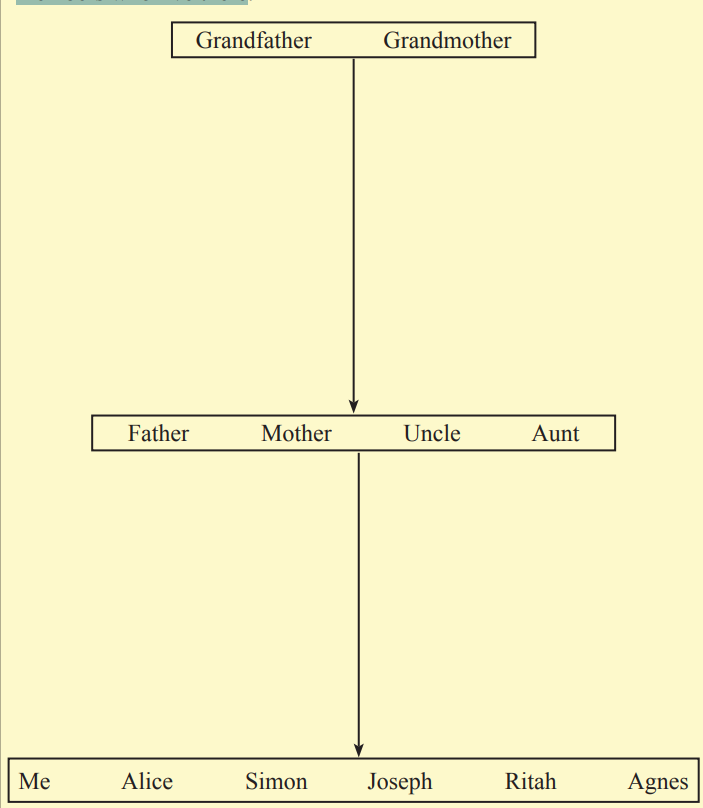
Briefly share these questions
1. How does Alice call Ritah?
2. Which of the family members share the same parents?
3. How will Simon’s children call those of Agnes?
4. Why do you think it is important to know our relatives?
5. Why is it unacceptable for related family members to marry each
other?
Activity 3
Draw the family tree of the members who live in your family. Use the
family tree to write a paragraph describing your family members. Shareyour family tree and description with other classmates
Describing traditional birth customs
Activity 1
Discussion
Share these questions among your fellow members.
1. Why do you think the birth of a child is celebrated in a family
and community?
2. Describe some of the customs and celebrations related to the birthof a child in your community.
Activity 2Carefully read and enjoy the passage below
The birth of a child is often welcomed with joy and jubilation. In the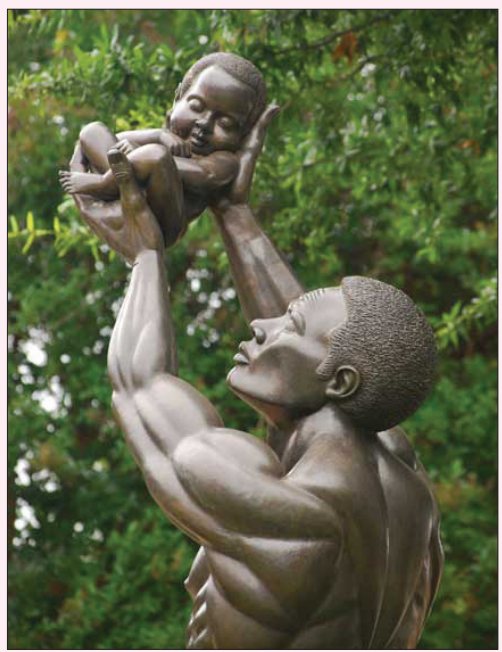
past, Rwandan parents looked forward to having a child, especially a boy,
to inherit the father’s position and property. This is no longer the case
today, because a girl child can now inherit property from her parents. To
Rwandans, children, especially the girls, are sources of wealth because
their parents will be given bride-price when they get married. Twins
are often accorded special treatment, and rituals are performed to keep
them alive. It is a common phenomenon in Africa for parents to have
many children, thus making the families generally large. In the past,
there were no established hospitals or maternity centres where womencould give birth.
Thus, children were born at home with the assistance of neighbours or
local midwives. Shortly after birth, the baby is given a thorough bath
with cold water, and a magical lotion is applied to protect the child from
evil forces.
For the first seven days after a baby is born, the mother and infant
remain in the house, attended to by family members. This is a period
of seclusion, meant for resting and recovering for the mother. It is also
a time of acclimatising the baby to the new environment. During this
period, relatives and friends give presents to the parents and the baby.
Fragile and helpless, the infant is susceptible to disease and illness.
Therefore, every precaution is taken to ensure that the baby is in good
hands. The baby sleeps in the same bed with the mother.
As in many African societies such as that of the Yoruba, names are given
to the baby on the eighth day. Names are important to the individual
and family as a mark of identity and also reflect the people’s cultural
beliefs and practices. The naming ceremony is a special and elaborate
social occasion for the family and the clan. In some societies, the clan
or lineage head provides personal names for the baby. The names may
reflect significant life experiences of the parents or the circumstances
under which the baby was born. Names in African cultures and customs
always carry specific meanings.
In Rwanda, the naming ceremony takes place outdoors in the evening
of the eighth day when family members and friends gather together to
celebrate.
The process begins with bringing the baby out into the public for the
first time. The parents present the baby to those present for the naming
ceremony. Because the mother and the baby have been in seclusion,
this is the first time the baby appears in public. Although the naming
ceremony is a social event, it also provides the opportunity for familyreunions.
Food and drinks are prepared by the relatives and all the village children
from three to ten years are invited to the naming ceremonies. They are
given a piece of land to cultivate. They use sticks that have the shape
of a hoe. After a few minutes, a male adult stops the farming activities
by throwing water on them. They immediately run home because it is
supposed to be raining. When they get home, they eat while the adults
are watching them. When they have finished, they are each asked to
give two names to the baby. All this is only ceremonial since none of
these names is considered in the final name choice. After everybody has
left, the mother gives names to the baby also, but as in the case of the
children, her names are not official either. The father is the last one to
give the names. He can do it just after the mother has finished, or he can
wait for early next morning to name the child. The father may select a
name from either the list provided by the young guests or the mother or
even give his own. There are no family names. He may select the nameof a grandfather, great grandfather, a nationalist or hero.
Exercise
Answer these questions about the passage you have read
1. Explain why in traditional Rwanda, the birth of a baby boy was
welcomed with great joy. Has the tradition changed in your
community? Is the birth of a girl child celebrated with similar
anxiety as that of a boy?
2. Compare the benefits of having a girl child and a boy child in
traditional Rwanda.
3. Describe the cultural rituals that were performed when twins were
born.
4. What was the use of the magical potion?
5. Explain the relevance of putting the mother and baby under seclusion.
6. Describe the role of children during the naming of a child.
7. How does the naming ceremony promote a platform for family
reunions?
8. What do you think is the relevance of inviting children to dine atthe new child’s parents’ home?
Describing death customs
Activity 1
Research
Carry out research about the customs related to death in your community.
What takes place when someone dies? What are the roles of the men,
women and children during this sad moment? Who says the traditional
prayers? Do people mourn? What happens during the burial? How is the
deceased buried? What happens after? Is the heir installed immediately?
Present your research in the form of an essay or a composition. Try to
make your composition interesting following the rubric of compositionwriting. You may share your compositions with other classmates.
Describing a traditional wedding
Activity 1
Discussion
1. Share these questions among yourselves:
(a) Have you ever attended a traditional wedding? Describe
what takes place among your groups.
(b) Do you think traditional ceremonies like weddings are
important in this modern era? Explain your opinion.
(c) Study the photographs in this text before reading and use
them to explain how traditional weddings are carried outin Rwanda.
Activity 2
Carefully read and enjoy the passage
A Traditional Rwandan Wedding
Marriage has always been a very important cultural institution in
Rwanda. Prior to and after the wedding ceremony there are a number
of traditional practices that take place. The nature of these practices has
changed over time, with several ceremonies being combined to take
place over a shorter period. However, many elements remain as they
were hundreds of years ago.
Many couples began with a relative of a bachelor pointing out a young
lady as a potential bride for him. The bachelor’s family would then
select a man as their representative who would act as the go-between
for their family and that of the bride to be. His role included intensive
research on the lady, including her ancestry as well as the conduct of
her relatives in society.
Following the research, the father of the potential groom, or a special
envoy selected by the family, would visit the girl’s father to declare the
intention of his son to marry their daughter. If the girl’s father accepted,
arrangements would be made as to when the introduction ceremony
would take place.
Next would be the ceremony where the representative of the bachelor’s
family officially requests the daughter as a bride. The ceremony is a battle
of wits often involving traditional tongue-twisters as well as riddles and
pranks from the girl’s side.
The family of the would-be bride, as well as the people of her
neighbourhood, were all consulted because the welfare of children isthe responsibility of the community even when they get married.
This was followed by the payment of the bride price. The bride price was
always strictly a cow, or several cows. Once the negotiations were over,
the bride’s side would invite the groom’s side to share a drink. Then,
before the groom’s side left, they would often be given a drink which
they were to enjoy on their journey home. In modern times, if one side
has travelled a great distance they may even be invited to share a meal
together with their future in-laws before they return home.
After the payment of bride price the families would meet again to discuss
the date of the wedding. In modern times, this is often done privately
between the bride, groom and their immediate families without involving
many parties.
Traditionally, before her wedding day, a bride would spend several weeks
in seclusion being cared for by one of her aunts. During this time her
aunt would give her advice on how to take care of her future family.
The bride would also undergo intensive beauty treatments, including
daily applications of perfumed cow-ghee with special herbs to give
her softer and smoother skin. She would also adhere to a diet regime
reserved for brides.
On the day of the wedding, the bride would be seated in a traditional carrier.
It would have two handles which would be placed on the shoulders of
four strong men who would carry her to the groom. After arriving at her
groom’s home, she would be taken inside and a special banquet in honour
of both the bride and groom would be held. The banquet would include
traditional Kinyarwanda dancing and singing.
The final ceremony involved the wife’s family visiting her at her new
home and bringing a number of items to help her settle in. Prior to this,
the wife would not have been seen in public and would have completely
refrained from any work. In this ceremony, the wife would make a meal
for her family and in-laws for the first time.
At the end of any visit, the visitors would be given a drink to take before
going back to their home.
The wife’s family would then journey home and the young couple would
begin their new life together.
(Source: Akaliza Keza Gar
Exercise
Answer these questions about the passage you have read
1. Do you support the view that “marriage is an important cultural
institution in Rwanda?” Explain your opinion.
2. Explain the role of the family representative on the bachelor’s side.
3. What do you think was the importance of paying bride price?
4. Why was a bride given special care by her aunt before the wedding
day?
5. Describe the wedding cultural practices that are still respected intoday’s modern wedding and justify their relevancy
Activity 3
Debate
Some people say that bride price should be abolished. Proponents of
this argument have looked at today’s modern woman as empowered
economically, politically and socially. What is your view?“Should bride price be abolished or not?” Express your opinions.
Talking about modern weddings
Activity 1
Discussion
Share with your fellow members a modern wedding you have ever
attended.
(a) Compare the clothes the couples put on, the food, drinks,
music and other articles with the ones of a traditional wedding
(b) What do you know about a civil or religious wedding in
Rwanda?
(c) Look at the photograph and use it to describe what takesplace during a modern wedding.
Activity 2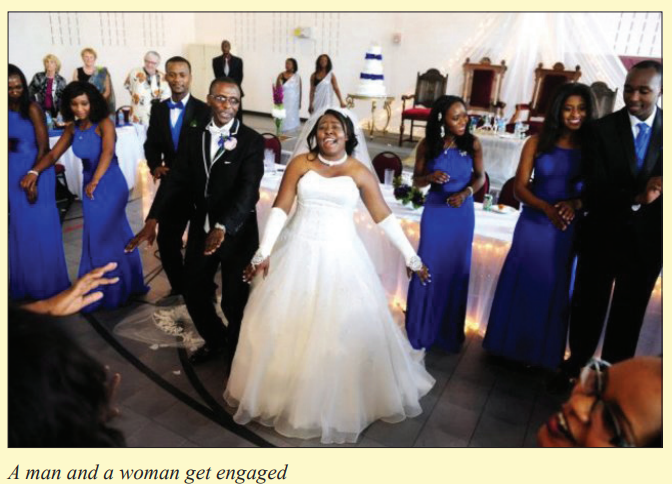
Read and enjoy the passage below
Rwandan weddings
Besides the day-to-day running of the shop, we’ve wanted to share
more about what makes Rwanda special, and what we’ve all been up
to outside of work as well as in it. Nothing comes any bigger than the
recent engagement of our assistant manager, Claire, which she wantedto share with all of you.
Most couples around the world have a single ceremony when they want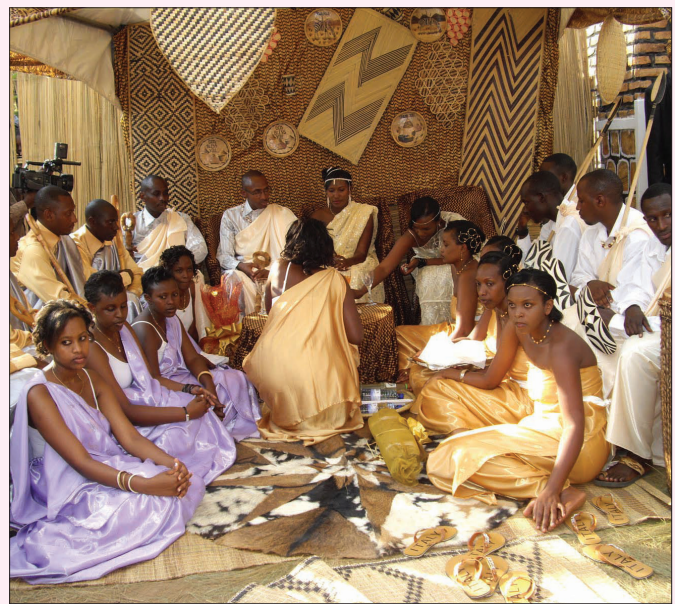
to marry. Not in Rwanda! Here people can have three: the traditional
engagement ceremony, a civil wedding (no wedding here is legal without
one) and a church ceremony. Years of planning and saving typically go
into all of this.
The bride price giving, or traditional engagement ceremony, used to be
the exclusive way Rwandans married. At its core, it is where the parents
officially acknowledge the couple and their wish to live together. Today,
it’s the first of the wedding events that take place over the course of a
month.
The bride’s house is set up with three tents in a U shape: one rectangular
one for the bride’s family, a second tent facing it for the groom’s family
and a smaller third one in between for the couple and their friends. Mostof the day’s activities take place in the centre of the U
First, the bride’s family and friends arrive to take their seats. It’s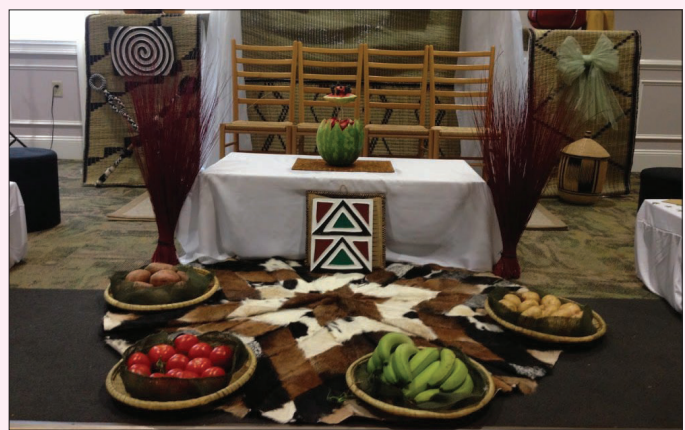
important for her guests to be more numerous than his, because she is
the host of the event. When all of her guests arrive, the groom comes
with all of his guests (family and friends – usually on a bus or two!).They bring gifts of beverages (soft drinks and alcohol) in large baskets.
Each family has a representative who speaks on their behalf, usually a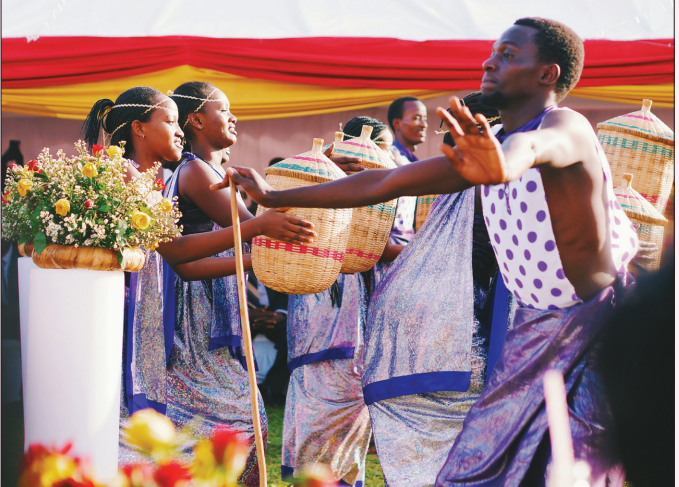
wise old man. They begin by praying and then by welcoming each other,
giving everyone a place to sit, drinks and making them comfortable. The
groom’s representative gives thanks and eventually gets to the matter of
their son being in love with a girl, which is when a sort of comedic duel
ensues. In fun, each representative tries to trick the other, a sort of test to
see if the couple will be well matched. The representatives discuss the
bride wealth of cows, symbols both of something to replace the loss of
a beloved daughter as well as the mixing of the families through their
herds (cows are very special in Rwanda). Poets come and sing of how
beautiful and special the cows for bride wealth are.
Finally, the bride is able to come out with her entourage, generally four
male guards, a girlfriend who is a mother, four other girlfriends and
two young girls.
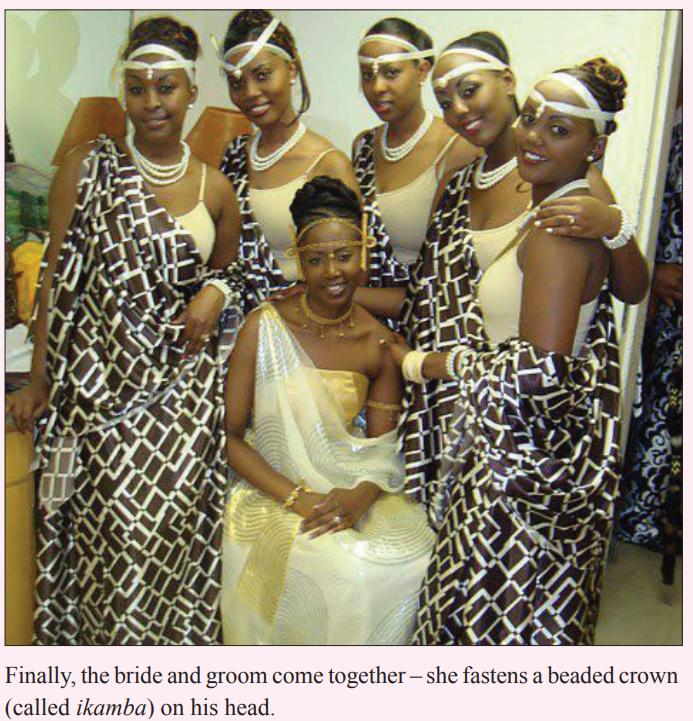
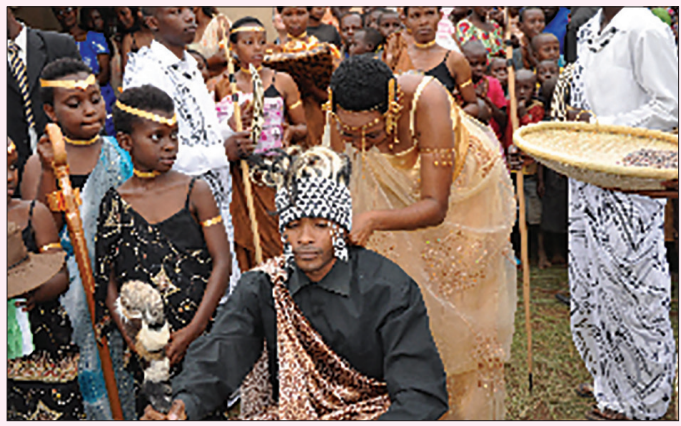
Once the bride and groom have introduced each other to their families,
the festivities can really begin with drumming and dancing. Luckily
for us, entertainment for this event was provided by Ingoma Nshya, the
famous all-women drumming group that created the Inzozi Nziza project!
This wedding was already special, but the bride being a drummer meantthat she was whisked up front to join in the music!
After the bride and groom have served food and drinks to each other in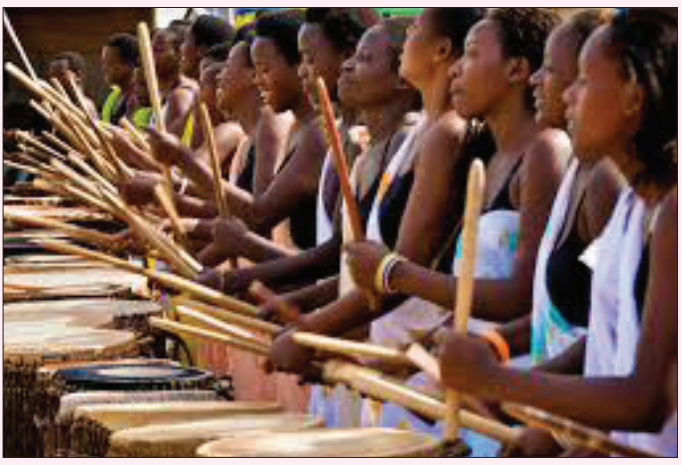
front of all, things calm down a bit and dinner is served to all guests.
There’s more music until the couple and attendants go inside to drink
milk and receive guests individually. All in all, a Rwandan wedding is
an experience not to be missed.
A word about the traditional costume
The bride and groom wear the costume pictured here exclusively for
weddings. The headband and beaded “sticks” worn on a lady’s head isa Rwandan-style crow
Exercise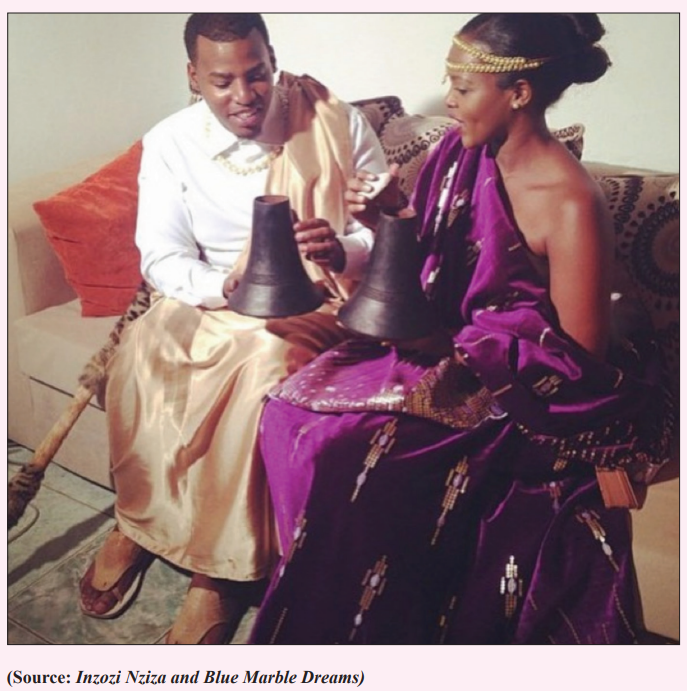
Answer the questions based on the passage you have read
1. Explain how each of the ceremonies contributes to a modern
Rwandan wedding.
2. Why is it relevant for the bride’s family to have many guests?
3. Explain the role of spokesmen and how they go about their duties
during a modern Rwandan wedding.
4. Weigh the symbolic meaning of cows as bride wealth.
5. Are there any similarities and differences you have noticed abouta traditional and modern Rwandan wedding? What are they?
Recounting a wedding
Activity 1
Composition
Describe elaborately in writing a wedding you have ever attended. Give
details of activities that made the wedding colourful.
Sentence connectors
Sentence connectors just like the phrase sounds, are words or a group of
words used to join or connect sentences to clarify the sentence and make
it meaningful. Sentence connectors are typically used in compound or
compound complex sentences.
Activity 2
Gap filling
Your teacher will read to you a passage. Fill in the missing sentence
connectors in the blank spaces to complete the paragraph below.
My friend and I were ushered in .................. we sat in the best position;
opposite each other to enable us to see all that was going on, ..................,
heads of the different families, in particular the men, went ahead to
discuss why really their children would get married. Thereafter families
were introduced and in appreciation, there was the exchange of presents
that made them feel at home. At this juncture, the groom was introduced
by the aunt to the congregation which was ............ the giving of bride
price to the girl’s parents. The bride price is in the form of cows .............worth their daughter
Later on, we were surprised by the bride’s procession. She was escorted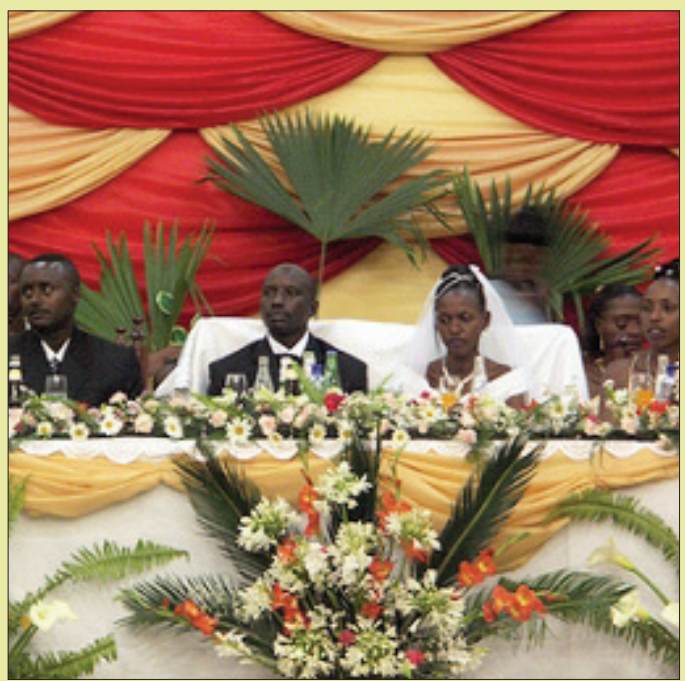
by women both young and old. They came with gourds of milk that were
to be given to the groom’s family .................. were traditional dancers
that made the occasion beautiful. The bride was dressed in beautiful
traditional wear .................. her bridal team that carried the gifts to the
groom’s family. Tradition has it that four spear men have to guard the
bride. After that the bride and groom were ushered into their special
tent .................. that the two were ready to get married in church. A lot
of dancing and eating .................. event till people got tired and went
home. It was such a great event and it’s something I would love to haveon my introduction day.
The bride and the groom feeding the guests from ‘ibyansi’. This activity crowns
the wedding ceremony
Source: Rwanda on line/modern wedding
Activity 3Use the sentence connectors in your own sentences.
Exercise
Answer these questions about the passage you have
filled in and read
1. Describe the materials from which the bride’s traditional wear is
made.
2. If a visitor to Rwanda asked you about a Rwandan wedding, how
would you describe it to him or her?
3. Why do the families sit opposite each other or her?4. Why do you think the groom is introduced to the parents of the bride?
5. Of what significance are the gourds of milk given to the groom’s
family?
6. Why do you think four spear men should guard the bride?
7. Explain the importance of food, drinks and music in a wedding?8. Of what relevance is the church or mosque in a wedding?
Activity 4
Research
Through using the internet or inquiring from your community members,
carry out research about how either a traditional or modern wedding is
conducted in other communities elsewhere in the world, where customs
are different from a typical Rwandan wedding. Describe what takes
place during the ceremony while comparing and contrasting it with the
Rwandan wedding. Share your compositions with other classmates forfurther discussion and comparison of your research findings.
Talking about work distribution in the family
(gender roles)
Activity 1
Discussion
Share your opinions about the following issues.
1. How do you view a woman today?
2. Do you think women enjoyed the same privileges in the past as
they do today?
3. What are some of the roles women play today that they used not
to in the past?Activity 2
Read the passage carefully comparing work distributed
between men and women in the past and today inRwanda
Marriage, Motherhood, and Division of Household Labour
Gender roles in traditional Rwanda were structured around a households
division of labour that allowed women substantial autonomy in their
roles as child-bearers and food producers but preserved male authority
over other family affairs. Because their biological capacity to bear
children and their roles as mothers strongly determined women’s status,
their influence was ultimately captive to cultural interpretations of these
capacities. As a result, Rwandan women navigated a cultural space that
had the potential to both enhance and suppress their power within the
household and family.
Several traditional Rwandan expressions refer to a connection between
women’s leadership and a strong household. Men, however, remained
the ultimate arbiters of most family decisions. As Reseau des Femmes,
a women’s civil society organisation, notes “Rwandan tradition holds
that, as the chief of the household, the man is respected by all members
of the family. Important decisions are therefore made by him, even if
he sometimes consults his wife before making them.”
Importantly, gender roles in the home differed according to the social status
and material wealth of the family. In the words of one older gentleman:
“In the rich homesteads, women reflected high levels of management and
control of family affairs.
Men actually never entered the backyard, and a man who tried to know
what went on there was considered greedy, uncultured, and unmanly.”
The wealthier certain men became, the less time they had to control
family affairs as they sought to demonstrate their allegiance to the king
(or others with political status) in order to secure protection for propertyand the promotion of their own social status.
Thus, their wives had significant autonomy and control over the family
property, household workers, and children.
These women also maintained personal property, such as cows, that they
could use to acquire friends and a loyal, grateful clientele. An expert
noted: “As [they] climbed the social ladder, women’s value increased,
as opposed to women in the lower-class levels.”
In poor families, wives still controlled internal family issues, such as
the use of farm proceeds, but men more closely oversaw and managed
the family property, leaving women with less control over household
decision-making. Men in poor homesteads took part in direct production
of the family’s wealth. While this meant that men assumed more control
over property, it also often resulted in a more equitable division of
household labour, with men going to gardens with their wives, assuming
the most difficult farming roles, and tending livestock.
Traditionally, Rwandan women were not permitted to own land. If a
male head of household died, property passed to male heirs or to the
man’s brothers. In the case of divorce or the husband’s death, a woman
had no claim over the family property if she had not borne children; she
would quietly return to her family of origin or marry into another family.
Women with children were required to marry a brother of the deceased
in order to retain their status as members of their marital family.
Women may have influenced day-to-day decisions regarding the
management of land, but they had little ability to direct larger decisions
regarding the sale or lease of property. Because men were thought to
make occasionally abrupt, irrational decisions, cultural norms urged
men to consult their wives before finalising any sale or gift. One expert
stated, “Women decided who gets a cow from the family. Even giving
cows to children required that the wife be consulted first.
When the family bull was to be given (lent) to a neighbour or friend for
the purpose of mating, the woman had to give her consent first. In the
cultural sense, women were heads of their families.”However, such gestures were more of a formality than requirement; a
woman’s failure to consent to such matters did not prevent a man’s action.
Cultural prohibitions against making family matters public prevented
women from disputing land ownership, a problem which continues today,
despite the 1999 law establishing women’s right to inherit and own land.
Household gender roles also varied by region. Some interviewees
referred to a perception that women in the central and southern parts of
the country were treated with greater gentleness. Women were not meant
to perform hard chores such as building houses or collecting firewood and
water, and they did not work alone in their gardens; rather, they always
worked hand in hand with their husbands, especially in poor households.
Men were responsible for more physically demanding tasks, such as
clearing the bush and the initial tilling of the land, while the women
did the less labour-intensive tasks of planting, weeding, and harvesting
the crops. To some, this protective tendency signifies that women were
treated as the weaker sex and seen as unable to manage hard tasks. But
to others, this division of labour demonstrated respect, and a man whose
wife engaged in hard chores was viewed as an irresponsible husband.
Rwandan culture placed great importance on marriage, and married
women and men were given special respect and recognition in society.
As with other cultural practices, marriage, in some ways, recognised
and respected women’s independence and, in other ways, subordinated
women within a patriarchal system of authority. In the days preceding a
wedding, for instance, aunts and other elderly women counselled a bride
on the duties of marriage. This advice generally focused on the woman’s
responsibility to respect her husband and his family and emphasised her
obligation to be subservient to her husband.
Married women were no longer permitted to act as girls, climbing trees
or milking cows. In the northern region, though, where the bride price
could be exorbitant, a woman was also expected to recover the cost
incurred by her husband in paying her family to legalise a marriage.
The husband provided a combination of sheep, goats, cows, hoes,
pots, local beer, and money; the wife was then expected to labour ascompensation to her husband.
On the other hand, a Rwandan bridegroom was required to leave his
family and live with his bride in her family’s homestead during the first
days of marriage. This practice was intended to help the girl adjust to
her husband before she made the transition to his home and assumed the
responsibilities of wife and mother. It also provided an opportunity for
the bride’s family to evaluate the capacity of their new son-in-law to care
for their daughter. During his stay at the bride’s home, the bride’s family
required the groom to work, take part in all male chores, and display a
high level of discipline. If he did anything considered offensive, he could
lose his wife and be sent home in disgrace. Not much is known about
the frequency with which this practice was employed in pre-colonial
Rwanda, or how often families sent young men home. The stories persist,
however, as cautionary tales.
Social taboos and traditions arose to reinforce respect for motherhood and
to protect women and children from danger or abuse. The word “mother”
also has connotations of “creator” and “life giver”. Her family and in-laws
would pamper and exempt a woman from certain chores during pregnancy
and immediately after delivery of a child.
On some occasions, chiefs would punish men who did not conform
to these expectations. In poor communities, neighbours guaranteed a
steady supply of milk to a woman who delivered a baby. One Rwandan
woman in her sixties described society’s respect for women in this way:
“While traveling with a child, a woman never had to carry milk for the
baby as any home she approached along the way welcomed her and
provided her with milk for the child, and for herself.”
Gender roles in the public sphere
women’s public roles in traditional Rwandan culture perhaps provide
the more relevant context for evaluating the extent to which indigenousgender practices underlie women’s modern political achievements.
As with women’s household roles, however, accounts from interview
participants and available literature present conflicting attitudes
regarding women’s place in traditional politics. In some ways, women’s
leadership and participation in public life were respected and solicited,
but they were often also rejected or feared.
Although Rwandan culture is sometimes celebrated as exceptional
among African cultures for promoting women’s influence in the public
sphere, in many cases women were expected to defer to men or to wield
influence indirectly through their husbands. Traditionally, women did not
speak publicly, especially in the presence of men. A woman who dared
challenge men in public was considered insolent. In interviews, many
elders—who continuously referred to Rwandan traditional culture’s
respect for women—contended that the major limitation on women was
lack of freedom to express themselves in public.
Women were not allowed to participate directly in public deliberations;
rather, they were expected to play an indirect role in the customary system
of justice. Through their personal networks, women would lobby their
husbands and influence court decisions by proxy.
Women’s absence from public proceedings such as traditional court
hearings is evidenced by the local word for witness which translated
literally means “a man”. Only recently did the term for witness change inorder to make it gender-neutral and formally include women witnesses.
Activity 3
Note making and summary
In the table below, write notes comparing the roles of men and women
in traditional and modern Rwanda. Do the work in your exercise book.
Activity 4
Use your notes to write a summary comparing the roles men and women
played in the past with the roles they play today.
“Used to”
Activity 5
Use the notes from your table to write sentences using ‘used to’
comparing the roles of men and women in the past with today’s roles.
For example:
(a) Men used to clear the land.
(b) Women used to stay at home doing household chores.
(c) Now women and men share household roles.
Activity 6
Debate
Do you support the view about the changing roles where women today
are playing roles which were originally played by men? Explain youropinions
UNIT 4:Fractions and Percentages
My goals
After studying this unit, I will be able to:
⦿ Do calculations and percentages, write in numbers and talk through
the working orally.
⦿ Read calculations, or texts on the Rwandan economy.
⦿ Plan, write and evaluate texts on the Rwandan economy.
⦿ Discuss the Rwandan economy, paying attention to percentages.⦿ Appreciate the role of Mathematics and Science in our daily lives.
Calculating with fractions
# Language use: Listening and speaking
Activity 1
Look at the loaf of bread in Fig.1 and the bread cut into slices in Fig.2.Why do you think the loaf of bread is cut into toasts or slices?

On the basis of the photographs answer these questions
1. How many slices make up the whole loaf of bread?
2. Suppose Kaneza eats 9 slices out of 18 slices, describe the bread
she has consumed as a percentage.
3. Suppose a family consumes two-thirds of the bread, describe the
amount of bread that will remain.
4. Express the bread the family has consumed as a percentage.
5. Assuming there were 100 slices and Kaneza ate as much as she
ate out of the 18 slices of bread, find and describe the amount of
bread she would have consumed.
6. Now express the fraction Kaneza would have eaten out of 100 asa percentage
Activity 2
1. Get an orange. Peel it and divide it into 2 equal parts. If you eat a
half, what percentage of an orange would you have eaten?
2. Suppose you divide the orange into 4 equal parts, and you eat one
of them, express the fraction of the orange eaten as a percentage.
3. Assuming you divided the orange into 5 equal parts and you consumed
two-fifths, what percentage of the orange would have remained?
4. Cut the orange into 10 equal parts. Suppose you eat 7 pieces out
of the ten.
(a) What fraction would you have eaten?
(b) What percentage of the orange would remain?
5. If one eats three-quarters of an orange:
(a) Convert and describe what he/she has eaten into a decimal
fraction.
(b) Express and describe what he/she has eaten as a percentage.
6. If Nkurunziza and Mukantamage shared 18 slices of bread.
Nkurunziza got 12
18 and Mukantamage ate a third of Nkurunziza’s.
(a) How many slices did Mukantamage eat?
(b) How many more slices did Nkurunziza eat than Mukantamage?
7. Describe the amount of the bread that was not eaten as a fraction
and as a percentage.
8. Describe the difference between the amount of bread Nkurunzizaand Mukantamage ate as a percentage.
Activity 3
Discussion
Get two oranges, tomatoes, pineapples or any other fruit. Cut the first
one into two equal parts and the second one into four equal parts.
Exercise
Answer these questions and compare your answers.
1. How do we call each of the two equal parts cut from the fruit?
2. How is each part of the four equal parts called?
3. How many quarters make a half?
4. How many quarters are there in three quarters?
5. How many quarters are in two halves?
6. Express the following as decimal fractions.
(a) A quarter
(b) A half
(c) Three quarters
(d) An eighth(e) A third
Application of fractions and percentages in
our daily lives
Activity 1
Discussion
Convert the marks you scored in the end-of-month’s or end-of- term
examinations as fractions. Express the fractions as decimals and describe
them to your class members.
Activity 2School community
1. Count the number of learners in the school and express the number
of girls as a percentage.
2. Express the number of boys as a percentage and a fraction.
3. Express the number of newcomers in the school as a percentage
and a fraction.
4. Express the number of absentees as a percentage and a decimalfraction.
Activity 3
Clinic or hospital
Go to a nearby clinic or hospital. Inquire from the medical staff the
diseases that affect people in the community and their respective specific
numbers.
1. Draw a table to record or represent the data collected. Express the
patients treated per sickness as a percentage as well as a fraction.
2. Use the percentages to determine the common sicknesses in the
area.
3. Identify the diseases which have equivalent numbers of patients.
4. If you are in charge of health in your district, suggest measures
you would recommend for your people to mitigate the common
sicknesses. Present your ideas in an essay or paragraph form.Activity 4
Market or shop
Visit a nearby trading centre. Inquire from the traders about the foodstuffs
which are on high demand and those which aren’t demanded often by
customers. Record the different food items sold in the market or shop
and count the number of traders dealing in each item. Present your datain a table.
Exercise
Answer these questions
1. Express the number of traders per item as a percentage and a
fraction.
2. Compare the items which have an even number of traders with
those which have an odd number of traders.
3. Use the percentages and fractions to determine the commonest
foodstuffs consumed in the community
4. Discuss the reasons why you think these items are on high demand.
5. Supposing you are a trader in that community, what items wouldn’tyou trade in? Give reasons for your opinion
Activity 5
Transport

Visit a busy road. Observe and count the number of vehicles passing
on the road for one hour.
1. Draw a table to record your data.
2. Use the data in the table to express the following in percentages,
fractions and decimal fractions.
bicycles; salon cars; buses; lorry; motorcycles
Assuming you want to invest in transport business, use the data to
describe the type of transport business you would engage in andgive reasons for your choice.
Activity 6
Extend your thinking! GeographyLook at the orange and study the earth in the photographs below.
(a) What relationship do you think exists between the orange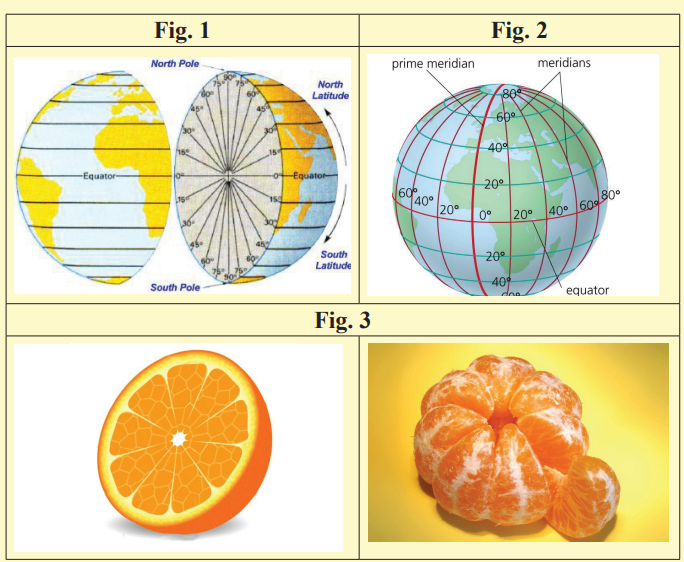
and the globe?
(b) Explain how geographers can use the knowledge of the slices
of the orange and apply it to the globe to locate places on
earth, countries and continents.
(c) Find out how geography use longitudes to measure the time
of a place (time zone). Share your findings with other group
members.
(d) Express and describe the main longitudes and latitudes on
the globe in Fig. 2 as fractions and percentages.
(e) Discuss the main importance of the Equator and Greenwich
to geographers.Activity 7
Research
Visit your population statistics bureau or use its website if your school
has a computer laboratory with internet. Find out how fractions and
percentages are used to describe the population census of Rwanda.Listening practice
Activity 1
Your teacher will read to you a passage about the summary of an
imaginary Rwanda National Budget by the Minister of Finance. Pleaselisten carefully
Activity 2
Gap filling
Use the information you heard from your teacher to complete the passage
below.
Good evening .............. of Rwanda. I am ................... to present the
summary of the national budget allocations. The salary of civil servants
has been increased by .................... The education sector has been
allocated FRW 5 billion. The ................... sector has been allocated
15% more than the education sector. The ICT sector has been allocated
.............. more than the education sector. The tourism sector has been
allocated 5% less than the ................... sector. Security has been allocated
10% more than the education sector.
The industrial sector has been allocated ................... more than the
education sector. Finally, the .......... sector has been allocated 12%
................... than the education sector. This is the final financial
................... from the Ministry of Finance.
With the recent ................... in financial research and credit control
systems, we anticipate the exports to increase by .................... The
national ................... will grow by 3.4% and imports will drop by 0.2%
in the next ................... months. This will account for a steady and
................... economic growth hence controlling inflationary gaps in
the Rwandan economy.I thank you for listening to me.
Activity 3
Use the information above and answer the following
questions.
1. If the salary of a teacher was FRW 150,000 before the reading of
the national budget, what is his or her new salary?
2. Find the sector that was allocated the highest percentage and
explain why you think that sector was given the biggest share of
the national budget allocation.
3. Calculate how much money was allocated to the following sectors:
(a) Agriculture
(b) Security
(c) Tourism
(d) Health
(e) Industry
4. How much more money was allocated to agriculture than the
health sector?
5. What was the national total budget?
6. Express the given decimals in the passage as fractions and
percentages
7. Explain how the relationship between the exports and imports will
account for a steady and sustainable economic growth in Rwanda.
8. Write your own sentences using the following words in the box
below to show that you have understood their meaning.
quarter; fifth; denominator; decimal; percent; divide;
multiply; worth; account for; import; industry; equivalentto; figures
Activity 4
Think of other situations where fractions and percentages can be used
to solve our problems in our daily lives. On the basis of the applications
you have discussed, explain how the concept or idea of fractions and
percentages in Mathematics helps in solving problems in our daily lives.Share your answers with your classmates.
Activity 5
Puzzle
Think about this!
A man has three children. The eldest is 0.5 years of the father’s age.
The last born is 0.4 years of the eldest child’s age. The second born is
twice as old as the last born.
1. Assuming that the father is 50 years old, find and describe how
old each child is.
2. Express the age of each child as a fraction of the father’s age.
3. Suppose the father is 100 years, how old will each child be?Compare your answers with other classmates.
Activity 6
Research (quantitative data analysis)
Visit different nearby health centres. Ask the medical personnel to
provide you with information about the rate of HIV/AIDS infections
in the current year as compared to the previous years. Write a reportabout your findings and compare your answers with other classmates.
Activity 7
Drama project
Organise a drama scene in which the spread, symptoms and preventionof HIV/AIDS are depicted.
Calculating with percentages
Activity 1
Dialogue
Gashumba: Hello Mutesi. I’m carrying out research about the gender
and the employment sector in Rwanda. Could you please
be of help and offer me some advice?
Mutesi: Most certainly.
Gashumba: What is your general view about women’s enrolment in
universities? Has it increased compared to what it was before?
Mutesi: Oh, yes! Women’s enrolment in universities has increased,
but, as a whole, women still attain lower educational
levels than men. Men and boys remain more likely than
women to receive education and training in Rwanda.
Gashumba: Could you provide me with some statistics to back up
your argument.
Mutesi: Well, literacy rates are estimated at 47.8 percent for
women, 58.1 percent for men. 25 percent of women have
never attended school, compared with only 17 percent of
men.
Gashumba: How about apprenticeship programmes?
Mutesi: Just 5.8 percent of Rwandan women benefit from
apprenticeship training compared to 9.1 percent of men.
Gashumba: Could you please make for me a comparison in the
vocational training sector?
Mutesi: Only 2.6 percent of women receive vocational training
compared with 7.3 percent of men.
Gashumba: Of the rural areas and the towns, where are the differences
in women’s education sharply felt?
Mutesi: These disparities are even more dramatic in rural areas,where the majority of Rwandan women live.
Activity 2
Conduct research about any sector of the economy that interests you.
Find out the percentage or fraction distribution between men and women
or girls and boys in Rwanda. Compose your dialogue about the situation.Compare your dialogue with those of your classmates
Describing the Rwandan economyActivity 1
Study the photograph below carefully. It is about agriculture in Rwanda
Composition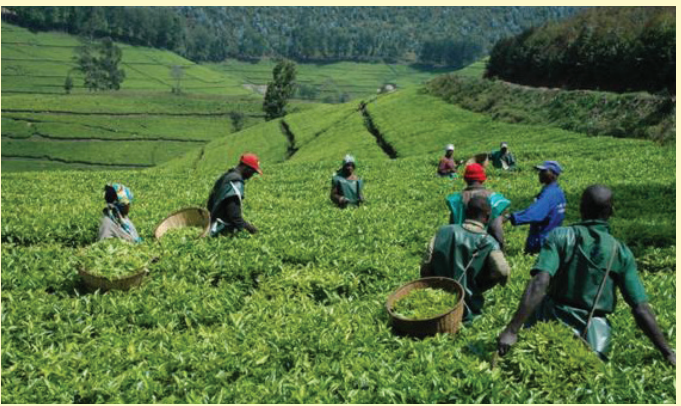
Write a composition detailing the contribution of agriculture in
Rwanda. In your composition discuss the various forms of agricultural
activities, expressing them in fractions and percentages. Compare yourcomposition with those of your classmates.
Activity 2
Research
Visit your computer laboratory to research into activities that contribute
to Rwanda’s economic development. Write sentences expressing their
contribution in percentages or fractions. Share your answers with otherclassmates.
Activity 3
Graphical data interpretation
Study the graph and write a paragraph describing Rwanda’s GDP growthrate since 2013. Compare your answers with other classmates
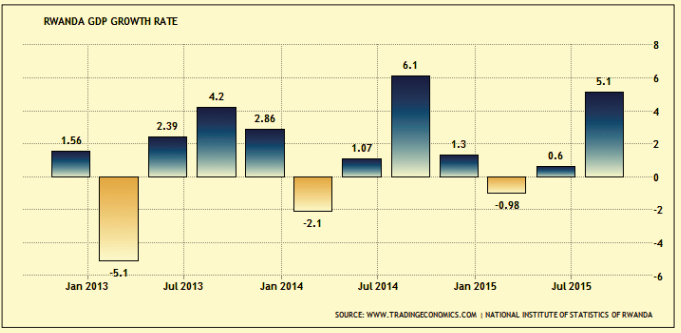
Reading and comprehension
Activity 1
Read and enjoy the following passage about the Rwandan
economy. Express your views about some of the issues as you
read the passage.
The growing appetite for Rwandan vegetables abroad is pressing local
farmers to transit from subsistence to commercial farming to meet the
growing demand.
Since 2011, vegetables have boosted the country’s exports value by
$20M, with an average of 7% growth every year. In 2011, Rwanda
earned $4M, increasing to $5M and $6M in 2012 and 2013 respectively,
then dropping to $5M in 2014 due to reduced productivity.Rwanda could turn into regional hub for horticulture
Emmanuel Hategeka, former Permanent Secretary, Ministry of
Commerce and Industry, told KTPress that there is a huge demand for
Rwandan vegetables, fruits and flowers, around the world owing to
their quality.
All fruits are organic and grown on fertile volcanic soils under tropical
weather conditions, ideal for quality yields, but the majority of Rwandan
farmers grow the fruits and vegetables at a subsistence level.
Rwanda is seeking more investors to increase volumes. Two potential
investors from Mauritius and Kenya have expressed interest in vegetable
and fruit growing and should begin exporting late this year.
Some of the major vegetables and fruits grown in Rwanda include
onions, cabbage, tomatoes, baby peas, avocados, carrots, passion fruit,
pineapples and maize.
Most of them are exported to the DRC, but there are other bigger markets
such as the UK, Belgium, the Netherlands and France. Other exportdestinations include Burundi and Uganda.
During the vegetable and fruit exports peak in 2013, Hategeka said,
Rwanda was experiencing both informal and formal cross-border trade
within regional markets.
Meanwhile, as part of the effort to increase volumes of vegetables and
fruits, there is also an opportunity for investing in cold chain storage
facilities from farm gate to the market.
Currently, Rwanda has one cold facility, at the Kigali International
Airport.
There is urgent need to invest in cold chain facilities to ensure the
vegetables and fruits don’t lose the required standards, especially on
the international market.
However, Dieudonne Musafiri, an Imports Manager at Akagera Business
Group, says, “Cold chain refrigerated trucks are expensive, but it is a
lucrative business because there is high demand for them. There wouldn’t
be any losses incurred.”
Despite the shortage of cold storage facilities, high transport costs to
international markets is another major obstacle facing the sector.
For example, exporting one kilogram of vegetables to Europe costs
$2.5. The trade ministry says it is helping exporters to negotiate for at
least $1 per kilogram.Source: KT Press (Umuhinzi)
Answer these questions
1. How has the demand for vegetables abroad boosted vegetable
growing in Rwanda?
2. Express the revenue loss Rwanda suffered as a percentage.
3. Account for the drop in the percentage you have mentioned above.
4. Explain what makes Rwanda an ideal fruit growing environment.
5. How will the investors boost fruit and vegetable growing in
Rwanda?
6. Compare the cold chain storage facilities with farm gate to the
market.
7. By having one cold storage facility, how does this situation affect
Rwanda’s fruit and vegetable industry?
8. Analyse other hindrances to fruit and vegetable farming and
suggest possible interventions that can help the local farmersUNIT 5:Discoveries and Inventions
Introductory activity: Read the following text and answer
questions below:
Medical discoveries and inventions
With the idea that modern healthcare is rooted in discoveries of the past,
let’s take a look at seven major medical
milestones of the 20th century.
In 1929, Sir Alexander Fleming, of St. Mary’s Hospital Medical School in
London, United Kingdom, shared his observation that the culture medium
on which a penicillium mold grew attacked certain types of bacteria. But
chemists and bacteriologists working separately were unable to isolate the
active substance in the mold ooze. Mold is a type of fungus that consists
of small organisms found almost everywhere.
In 1940, Oxford researcher Sir Howard Florey brought together a
multidisciplinary team who were finally able to isolate the drug penicillin.
Penicillin became widely popular in the years surrounding World WarIInot only for
the treatment of battle wounds, but also for the treatment of
syphilis. Moreover, penicillin led to a surge in healthcare utilization in thepost-war era.
American scientists John Enders, PhD, Thomas Weller, MD, and Frederick
Robbins, MD, announced in 1949 that they had grown poliovirus in
cultured human embryonic skin and muscle cells, thus taking tissue
culture mainstream. This discovery led to methods of measuring
immunity to polio and the Nobel Prize for the trio in 1953.
As late as 1952, geneticists didn’t know how Deoxyribonucleic acid
(DNA) worked. All of this changed with the 1953 discovery of the double
helix (the DNA double helix is an elegant structure that allows the genetic
information to be stored, protected, replicated, and repaired) by James
Watson, PhD, and Francis Crick, PhD. Their discovery of DNA’s structure
was rooted in Gregor Mendel’s theory on the principles of single gene
inheritance in 1866, as well as Sir Archibald Garrod’s elucidation of the
inheritance pattern of alkaptonuria (black urine disease) which is a very
rare inherited disorder that prevents the body fully breaking down two
protein building blocks (amino acids) called tyrosine and phenylalanine)
in 1923.
Drs. Watson and Crick, as well as Maurice Wilkins, PhD, were honored with
the Nobel Prize for Physiology or Medicine in 1962 for their discovery.
In addition to Dr. Wilkins, Rosalind Franklin, PhD, helped produce x-ray
diffraction images instrumental to the deduction of Drs. Watson and Crickthat DNA is a three-dimensional helix.
Comprehension questions
1. Outline major medical milestones of the 20th century.
2. Explain how penicillin was discovered.
3. Write in full form of the acronym DNA.
4. Explain Archibald Garrod’s contribution to the discovery of thedouble helix in 1923.
Vocabulary practice
Use each of the following words in your own sentence.
1. milestones
2. penicillium mold
3. mold ooze
4. penicillin
5. surge
6. poliovirus
7. cultured
8. embryonic skin
9. muscle cells
10.culture mainstream
11.single gene inheritance
12.elucidation13.physiology
Activity
Write a composition explaining why penicillin is no longer commonlyprescribed to treat infections. Tell other antibiotics that are in use today.
Recounting a famous discovery
Language use
Activity 1
Discussion
Share your opinions about these questions and compare your answerswith other classmates.
1. Explain the role of scientists in our communities.
2. Think about the life people in the past lived without advanced
science and technology. Compare their life with the life today
where we live in a modern scientific world.
3. How have scientists made our lives more comfortable and
interesting?4. Whom do you regard as your favourite scientist? Why?
Describing a famous invention
Activity 1
Discussion
1. Share with your classmates or Biology teachers what you know
about Gregor Mendel. Explain the relevance of his discovery about
genetics to our lives.2. Discuss why he is referred to as “the father of genetics”.
Activity 2
Read and enjoy the story about Gregor MendelGregor Mendel, the father of genetics
Mendel was unhappy with how inheritance of traits was being
explained
People had known for millennia about selective breeding. They knew
that by breeding from those individuals that showed the most desirable
traits, future generations were more likely to show these desirable traits.
• Guard dogs might be bred from parents that were loyal and
friendly to their owners, but were suspicious or even aggressive
with strangers.
• Cattle might be bred from cows that yielded the most milk and
bulls that yielded the most meat.
• Wheat might be kept and sown the following year from those
plants which had produced the most abundant crop.
The main theory of heredity in Mendel’s time was that offspring were
a smooth blend of their two parents’ traits.
Mendel set himself the very ambitious task of discovering the laws of
heredity
To achieve this, he embarked on a mammoth-sized, highly systematic,
eight-year study of edible peas, individually and carefully recording the
traits shown by every plant in successive generations.
His work involved growing and recording the traits in about 30,000
plants.
One of the keys to his success was breeding from closely related peavarieties which would differ in only a small number of traits
The seven traits of pea plants that Mendel chose to study: seed wrinkles;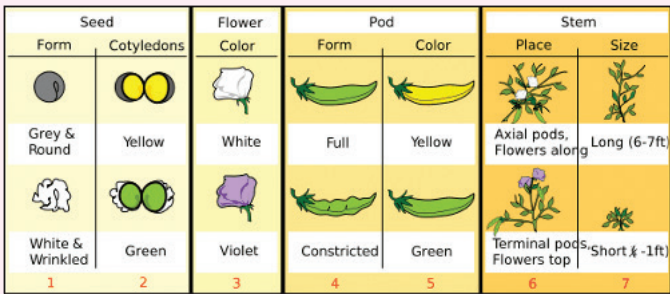
seed colour; seed-coat colour, which leads to flower colour; pod shape;
pod colour; flower location; and plant height.
Mendel’s results for flower colour
Mendel found the same results for all traits, but we shall look at flower
colour as an example.
When Mendel bred purple-flowered peas (BB) with white-flowered peas
(bb), every plant in the next generation had only purple flowers (Bb).
When these purple-flowered plants (Bb) were bred with one another
to create a second generation of plants, some white flowered plants
appeared again (bb).
Mendel realised that his purple-flowered plants still held instructions
for making white flowers somewhere inside them.
He also found that the number of purple compared to white was
predictable.
75 percent of the second-generation plants had purple flowers, while
25 percent had white flowers. He called the purple trait dominant andthe white trait recessive.
A Punnett square
Both of the starting plants have purple flowers but they contain the genes
for purple (B) and white (b). The pollen from the male plant fertilises
the egg in the female flower. In this variety of plant, purple flowers are
caused by a dominant gene (B). Dominance is indicated by a capital
letter. White flowers are caused by recessive genes, indicated by the
small letter (b). Both the male and female parent plants in the diagram
above carry the dominant gene B for purple and the recessive gene b
for white flowers. The ratio of purple flowers to white flowers in their
offspring will be 3:1 as shown in this diagram. For a white flower to
appear, the offspring must inherit the recessive gene from both parents.
Purple appears with any other combination of genes inherited from theparent plants. (Image by Madeleine Price Ball)
Mendel’s conclusions
Mendel’s most important conclusions were:
• The inheritance of each trait is determined by something (which we
now call genes) passed from parent to offspring unchanged. In other
words, genes from parents do not ‘blend’ in the offspring.
• For each trait, an organism inherits one gene from each parent.
• Although a trait may not appear in an individual, the gene that can
cause the trait is still there, so the trait can appear again in a future
generation.
Scientists who did research later found that Mendel’s results do not only
apply to pea plants. Trait inheritance in most plants and animals, including
humans, follows the patterns Mendel recorded.In Mendel’s honour, these very common patterns of heredity are now called
Mendelian inheritance.
Activity 3
Write notes about Mendel’s discovery about genetics.
Activity 4
In your own words, explain what you learnt about Mendel’s genetic
discovery.
Activity 5
Research
Visit your computer laboratory. Use the internet to carry out research
about two scientists and make notes to compare their discoveries.Compare your work with that of other classmates.
Describing a famous scientist
Activity 1
Discussion
There have been many scientific inventions and discoveries, all of which
are very useful in solving our world problems; such as in transport,
communication, and health, among others. Think about the transport
sector. Before, people would travel miles and miles on foot but today,
someone can travel around the world in just a few minutes or hours.
Which scientists do you know of that made discoveries, inventions or
innovations in the transport sector? What did he or she invent to solveour transport challenges?
Activity 2Read and enjoy the passage below carefully
Orville and Wilbur Wright are credited with inventing the aeroplane.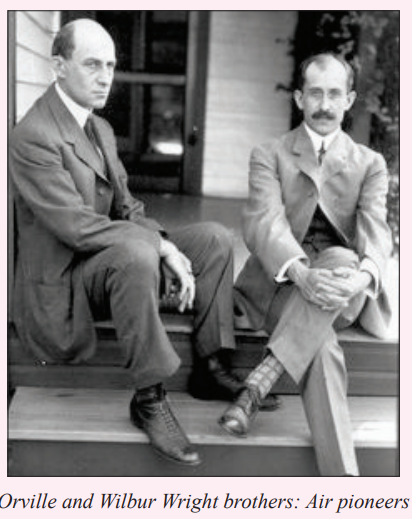
They were the first to make a successful human flight with a craft that
was powered by an engine and was heavier than air.
This was quite a milestone and impacted on transportation throughout
the world. It took some time to perfect, but in later years people could
travel long distances in much less time. Today, trips that previously
would have taken months by boat and train, can be made by plane in afew hours.
Orville and Wilbur Wright were born four years apart, in different cities.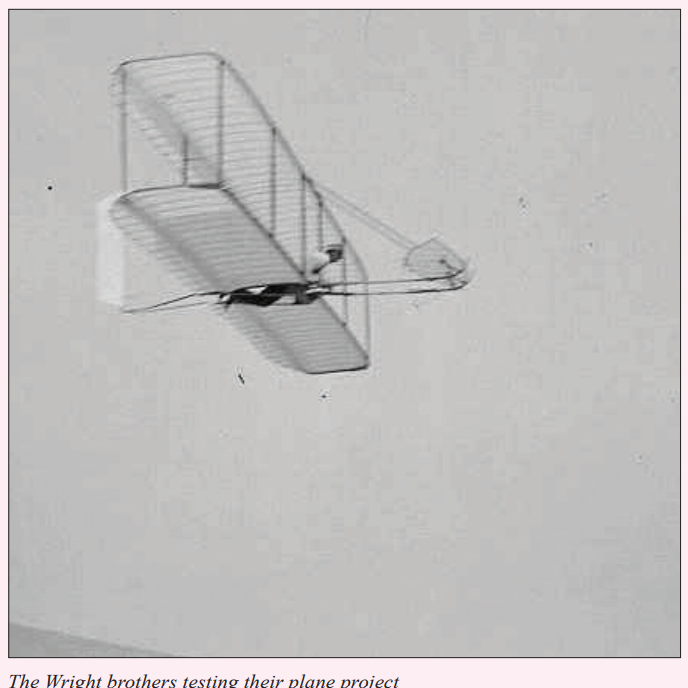
They shared a curiosity about the world and a love of tinkering that
would make history
Wilbur was born in 1867 on a small farm near Millville, Indiana. Orville
was born in 1871 in a house in Dayton, Ohio. Their father was a bishop
in the Church of the United Brethren in Christ. (The Wrights had five
children in all: Reuchlin, Lorin and Katharine were the names of the
other children.)
Life in the Wright house was strict but loving. Both parents encouraged
their children to enjoy school and learn as much as they could. A large
library of books about all kinds of subjects helped the Wright children
quench their thirst for knowledge from a very early age.
Orville and Wilbur’s fascination with flight began with a present their
father gave them—a flying toy. It had a paper body and other parts made
of cork and bamboo. Rubber bands provided the power. The young boys
(7 and 11) were thrilled to make the little toy fly across the room, so
much so that they broke it. They remembered how it looked, though,
and promised each other that someday they would fly in the air, just
like the little toy.
The boys continued to be interested in mechanical things and flight.
Orville sold kites at school to make money. Wilbur started reading all
he could about how birds flew and machines worked.
Though the boys were good students, neither graduated from high
school. (Not many did in those days, actually.) Wilbur was hit in the face
with a baseball bat when he was a teenager and suffered from irregular
heartbeats the rest of his life. He stayed at home for awhile, during
which time their mother developed tuberculosis (which, at that time,
was a devastating disease with no known cure). Wilbur recovered and
then stayed at home to care for his mother. Orville left high school on
his own, to start a printing business. He and Wilbur designed a printing
press that worked very well. The two later sold the printing business
and opened a bicycle shop. They were both very good mechanics and
could fix just about anything anyone asked them to fix. (They inherited
this skill and desire from their mother, who was the family mechanic.)
It was in the bicycle shop that the idea of the aeroplane was born.
The Wrights had made kites, very large ones, in fact. By 1900, they
were making ones so large that people could fly in them, sort of. These
were called gliders, and Orville and Wilbur actually built one or two
that were large enough for a person to ride in. They flew on nothing but
air current, and the person could get a ride of about 10 seconds before
the glider came down to the ground.
They flew the machine three times that day, mainly because each time
they managed to land without crashing. Each flight was a bit longer,
and the final flight of the day carried Wilbur 852 feet. He was in the airfor a full 59 seconds.
The Wright plane wasn’t a hit overnight, however. No one else knew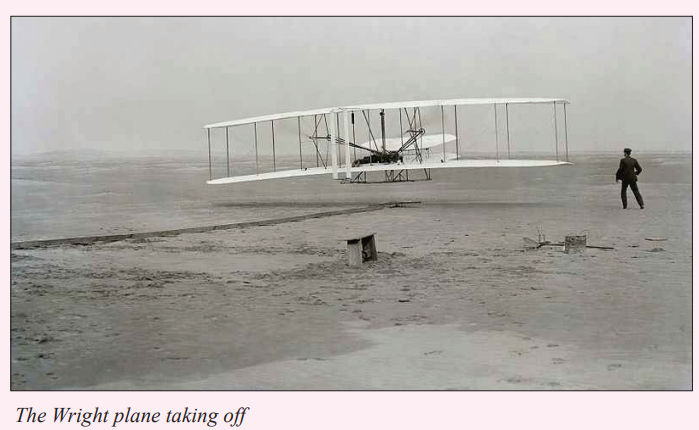
about the flight. The brothers returned to their bicycle business in Dayton
and also continued to refine their aeroplane invention. Not long after that,
they had built a plane that could fly 25 miles and go 40 miles an hour.
They even had a model that could fly circles—and not go off-balance
and crash to the ground!
In 1908, Wilbur flew one of their planes in front of royalty in Europe.
In the same year, the rest of America discovered the aeroplane when a
newspaper reporter witnessed a flight and wrote about it. The story was
soon in newspapers all over the country. The Wrights were suddenlyfamous.
The very next year, they opened a business to make aeroplane, the
Wright Co. They found great fame and success making aeroplane.
Unfortunately, Wilbur died in 1912 of typhoid fever. Orville lived
on, however, eventually selling his business and watching his and hisbrother’s dream become a reality in the modern industrial age.
Exercise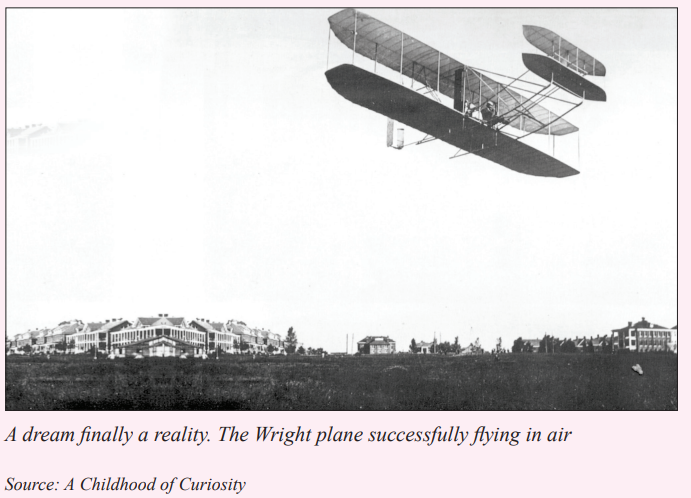
Answer these questions about the passage you have read
1. Why is Orville and Wilbur’s invention of a plane referred to as a
“milestone” in air transport?
2. Explain what inspired the Wright brothers to invent the aeroplane.
3. How was the idea of making a flying plane born in the bicycle
shop?
4. Explain how the gliders that the Wright brothers made worked.
5. How did the aeroplane invention by the Wright brothers get knownin Europe?
Activity 3
Imaginary interview
The Wright brothers did not go far in school. Actually they were about the
same level as we in Senior Four or Five, yet they made this spectacular
invention.
Imagine you met the Wright brothers. Think about the questions you
would ask them about their aeroplane invention. Use their knowledge to
think about a scientific invention you could make. Describe your amazing
scientific invention or discovery and explain the process you would go
through to create it. Describe the functionality and the problem it would
solve. Present your description in an expository essay. Compare youranswers with those of your classmates.
Before modern-day scientists explained natural forces using scientific
inquiry and investigations, early man used to explain natural forces using his
own knowledge and interpretation; most of which, actually, relied heavily on
divine philosophy. Scientists have helped much to demystify these natural
phenomena. They have also helped us to make scientific predictions and as
a consequence take precautionary measures. For example, we can explainthe concept of global warming, diseases, nutrition, etc. using science.
Activity 4
Discussion
Most of the earth’s forces such as gravitation pull or kinetic forces are
explained through physics.
(a) Who would you regard as the father of physics?
(b) What did he or she do?
(c) Describe his or her life.
(d) Do you think scientists are born scientists; or they are
inspired to dwell on science as they grow up?Activity 5
Read and enjoy the life story of the famous scientist, Chen-Ning Yang
The famous scientist: Chen-Ning Yang
Chen-Ning Yang thought the unthinkable and won the 1957 Nobel Prize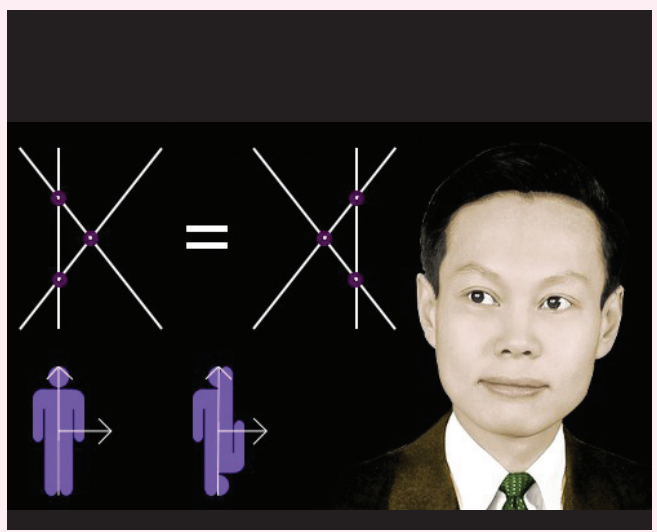
in physics. Yang and his co-worker Tsung-Dao Lee showed that parity
– a property that physicists had believed was always conserved – like
energy, momentum and electric charge – need not be conserved.
Yang also worked with Robert Mills to produce Yang-Mills theory, which
today lies at the heart of the Standard Model in physics.
Early life and education
Chen-Ning Franklin Yang was born on 22 September 1922 in the city
of Hefei, China.
His family moved to Beijing when he was young after his father,
WuChih, became a professor of mathematics at Tsinghua University. His
mother, Meng-hua, was a housewife.
Yang was schooled in Beijing until 1937, when the Japanese invasion of
China forced his family to return to Hefei, and then, a year later, move to
the city of Kunming. The Japanese army did not reach Kunming in the
south-west of China, although it was bombed by the Japanese air force.
Yang enrolled at the National Southwestern Associated University in
Kunming and was awarded a bachelor’s degree in physics in 1942.
In 1944 he was awarded a master’s degree in physics for his work in
statistical mechanics. He was awarded his degree by Beijing’s Tsinghua
University, which had relocated to Kunming.
Yang worked as a teacher until he won a United States government
scholarship in 1946, which took him to the University of Chicago. There
his doctoral advisor was Edward Teller, the father of the hydrogen bomb.
In 1948 Yang was awarded a PhD in physics for his work on nuclearreactions.
Chen-Ning Yang’s research work
After the award of his PhD, Yang stayed at Chicago for a year, working
with one of the giants of 20th century physics, Enrico Fermi.
In 1949 he was invited to become a theoretical physics researcher at the
Institute for Advanced Study in Princeton.
The institute had been founded in 1930 with the goal of employing the
best mathematicians and physicists in the world; Albert Einstein was
there from 1933 until his death in 1955.
Parity conservation
Atom smashing
During the 1950s, increasingly complex results had been coming out
of particle accelerators and cosmic ray detectors, causing increasing
confusion among physicists.
The accelerators were pushing ions and particles to enormous speeds,
then smashing them into one another. Physicists hoped the debris from
the collisions would reveal more about what matter is and how it behaves.
Cosmic rays – high energy particles reaching the Earth from the sun and
the stars – also produced interesting debris.
The debris from both accelerators and cosmic rays contains subatomic
particles, which are generally unstable, quickly decaying into other
particle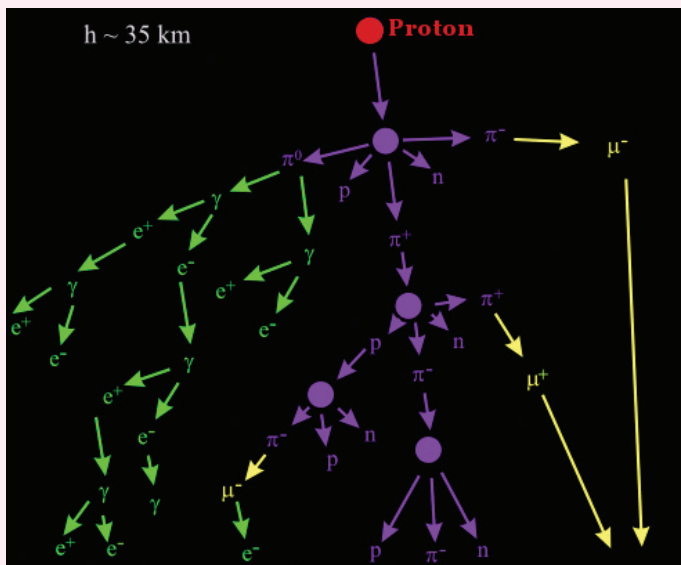
A very high energy proton (red) ejected by the sun enters the Earth’s
atmosphere. We call this a cosmic ray. It collides with a particle high
in the Earth’s atmosphere, producing a shower of subatomic particle
debris, which can help reveal some of the basic properties of matter.
The Meson problem
Two unstable particles, the theta-meson and the tau-meson, were causing
a lot of heads to be scratched.
In some senses, the theta-meson and the tau-meson looked as if they
might be the same particle: their masses and the average time they took
to decay into other particles seemed to be the same. The theta-meson
and the tau-meson both decayed into pi-mesons, usually known as pions.
BUT the theta decayed to produce two pions, while the tau decayed toproduce three pions
The theta and tau particles seemed to be identical, except the theta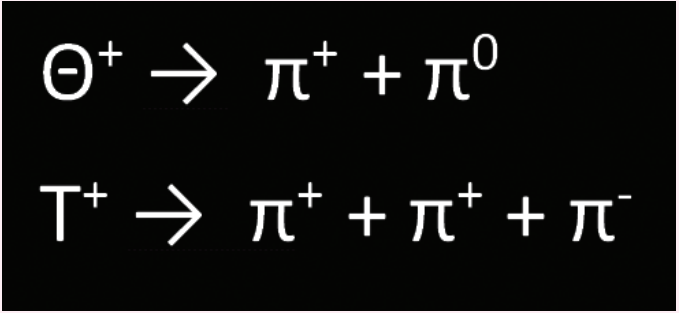
decayed to give two pions, while the tau produced three pions.
Most physicists took it as a fundamental law of the universe that when
any particle decayed, its parity stayed the same.
Parity must never be broken: this meant, in a very simplified way, that
the same particle could not possibly decay sometimes into two pions,
and at other times into three pions. Physicists believed there was a
fundamental symmetry in the universe. If parity were broken, the
fundamental symmetry they believed in would also be broken.
Physicists regarded parity as a property that was conserved in the same
way that energy, momentum, and electric charge are always conserved.
Yet the only difference physicists could find between the theta-meson
and the tau-meson was that they decayed differently. Otherwise these
mesons seemed identical.
A daring hypothesis: Broken parity
What if there really were only one meson – a meson that sometimes
decayed into two pions and sometimes into three pions?
Most physicists thought the idea was ludicrous; if there was one thing
they could rely on Mother Nature to do, it was to preserve parity andsymmetry.
Enter Yang and Lee
At the Institute for Advanced Study, Yang had started working with
Tsung-Dao Lee. They had actually first met in China at the National
Southwest University.
Yang was now a full professor of theoretical physics, having been
promoted in 1955.
In summer 1956, Yang and Lee thought the unthinkable. What if parity
really could be broken? At this time, Yang was 34 and Lee was 29 years old.
The meson decay they were looking at involved the weak nuclear force
– the force responsible for nuclear fission and beta particle emission
from atomic nuclei.
The two physicists read everything they could and carried out a large
number of calculations; they wanted to see if there truly was a fundamental
physical law preventing parity being broken for interactions involving the
weak nuclear force. There was already good evidence that parity could
not be broken for interactions involving the strong nuclear force.
They published their work late in 1956, showing they could find nothing
to stop parity being broken for weak interactions and they described
experiments they had devised which could prove whether parity was
broken.
The unthinkable is true = Nobel Prize
A team of physicists at the Cryogenics Physics Laboratory at the National
Bureau of Standards in Washington carried out one of the experiments
designed by Yang and Lee, cementing Yang and Lee’s place in the
history of science.
In 1957 Yang and Lee won the Nobel Prize in Physics: they had
thought the unthinkable, their calculations showed the unthinkable was
possible, and they had devised experiments that had established that the
unthinkable was actually true: the theta and tau mesons were actually
the same particle and Mother Nature did not preserve parity. Symmetry
had also been broken. At a deep level, this means that nature can tell thedifference between left and right.
In the more sombre words of the Nobel Prize Committee, Yang and
Lee’s prize was for their “penetrating investigation of the so-called parity
laws which has led to important discoveries regarding the elementary
particles.”
Even in the face of the theta-tau puzzle, most physicists had not seriously
contemplated the possibility of parity breaking. Physics giant Richard
Feynman was pleased that at one point he gave the odds of parity
breaking being discovered as low as 1 in 50!
Particle physics had been held back for years by the incorrect assumption
that parity could not be broken in weak interactions. Yang and Lee setparticle physics free again
The theta-tau puzzle was solved when Yang and Lee paved the way for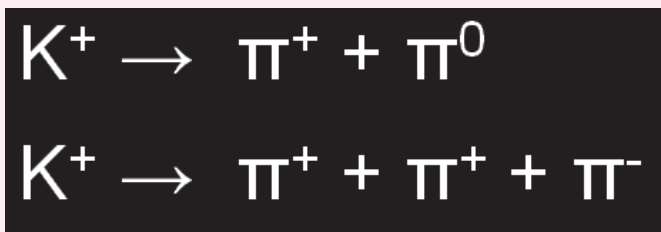
the discovery that tau and theta mesons are identical: they represent
different behaviours of the K+
meson. Sometimes a K+
meson decays toform two pions; sometimes it decays to form three pions.
Exercise
Answer these questions about the passage.
1. Use your own words to explain the important scientific principle
that Yang discovered.
2. By his father being a professor of mathematics at Tsinghua
University, do you think this inspired Yang’s discovery of the
physics law? Explain your opinion.
3. At only 26 years, Yang had already attained a PhD in physics, the
highest degree award in any field of study. Explain the contribution
of his education to his important discovery.
4. Carry out research about Professor Albert Einstein and find out
why he is known as the father of modern physics. Do you think
that Yang’s working in the same university with Professor Albert
Einstein, broadened his mind to discover the scientific law?
Explain your opinion.
5. In your own words, explain precisely what the Meson problem was
all about and the confusion it was causing among most physicists.6. Explain how Yang solved the parity puzzle.
Describing African scientists
Activity 1
Discussion
We have discussed European, American and Asian scientists in the
previous sub-units. In this sub-unit, we are going to discuss African
scientists and their prolific innovations, inventions and discoveries.
Are there some African scientists you know of? Share them and their
scientific works with your group members. Choose a group secretary to
present your findings to the class for further discussion and comparison.
If you do not know any African scientist, then visit the internet facility of
your school laboratory. If your school does not have a computer, conductresearch from science textbooks from your library or ask your teachers.
Activity 2
Research on African scientists
Visit your school laboratory and find out about the life and scientific
discoveries or works of these famous African scientists. Compare your
findings with those of your classmates. If your school does not have acomputer laboratory, ask your science teachers.
Speculating about the future
Third conditional
Activity 1
Look at this sentence. What does it mean?
If Alexander hadn’t discovered antibiotics, many people would have
died.
Activity 2
Look at the scientists and their discoveries or inventions that you have
learnt about in this unit. Predict what would have happened if they hadn’t
made those discoveries. Write sentences about your speculations.
Activity 3
Carry out research about the scientists in the table below and their
discoveries or inventions on the internet, or by asking your science
teachers, and write sentences speculating what would have happened if
they hadn’t made their discoveries. Compare your sentences with thoseof your classmate

Activity 4
Gap filling
Predict what would have happened in these sentences and complete them.
1. If the Wright brothers hadn’t invented the aeroplane, ……………
2. If their father hadn’t given them a gift of a toy plane, the Wright
brothers ………………
3. ………………, the idea of the aeroplane wouldn’t have been born.
4. If the Wright brothers hadn’t made the kites, …………….
5. If the newspeople hadn’t covered the first flight, …………….
6. If Mendel hadn’t set for himself the ambitious task of discovering
the laws of heredity, ……………………
7. If Chen-Ning Yang hadn’t studied physics,…………………..
8. If the Meson problem hadn’t persisted, Yang ………………..
9. If Dr. Phillip Emeagwali hadn’t developed the world’s fastest
computer, …………..
10. If Professor Gebisa Ejeta ………………, the sorghum breedingresearch would not have been successful.
Grammar highlight: Third Conditional
We can use the third conditional to talk about ‘impossible’ conditions.
Impossible because they are in the past and we cannot change what
has happened.
Examples
If I had worked harder at school, I would have got better grades.
If I had had time, I would have gone to see him. But I didn’t have time.
If we had bought that house, we would have had to rebuild the kitchen.
If we had caught the earlier train, we would have got there on time but
we were late.Notice that the main clause can contain ‘would’, ‘could’ or ‘might’.
If I had seen him at the meeting, I would have asked him. (But he wasn’t
there so I didn’t.)
If I had seen him at the meeting, I could have asked him. ( But he wasn’t
there so it wasn’t possible.)
If I had seen him at the meeting, I might have asked him. (But I’m not
sure. Perhaps if the opportunity had arisen.)
If I had paid more attention in class, I would have understood the lesson.
Also notice that sometimes the ‘if clause’ is implied rather than spoken.
I’d have done it. (“if you had asked me but you didn’t.”)
I wouldn’t have said that. (“if I’d been there.”)He wouldn’t have let him get away with that. (“if he had tried that with me.”)
Revision on the third conditional
Activity 1Gap filling
In this exercise, you will practise forming the third conditional. Basing
on the example sentence, complete the third conditional sentences by
filling in the spaces. For example:
I didn’t pass the test, because I hadn’t studied hard enough.
“If I had studied harder, I would have passed the test.”
1. He crashed his car because he fell asleep while driving.
If he …………… asleep while driving, he …………… his car.
2. We couldn’t go to the concert because we didn’t have enough
money.
If we ………… enough money, we ……… to the concert.
3. I lost my job because I was late for work.
I …………… my job if I …………… late for work.
4. The wind was so strong that the bridge collapsed.If the wind …………… so strong, the bridge …………… .
5. I couldn’t call Mutesi because I had lost her number.
…………… Mutesi if I …………… her number.
Exercise
Multiple choice
For each question, read the situation and choose the best sentence using
the third conditional.
1. I wasn’t thirsty. I didn’t drink the lemonade.
A. If I was thirsty, I would drink the lemonade.
B. If I had been thirsty, I would’ve drunk the lemonade.
C. If I would have been thirsty, I drank the lemonade.
2. I didn’t know Butera was in town. I didn’t call her.
A. If I had known Butera was in town, I would have called her.
B. I had called Butera if I had know she was in town.
C. I would had called Butera if I have known she was in town.
3. I didn’t know watching this documentary was important for our
exam. I didn’t watch it.
A. If I knew this documentary was important, I had watched
it.
B. If I would have known this documentary was important, I
had watched it.
C. If I had known this documentary was important, I would’ve
watched it.
4. I walked home from the disco. My friend was too drunk to drive.
A. I hadn’t walked home from the disco if my friend wasn’t
too drunk to drive.
B. I wouldn’t have walked home from the disco if my friend
hadn’t been too drunk to drive.
C. I wouldn’t had walked home from the disco if my friend
hadn’t been too drunk to drive.
5. I didn’t go to the store. I thought it closed at 5 pm. It closed at 6 pm.
A. If I had known the store had closed at 6 pm, I would’ve
gone
B. If I knew the store would have closed at 6 pm, I would’ve gone.
C. I would’ve gone to the store if I know it had closed at 6 pm.
6. I ate the yoghurt in the fridge. I thought it was mine, not yours.
A. If I would have known the yoghurt was yours, I wouldn’t
have eaten it.
B. If I had known the yoghurt was yours, I wouldn’t have eaten
it.
C. I hadn’t eaten the yoghurt if I knew it was yours.
7. I am really hungry now. I didn’t have any breakfast.
A. If I had some breakfast, I wouldn’t be hungry now.
B. If I would had had some breakfast, I wouldn’t be hungry
now.
C. If I had had some breakfast, I wouldn’t be hungry now.
8. I didn’t see Tony at the party. I wanted to speak to him about his
vacation in Kenya.
A. If I saw Tom at the party, I would’ve spoken to him.
B. If I had seen Tom at the party, I would’ve spoken to him.C. If I would have seen Tom at the party, I would’ve spoken to him.
Predicting discoveries and inventions in the
future
Activity 1
Research
We are witnessing many scientific innovations like the computer and
satellite technology and indeed many more inventions, discoveries and
innovations are in the pipeline. You have probably heard people predict
some of them. Discuss the scientific inventions you think will happen in
the coming years. If you do not know, then use the internet to find outor ask your science teachers and community members.
Activity 2
Research
In groups, study the photographs carefully. Describe them with your
classmates.
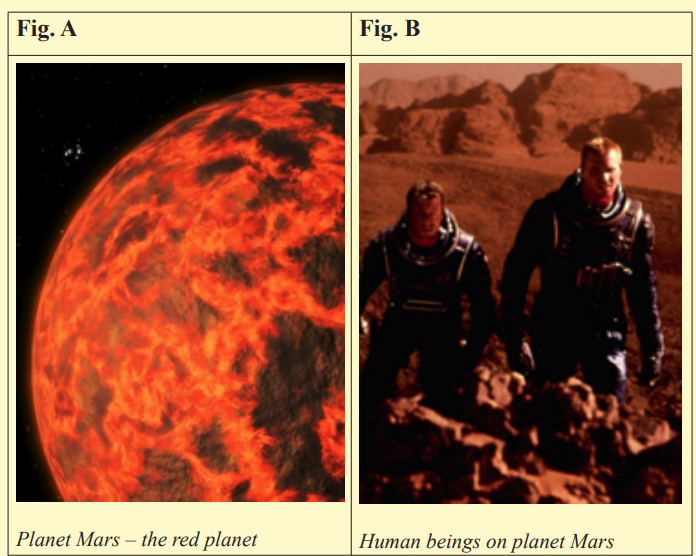
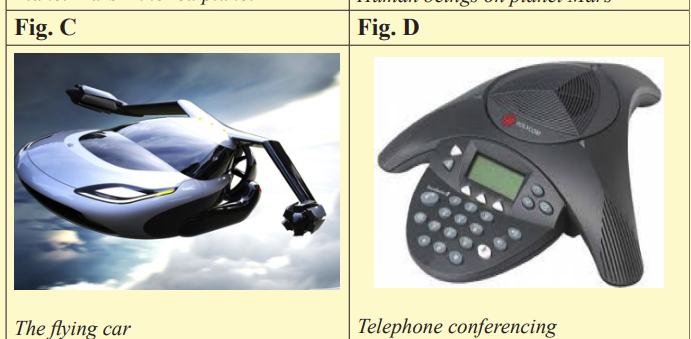
Answer these questions
1. Look at Fig. A of the planet Mars, also called the red planet. Find
out why it is called the red planet. Have you heard of the one-way
ticket to Mars? It is an expedition in which a USA billionaire
called Elon Musk has invested to land humans on planet Mars to
live there permanently after the scientists in Fig. B discovered that
the planet could support human life. Visit your school’s internet
laboratory, search for the topic ‘one-way ticket to Mars’. Write an
essay about how the whole process will be conducted, the possible
challenges humans who will live on the planet will face and the
possible mitigation measures scientists have put in place.
2. Look at Fig. C (the flying car). It is anticipated to solve the problem
of traffic jams in towns and cities. Again use the internet to find
out how the car will operate.
3. Fig. D is a telephone conferencing gadget. Conference means a
gathering. This gadget is already in use with plans to modify it so
that it can address hundreds of thousands or millions of people in
a community. How does it work? Find out from the internet.
4. Have you heard of the Airbus; of the road that will be constructed
to rotate around the world cutting through the major cities of the
world; food that will be grown in floating gardens in air; cities
and towns built on water by scientists; the first head transplant
that will take place in December 2017, by Professor Doctor Sergio
Canavero, an Italian neurosurgeon; etc? Research about all of them
and any other astonishing future or current scientific inventions,
innovations and discoveries and find how they will affect the
world. Present your work in an essay.Please work together and compare your answers.
Future perfect
Activity 3
Discussion
1. Predict the inventions that will happen in future. What do you
think life as influenced by scientific innovations will be like in
the year 2500?
2. What impact do you think these scientific inventions, innovations
and discoveries will have on our lives?
3. Do you think by 2500, a cure for HIV/AIDS will have been found?
4. What do you predict will be the effect of science and technology,
including ICT, on the lifestyles of the people who will be livingby that time, 2500 and beyond?
Exercise
Use the predictions to write sentences or paragraphs about those scientific
inventions and discoveries and the effect they have on our lives and the
environment using the future tense ‘will’. Compare your answers with
those of your classmates.
Example
By the year, 2050, it is predicted by the UN that there will be two billion
more people in the world, creating a demand for 70 percent more food. By
that time, 80 percent of us will be living in cities, and most of the food will
be farmed in the cities. I predict that scientists will invent air floating farmsto meet the very great food demand for the urbanites
UNIT6:Natural and Industrial Processes
My goals
After studying this unit, I will be able to:
⦿ Describe a natural, biological, environmental, industrial or mining
process.
⦿ Plan, write and evaluate texts with a sequence of sentences, describing
a process.
⦿ Write a sequence of sentences describing a process, with a diagram,
paying attention to connectors of time or cause and effect.
⦿ Make notes and summary of a text.
⦿ Respect natural and industrial processes role in Rwanda’s economicdevelopment
Language use
Describing a natural process
Activity 1
Discussion and research
Look at the various natural occurrences like thunderstorms, earthquakes,
stars, clouds, rain water, and others. Have you ever wondered about the
processes these natural phenomena go through to form?
Activity 2
Look at the photograph of a cloud below. Discuss the importance ofclouds.

Activity 3
Read the passage below to find out how clouds are
formed
What are clouds?
A cloud is a large collection of very tiny droplets of water or ice crystals.The droplets are so small and light that they can float in the air.
How are clouds formed?
All air contains water, but near the ground it is usually in the form of an
invisible gas called water vapour. When warm air rises, it expands and
cools. Cool air can’t hold as much water vapour as warm air, so some
of the vapour condenses onto tiny pieces of dust that are floating in the
air and forms a tiny droplet around each dust particle. When billions of
these droplets come together they become a visible cloud.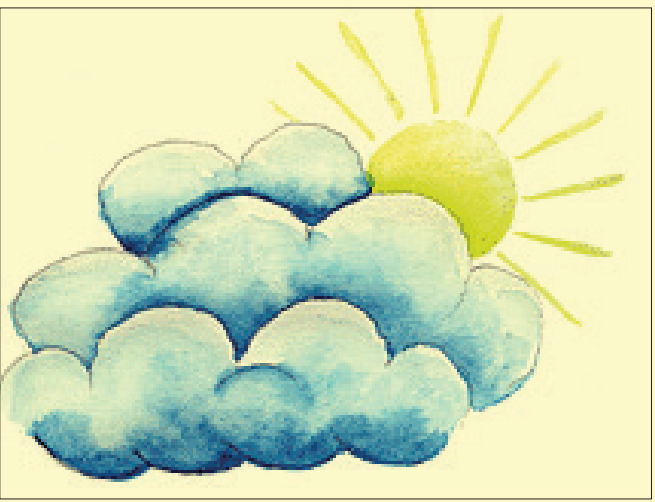
Activity 3
Read the passage below to find out how clouds are
formed
What are clouds?
A cloud is a large collection of very tiny droplets of water or ice crystals.The droplets are so small and light that they can float in the air.
How are clouds formed?
All air contains water, but near the ground it is usually in the form of an
invisible gas called water vapour. When warm air rises, it expands and
cools. Cool air can’t hold as much water vapour as warm air, so some
of the vapour condenses onto tiny pieces of dust that are floating in the
air and forms a tiny droplet around each dust particle. When billions ofthese droplets come together they become a visible cloud
Why are clouds white?
Since light travels as waves of different lengths, each colour has its
very own unique wavelength. Clouds are white because their water
droplets or ice crystals are large enough to scatter the light of the seven
wavelengths (red, orange, yellow, green, blue, indigo and violet), whichcombine to produce white light.
Why do clouds turn grey?
Clouds are made up of tiny water droplets or ice crystals, usually a
mixture of both. The water and ice scatter all light, making clouds
appear white. If the clouds get thick enough or high enough, all the light
above does not make it through, hence the grey or dark look. Also, if
there are lots of other clouds around, their shadow can add to the greyor multicoloured grey appearance.
Why do clouds float?
A cloud is made up of liquid water droplets. A cloud forms when air is
heated by the sun. As it rises, it slowly cools until it reaches the saturation
point and water condenses, forming a cloud. As long as the cloud and theair that it is made of is warmer than the outside air around it, it floats!
How do clouds move?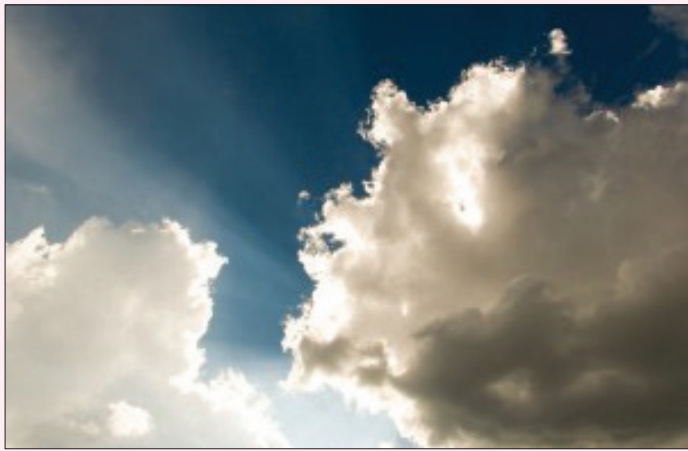
Clouds move with the wind. High cirrus clouds are pushed along by
the jet stream, sometimes travelling at more than 100 miles per hour
(mph). When clouds are part of a thunderstorm they usually travel at30 to 40 mph
Why do clouds form at different heights in the atmosphere?
The characteristics of clouds are dictated by the elements available,
including the amount of water vapour, the temperatures at that height,the wind, and the interplay of other air masses.
How is fog formed?
There are many different types of fog, but fog is mostly formed when
southerly winds bring warm, moist air into a region, possibly ending a
cold outbreak. As the warm, moist air flows over much colder soil or
snow, dense fog often forms. Warm, moist air is cooled from below as
it flows over a colder surface. If the air is near saturation, moisture will
condense out of the cooled air and form fog. With light winds, the fognear the ground can become thick and reduce visibility to zero.
Activity 4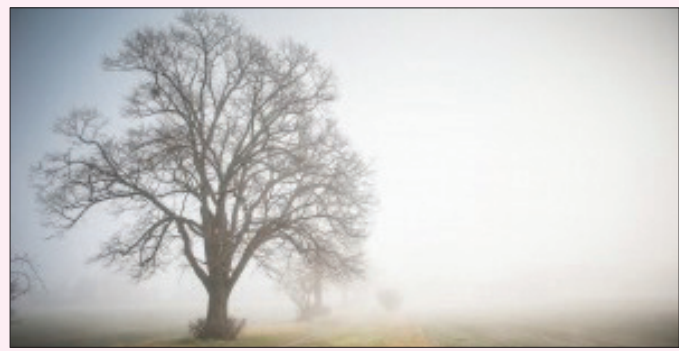
Research
Think about a natural observable feature and conduct research about
how it forms. Describe the process to your classmates.
Describing a biological process
Activity 1
Discussion
Just like any living thing needs food to survive, plants also make the food
they consume for their survival. In your Science or Biology lessons, youshould have learnt about the process by which plants make their food.
Activity 2
Research and essay writing using connectors of time and
cause and effect
Study the picture below carefully. Use it and your own Science
or Biology knowledge to write about the process by which plants
manufacture their food called photosynthesis. Write down the process
and choose a secretary who will present your essays to the class forfurther discussion and comparison of your findings.
Describing a process: Photosynthesis
Describing an environmental process
In all our studies, we have emphasised the relevance of protecting our
environment, yet human-induced factors, especially through industrialisation,continue causing insurmountable damage to the environment.
Activity 1
Discussion
(a) Have you ever heard about acid rain? What is it?
(b) What causes acid rain?
(c) Describe the effects of acid rain.
(d) What piece of advice would you suggest to prevent acid rain?
Activity 2
Study the diagram carefully. Read the passage below itto match what you see in the text.
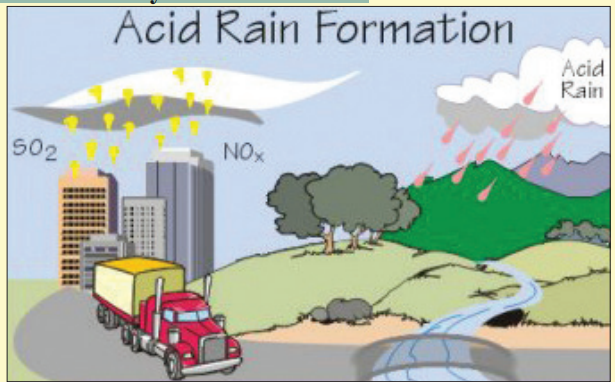
(Photo credit: Environmental Protection Agency (EPA))
Factories produce bad toxic gases called SO2
and NOx and release them
into the air (these are represented by the yellow dots in the diagram).
When SO2and NOx combine with the air, acid rain is created.
Acid rain is caused by a chemical reaction that begins when compounds
like sulfur dioxide and nitrogen oxides are released into the air. These
substances can rise very high into the atmosphere, where they mix and
react with water, oxygen, and other chemicals to form more acidic
pollutants, known as acid rain. Sulfur dioxide and nitrogen oxides
dissolve very easily in water and can be carried very far by the wind. As
a result, the two compounds can travel long distances where they become
part of the rain, sleet, snow and fog that we experience on certain days.
Human activities are the main cause of acid rain. Over the past few
decades, humans have released so many different chemicals into the
air that they have changed the mix of gases in the atmosphere. Power
plants release the majority of sulfur dioxide and much of the nitrogen
oxides when they burn fossil fuels, such as coal, to produce electricity.
In addition, the exhaust from cars, trucks and buses releases nitrogen
oxides and sulfur dioxide into the air. These pollutants cause acid rain.
Acid rain has a pH below 5.6. Normal rain has a pH of about 5.6, which
is slightly acidic. (The pH value is a measure of acidity or alkalinity,
ranging from 0 to 14. A pH measurement of 7 is regarded as neutral.
Measurements below 7 indicate increased acidity, and those above 7
indicate increased alkalinity.)
The principal natural phenomena that contribute acid-producing gases
to the atmosphere are emissions from volcanoes and from biological
processes that occur on the land, in wetlands and in the oceans. The
effects of acidic deposits have been detected in glacial ice thousands
of years old in remote parts of the globe. Principal human sources are
industrial and power-generating plants and transportation vehicles. The
gases may be carried hundreds of miles in the atmosphere before they
are converted to acids and deposited.
Since the industrial revolution, emissions of sulfur and nitrogen oxides
to the atmosphere have increased. Industrial and energy-generating
facilities that burn fossil fuels, primarily coal, are the principal sources
of increased sulfur oxides. These sources, plus the transportation sector,are the major originators of increased nitrogen oxides.
The problem of acid rain has not only increased with population and
industrial growth, it has become more widespread. The use of tall
smokestacks to reduce local pollution has contributed to the spread of
acid rain by releasing gases into regional atmospheric circulation. The
same remote glaciers that provide evidence of natural variability in acidic
deposition show, in their more recently formed layers, the increased
deposition caused by human activity during the past half century.
Effects of acid rain
Acid rain causes acidification of lakes and streams and contributes to
the damage of trees at high elevations (for example, red spruce trees
above 2,000 feet) and many sensitive forest soils. In addition, acid
rain accelerates the decay of building materials and paints, including
irreplaceable buildings, statues and sculptures that are part of our nation’s
cultural heritage. Prior to falling to the earth, sulfur dioxide (SO2
) and
nitrogen oxide (NOx) gases and their particulate matter derivatives—
sulfates and nitrates—contribute to visibility degradation and harm
public health.
Environmental effects of acid rain
The most obvious environmental effect of acid rain has been the loss
of fish in acid-sensitive lakes and streams. Many species of fish are not
able to survive in acidic water. Acid rain affects lakes and streams in two
ways: chronic and episodic. Chronic, or long-term acidification results
form years of acidic rainfall. It reduces the alkalinity (buffering capacity)
and increases the acidity of the water. Chronic acidification may reduce
the levels of nutrients such as calcium, which, over time, may weaken
the fish and other plants and animals in an aquatic ecosystem. Episodic
acidification is a sudden jump in the acidity of the water. This can
result from a heavy rainstorm. It also happens in the spring, because the
sulfates and nitrates will concentrate in the lowest layers of a snowpack.
In the spring, when that snow melts, it will be more acidic than normal.
Episodic acidification can cause sudden shifts in water chemistry. This
may lead to high concentrations of substances such as aluminum, whichmay be toxic to fish
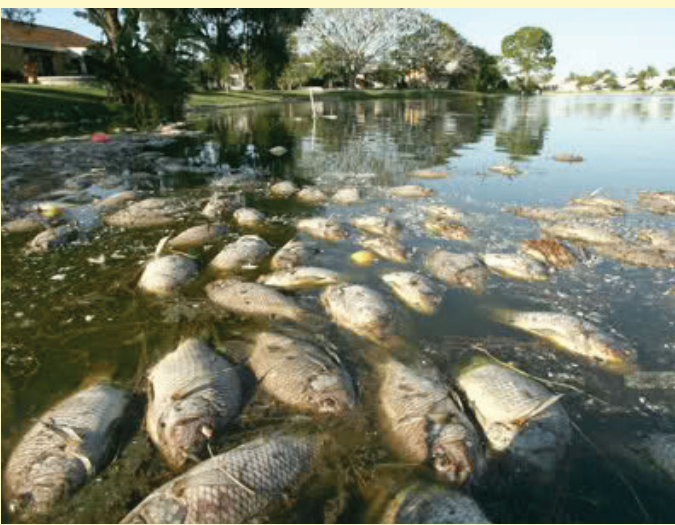
Dead fish in a lake polluted by acid rain
Most of the effects on forests are subtle. Acid deposition may influence
forest vegetation and soils. Acid rain has been cited as a contributing
factor to the decline of the spruce-fir forests throughout the eastern
United States. Acid rain may remove soil nutrients such as calcium
and magnesium from soils in high elevation forests and cause damage
to needles of red spruce. Acid rain may also help weaken the natural
defences of some trees, making them more vulnerable to some diseases
and pests.
Acid rain deposits nitrates that can lead to increases in nitrogen in forests.
Nitrogen is an important plant nutrient, but some forest systems may
not be able to use all they receive, leading to nitrogen saturation. In the
eastern United States, there is evidence of nitrogen saturation in some
forests. Nitrates can remove additional calcium and magnesium from
the soils. Continued nitrogen deposition may alter other aspects of the
nutrient balance in sensitive forest ecosystems and alter the chemistryof nearby lakes and streams
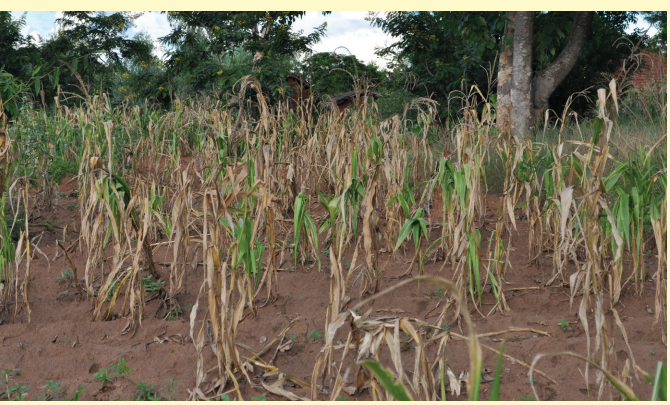
Maize plantation prematurely dried by acid rain
Excess nitrogen may cause eutrophication (over-nourishment) in areas
where rivers enter the ocean. This may lead to unwanted growth of
algae and other nuisance plants. As much as 40% of the total nitrogen
entering coastal bays on the Atlantic and Gulf coasts may come from
atmospheric deposition.
Effects of acid rain - human health
Acid rain looks, feels and tastes just like clean rain. The harm to people
from acid rain is not direct. Walking in acid rain, or even swimming in
an acid lake, is no more dangerous than walking or swimming in clean
water. However, the pollutants that cause acid rain—sulfur dioxide (SO2
)
and nitrogen oxides (NOx)—do damage human health. These gases
interact in the atmosphere to form fine sulfate and nitrate particles that
can be transported long distances by winds and inhaled deep into people’s
lungs. Fine particles can also penetrate indoors. Many scientific studies
have identified a relationship between elevated levels of fine particles
and increased illness and premature death from heart and lung disorders,
such as asthma and bronchitis.
Based on health concerns, SO2
and NOx have historically been regulated
under the Clean Air Act, including the Acid Rain Programme. In theeastern U.S., sulfate aerosols make up about 25 percent of fine particles
By lowering SO2
and NOx emissions from power generation, the Acid Rain
Programme will reduce the levels of fine sulfate and nitrate particles and
so reduce the incidence and the severity of these health problems. When
fully implemented by the year 2010, the public health benefits of the Acid
Rain Programme are estimated to be valued at $50 billion annually, due
to decreased mortality, hospital admissions and emergency room visits.
Decreases in NOx emissions are also expected to have a beneficial impact
on human health by reducing the nitrogen oxides available to react with
volatile organic compounds and form ozone. Ozone impacts on human
health include a number of morbidity and mortality risks associated withlung inflammation, including asthma and emphysema.
Activity 3
Summary writing
In 100 words, describe the causes and effects of acid rain. Compare yoursummaries with those of your classmates.
Describing an industrial process
Using the passive voice and sentence connectors
Activity 1Work
In our previous classes, we learnt about the passive voice. Share with
a classmate what you know about the passive voice and why it is an
appropriate tense for describing processes. You may exhibit knowledge
by writing a simple process of getting a product using the passive tense.Compare your paragraph with those of your classmates.
Activity 2
Sentence connectors
Read these sentences. Share their meaning among yourselves.
1. Science is amusing but also wearying; it is fascinating yet
challenging.
2. Be proud to stand up for purity because that way alone leads to a
magnetic personality.
3. On the other hand, if you do not pay attention to the scientific
details, science can turn out to be harmful.
4. Last month, he was given the final warning against drinking. Even
so, he did not heed the warning and was eventually expelled.
5. We could not allow such a habitual drunkard to join us; besides, he
had already exhibited ill manners that he was bent on not changing.
Note
The words and phrases (sentence connectors) in italics, make connections
between one sentence or clause and another, doing some of the work ofmaking clear the relationship between the ideas expressed.
Activity 3
Work
Study the following sentence connectors. Discuss their meaning and
use them in sentences of your own.
1. Expressing addition: too, also, equally, moreover, additionally
(in addition to), at the same time, in the same way, similarly,
furthermore, as a matter of fact, etc.
2. Expressing cause and effect: as a result, therefore, consequently,
so, thus, because, of that.
3. Expressing comparison: similarly, unlike.
4. Expressing concession: however, nevertheless, and yet, besides, a
the same, through, in spite of (despite), in any case, still, anyway,
even so.
5. Expressing contrast: on the one hand/on the other hand, on thecontrary, however, but, yet, nevertheless, in spite of.
Activity 4
Writing work
Having shared knowledge about the passive tense and sentence
connectors, think of a product whose production process you are familiar
with.
Use the passive tense and sentence connectors to describe the process of
making the product. Compare your descriptive composition with thoseof your classmates
Activity 5
Research
Think of a product. It could be an article of clothing, food product,
beverage or anything else. Visit a factory where that product is made.
Observe the process the product goes through until it is produced. The
guided tour and explanations by the production staff will provide useful
information for your research.
Make notes about every production stage. Write down the process
using the notes you took. Try to present your descriptive essay using
the passive voice.
Write down the steps and share them with your classmates. If there are
any by-products made from the main product, explain them and discusstheir importance
Activity 1
Read the passage below describing the process of
making sugar
Make brief notes and then a summary of the process of making sugar.
Share the notes and summary with other classmates. Before reading, first
study the photographs about the process of making sugar, then matchthem with the story.

Growing the cane
Sugar cane is a sub-tropical and tropical crop that prefers lots of sun and
lots of water – provided that its roots are not waterlogged. It typically
takes about 12 months to reach maturity although the time varies widely
around the world from as short as six months in Rwanda to 24 months in
some places. Where it differs from many crops is that it re-grows fromthe roots so the plant lasts through many cycles.
Harvesting
Sugar cane is harvested by chopping down the stems but leaving the
roots so that it re-grows in time for the next crop. Harvest times tend to
be during the dry season and the length of the harvest ranges from as
little as 2 ½ months up to 11 months. The cane is taken to the factory:
often by truck or rail wagon.
Extraction
The first stage of processing is the extraction of the cane juice. In many
factories the cane is crushed in a series of large roller mills: similar to a
mangle [wringer] which was used to squeeze the water out. The sweet
juice comes gushing out and the cane fibre is carried away for use in
the boilers. In other factories a diffuser is used as is described for beet
sugar manufacture. Either way the juice is pretty dirty: the soil from
the fields, some small fibres and the green extracts from the plant are
all mixed in with the sugar.
Evaporation
The factory can clean up the juice quite easily with slaked lime (a relative
of chalk) which settles out a lot of the dirt so that it can be sent back
to the fields. Once this is done, the juice is thickened up into a syrup
by boiling off the water using steam in a process called evaporation.
Sometimes the syrup is cleaned up again but more often it just goes on
to the crystal-making step without any more cleaning. The evaporation
is undertaken in order to improve the energy efficiency of the factory.
Boiling
The syrup is placed into a very large pan for boiling, the last stage. In the
pan even more water is boiled off until conditions are right for sugar crystals
to grow. You may have done something like this at school but probably
not with sugar because it is difficult to get the crystals to grow well. In the
factory the workers usually have to throw in some sugar dust to initiate
crystal formation. Once the crystals have grown the resulting mixture
of crystals and mother liquor is spun in centrifuges to separate the two,
rather like washing is spin dried. The crystals are then given a final drywith hot air before being stored ready for dispatch.
Storage
The final raw sugar forms a sticky brown mountain in the store and
looks rather like the soft brown sugar found in domestic kitchens. It
could be used like that but usually it gets dirty in storage and has a
distinctive taste which most people don’t want. That is why it is refined
when it gets to the country where it will be used. Additionally, because
one cannot get all the sugar out of the juice, there is a sweet by-product
made: molasses. This is usually turned into a cattle food or is sent to a
distillery where alcohol is made.
Power
So what happened to all that fibre from crushing the sugar cane? It is
called “bagasse” in the industry. The factory needs electricity and steam
to run, both of which are generated using this fibre.
The bagasse is burnt in large furnaces where a lot of heat is given out
which can be used in turn to boil water and make high pressure steam.
The steam is then used to drive a turbine in order to make electricity
and create low pressure steam for the sugar making process. This is the
same process that makes most of our electricity but there are several
important differences.
When a large power station produces electricity it burns a fossil fuel
[once used, a fuel that cannot be replaced] which contaminates the
atmosphere and the station has to dump a lot of low grade heat. All this
contributes to global warming. In the cane sugar factory the bagasse
fuel is renewable and the gases it produces, essentially CO2
, are more
than used up by the new cane growing. Add to that the factory use of
low grade heat [a system called co-generation] and one can see that awell run cane sugar estate is environmentally friendly.
The passive voice
Activity 1
Study the sentence below taken from the readingpassage.
The bagasse is burnt in large furnaces where a lot of heat is given out
which can be used, in turn, to boil water and make high pressure steam.
What do you note about the subject of the sentence above and itsrelationship with the verb?
Activity 2
Writing sentences using the passive voice
Identify 10 sentences in which the passive voice has been used in the
text which you read first. Write them in your exercise book, and discusswith a classmate their meanings.
Describing a mining process
Activity 1
DiscussionDescribe the mining process of minerals
Activity 2
Read the text below carefully.
For each sub-section of a paragraph, write one main sentence to
summarise the paragraph.
Introduction
Tin (Sn) is one of the few metals which have been used and traded
by humans for more than 5,000 years. One of its oldest uses is in
combination with copper to make bronze. Copper was first coated with
tin in the first century AD and tin-plated iron was manufactured in the
16th century. It has the advantageous combinations of a low melting
point, malleability, resistance to corrosion and fatigue, and the ability to
alloy with other metals. It is also non-toxic and easy to recycle.
Occurrence
Cassiterite (SnO2
) is by far the most important tin ore, although small
amounts of tin are recovered from sulphide minerals such as stannite
(Cu2
FeSnS4
). Tin occurs in both primary and secondary deposits. Primary
deposits are typically associated with granite intrusive rocks which form
when magma bodies are embodied into rock beneath the earth’s surface,
rather than on it as in the case of volcanic rock. Primary deposits can
occur within the granite or within pegmatities or aplites (dyke-like
rocks) associated with the granite. They occur also in rocks surrounding
the margins of the intrusive rocks as veins, disseminations, skarns or
carbonate replacements generated by tin-bearing fluids derived from the
granite magmas. Secondary deposits (placers) derive from the weathering
and erosion of primary tin deposits. Cassiterite is chemically resistant,
heavy and readily forms residual concentrations. These concentrations
may develop over a primary deposit (eluvial) and on slopes below the
deposit (colluvial). When the cassiterite reaches a drainage system, it
may be transported to a river channel and concentrated into an alluvialplacer deposit.
A placer deposit buried by younger sediments or lava is known as a deep
lead. Deposits in oceanic submerged river channels are important sources
of tin. More than half of the world’s tin production is from deposits suchas these, mainly in Malaysia, Indonesia and Thailand.
Mining
The main method of mining large placer tin deposits is by bucket-line
dredging. The alluvium containing the tin is excavated and transported
by a continuous chain of buckets to the interior of the dredge where
it is washed and roughly concentrated. In East Africa particularly,
smaller deposits, or those unsuitable for dredging (e.g. because the
bedrock is very rough) are worked by gravel pumping. The alluvium
is broken up by a high pressure jet of water and the resulting slurry is
pumped to the concentrating plant. The impure cassiterite concentrate
is further concentrated by gravity methods which involve passing the
concentrate in a stream of water over equipment such as jigs, spirals,
or shaking tables. This separates the heavy cassiterite from the lighter
minerals such as quartz. Magnetic or electrostatic separation removes
the heavy mineral impurities. The end product is a cassiterite concentrate
containing about 70% tin. Vein and disseminated tin deposits are mined
by the same methods used in hard-rock mining of other non-ferrous ores
such as zinc. The ore is broken by drilling and blasting, transported to a
concentrator where it is crushed and ground and then concentrated by
gravity methods. The concentrate is usually of a lower grade (about 50%
tin) than placer concentrate because of the fine grain size of the cassiterite
and the difficulty of removing all the associated sulphide minerals.
Although flotation is not as efficient for tin ores as it is for sulphide
ores, it is used increasingly to improve the amount of tin recovered and
to recover tin from the residues of earlier treatment.
Smelting
Cassiterite is reduced to tin by heating with carbon at 1200°C to
1300°C. Reverberatory furnaces are used to smelt tin concentrate and,
for additional tin recovery, to re-smelt slag, which is left after the ore
has been smelted.
A furnace charge consists of cassiterite, a carbon-reducing agent, and
limestone and silica fluxes. Smelting takes 10 to 12 hours. The molten
batch is tapped into a settler from which the slag overflows into pots.
The molten tin from the bottom of the settler is cast into slabs or pigs
(of about 34 kg) for refining, and the cooled slag, which contains 10 to25% tin, is crushed and re-smelted.
Refining
Tin produced by smelting concentrate or slag commonly contains
metallic impurities which must be removed by refining before the
tin is marketed. Refining may be by heat treatment or by electrolytic
processes. Heat treatment is the more widely used method and involves
heating the tin from smelters on an inclined hearth to a temperature just
above the melting point of pure tin, but below that of the melting point
of the impurities. The relatively pure molten tin flows into a kettle and
impurities remain behind in a residue which is re-treated to recover more
tin. As there is not a great demand for tin of extremely high purity, the
more costly electrolytic method is rarely used. Tin concentrate sometimes
also contains tantalum and niobium. The concentrate is smelted in an
electric furnace and tantalum and niobium are recovered from the slag.
The tin produced here contains a small amount of antimony and is used
for alloys.
Uses
There are many important uses for tin. Most is used to produce tinplate,
or steel coated with tin which is used for food packaging. Tin and tin
alloys are used also for solder, especially in the electronics industry. It is
commonly used as an alloy for bearing metal and as an alloy in metallic
coatings. Inorganic compounds of tin are used in ceramics and glazes.
Organic compounds of tin are used in plastics, wood preservatives,pesticides and in fire retardants.
Describing the greenhouse effect
Activity 1
Writing and evaluating a text
Carefully read the text below. It is a summary paragraph about
greenhouse gases and their effect.
Greenhouse gases are certain gases in the atmosphere (water vapour,
carbon dioxide, nitrous oxide, and methane, for example) that trap
energy from the sun. Without these gases, heat would escape back into
space and the Earth’s average temperature would be about 60º F colder.
Because of how they warm our world, these gases are referred to asgreenhouse gases.
Activity 2
Research
Now carry out research about the greenhouse effect and write a text
describing its formation process in the atmosphere. Remember to give
a title to your text. Your piece of writing should flow in organised
paragraphs and you should paraphrase your essay. Paraphrasing means
using your own words to write a text, not lifting a sentence, paragraph
or the entire text from the original source of material. Use the text to get
knowledge, but be free to include your own ideas, and factual details to
suit your writing. Present essays of not more than three paragraphs forfurther discussion with your classmates.
UNIT7:Globalisation and Global Citizenship
My goals
After studying this unit, I will be able to:
⦿ Appreciate the contribution of all cultures to the creation of a global
society.
⦿ Describe class family connections with and visits to a foreign country.
⦿ Describe Rwanda’s international trade and sources of income.
⦿ Discuss a multinational company in Rwanda.⦿ Use the present perfect/ present perfect passive voice.
Talking about making global connections
Language use: Listening and speaking
Activity 1
Study the diagrams below.
(a) What do you think they mean?(b) Explain the message you think they communicate.
Activity 2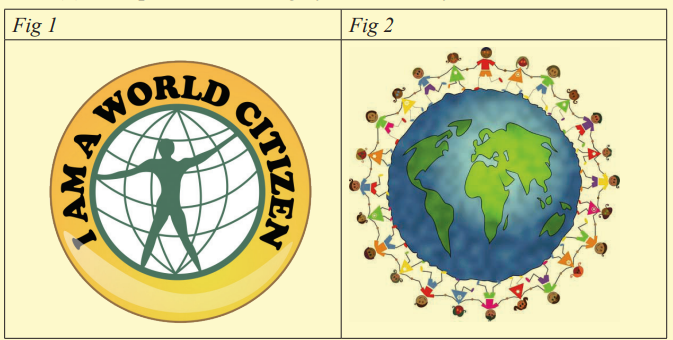
Your teacher will read to you a passage. Listen carefully
and do the activity that follows it.
What is globalisation?
Globalisation is a process of interaction and integration among the people,
companies, and governments of different nations, a process driven by
international trade and investment and aided by information technology.
This process has effects on the environment, on culture, on political
systems, on economic development and prosperity, and on humanphysical well-being in societies around the world.
Globalisation is not new, though. For thousands of years, people—and,
later, corporations—have been buying from and selling to each other
in lands at great distances, such as through the famed Silk Road across
Central Asia that connected China and Europe during the Middle
Ages. Likewise, for centuries, people and corporations have invested
in enterprises in other countries. In fact, many of the features of the
current wave of globalisation are similar to those prevailing before theoutbreak of the First World War in 1914.
Map of the Silk Road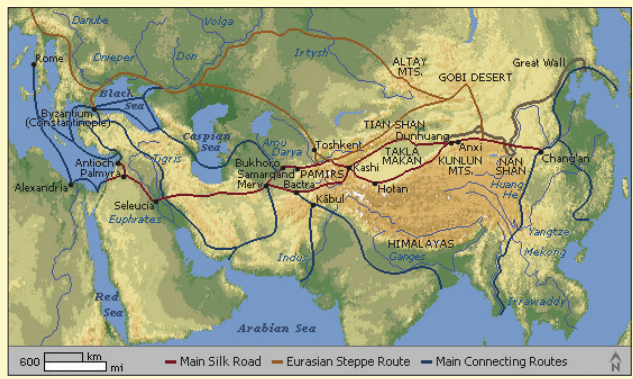
But policy and technological developments of the past few decades have
spurred increases in cross-border trade, investment, and migration so
large that many observers believe the world has entered a qualitatively
new phase in its economic development. Since 1950, for example, the
volume of world trade has increased by 20 times, and from just 1997
to 1999 flows of foreign investment nearly doubled, from $468 billion
to $827 billion. Distinguishing this current wave of globalisation from
earlier ones, author Thomas Friedman has said that today globalisation
is “farther, faster, cheaper, and deeper.”
This current wave of globalisation has been driven by policies that have
opened up economies domestically and internationally. In the years
since the Second World War, and especially during the past two decades,
many governments have adopted free-market economic systems, vastly
increasing their own productive potential and creating myriad newopportunities for international trade and investment.
Governments also have negotiated dramatic reductions in barriers to
commerce and have established international agreements to promote
trade in goods, services, and investment. Taking advantage of new
opportunities in foreign markets, corporations have built foreign factories
and established production and marketing arrangements with foreign
partners. A defining feature of globalisation, therefore, is an international
industrial and financial business structure.
Technology has been the other principal driver of globalisation. Advances
in information technology, in particular, have dramatically transformed
economic life. Information technologies have given all sorts of individual
economic actors—consumers, investors, businesses—valuable new tools
for identifying and pursuing economic opportunities, including faster
and more informed analyses of economic trends around the world, easy
transfers of assets, and collaboration with far-flung partners.
Globalisation is deeply controversial, however. Proponents of
globalisation argue that it allows poor countries and their citizens to
develop economically and raise their standards of living, while opponents
of globalisation claim that the creation of an unfettered international free
market has benefited multinational corporations in the Western world
at the expense of local enterprises, local cultures, and common people.
Resistance to globalisation has, therefore, taken shape both at a popular
and at a governmental level as people and governments try to manage
the flow of capital, labour, goods and ideas that constitute the current
wave of globalisation.
According to Wikipedia Free Encyclopaedia , the term “citizenship”
refers to an identity between a person and a city, state or nation and their
right to work, live and participate politically in a particular geographical
area.
When combined with the term “global”, it typically defines a person who
places their identity with a “global community” above their identity as
a citizen of a particular nation or place. The idea is that one’s identity
transcends geography or political borders and that responsibilities
or rights are or can be derived from membership of a broader class:“humanity”.
This does not mean that such a person denounces or waives their
nationality or other, more local identities, but such identities are given“second place” to their membership of a global community.
This does not mean that such a person denounces or waives their
nationality or other, more local identities, but such identities are given“second place” to their membership of a global community.
Activity 3
Discussion
Use the knowledge you have listened to from the listening passage.
Weigh the benefits and costs of globalisation. Write an essay. Compare
your essays with those of other classmates.
In general usage, the term globalisation may have much the same
meaning as “world citizen”. What do you think the phrase “world citizen”implies? Discuss the benefits and shortfalls of world citizenship.
Activity 4
Dialogue
Practise and act out the dialogue below with a classmate.
Joan: Hello David. Did you hear the recent government
proposal of exploring the possibility of investing in video
conferencing to connect school children and teachers tothe outside world?
David: Oh yes, I did hear. What do you think? Wouldn’t it be
excellent if our government connected us to the global
world using the internet so that we could communicate
to each other and exchange ideas! Won’t that be so
wonderful?
Joan: Trust me. Whoever thought about this proposal indeed
thought very well for us school-going children and our
valued teachers. The proposal should be made into a
bill, tabled in parliament and passed quickly. There are
so many benefits we shall derive out of it, besides the
exchange of ideas you have mentioned!
David: I have already heard about the‘World Links for
Development’ programme which has helped to connect
schools, teachers and students of various countries
around the globe. In a televised dialogue with one of the
beneficiaries, I really envied him when he enumerated the
many benefits of global connections using the internet.
Joan: What did he precisely say?
David: Many things, but I am most certain this is the trend
we are becoming a part of. Besides, information
and communication technology itself has, of course,
changed dramatically around the world. There is more
of it; it is more powerful; it is faster; it is cheaper; it is
available to many more people; and many more people
know how to, and do use it as part of their daily lives.
The information and communication tools to make
connections between teachers and learners across national
borders have improved a lot, are very useful, sustainable,
environmentally friendly and even exciting.Joan: Wow, what an exciting world we are going to enjoy!
Activity 5
Discussion
Read through the dialogue again. Use it to discuss the benefits of
people around the world being linked to each other through the use of
the internet. Choose a secretary to share your views with the class forcomparison and further discussion of your opinions.
Activity 6
Research/Conducting a survey
Your teacher will take you to a tour agency. Find out the number of
people who leave Rwanda and those who come into Rwanda. Find out
from the tour staff the reasons why people leave Rwanda and why otherscome into Rwanda. Present your findings in a table.
‘People around the world travel to different countries.’ Use the table
above to write a composition about the reasons and benefits these people
gain by travelling to these countries. Compare your essay with those ofyour classmates.
Activity 7
Essay writing
Some of you could be having family connections or friends in foreign
countries and may have visited other countries. Write a letter to your
pen pals or family friends informing them about your cultures, or any
other subject of your choice. Exchange your letters with your classmates.
Describing international trade
Activity 1
Discuss these questions
(a) Visit nearby shops and supermarkets. Or, look at the labels
on some of the products in your home that you use. On
some of the labels are written the countries where they are
made or manufactured. Describe the goods that you see on
the Rwandan markets that are not produced in our country.
Why do you think our country cannot produce those goods?
Do you know of some products and services that Rwanda
exports to other countries? Describe them.
(b) Look at cars. Most of them are manufactured in Europe and
Asia. Why do you think we cannot as per now manufacture
them in Rwanda?
(c) Do you have some suggestions you can recommend so that
Rwanda starts manufacturing the products she imports?
(d) Explain how Rwanda benefits by exporting her productsand services to other countries
Activity 2
Read the passage below carefully
Rwanda is predominantly a country of rural farmers, with few natural
resources. About 90% of the population is engaged in agriculture and
the remainder in the service sector. Tea and coffee are the main export
commodities of Rwanda trade. Since 2001, growth has been driven by
exports to the tune of 5% in the last five years.
Rwanda trade: Exports
Despite the setback caused by the 1994 genocide, Rwanda has spared
no efforts to put its economy back on track. The signing of an Enhanced
Structural Adjustment Facility with the International Monetary Fund
(IMF) in 1998 saw the beginning of privatisation, with support from the
World Bank. Rwanda’s exports include: tea; coffee; coltan; cassiterite;
iron ore; tin and animal hides.
Currently, Rwanda’s road to recovery and robustness is largely dependent
on the fluctuation in tea and coffee prices in the international market.
In 2000, coffee production stood at 14,578,560 tons and in 2002, tea
became the largest export item at 15,000 tons, translating into revenues
of US$18 million. Animal hides and tin ore are Rwanda’s other export
goods. Most of Rwanda’s exports go to China (9.1%), Germany (7.3%),
the US (4.5%), Thailand (8.6%) and Belgium (4.1%). The total revenues
generated by exports in Rwanda’s economy are around US$213 million
(2009 est.).
Rwanda Trade: Imports
Rwanda’s trade imports are far larger than its exports and are in the
region of $786 million (2009 est.). The main countries that goods are
imported from include Kenya (15%), Uganda (13.1%), China (6.2%),Belgium (5.2%), and Germany (4.5%).
France and Israel are also countries that Rwanda imports from. The main
imports are: machinery and equipment; steel; cement and construction
material; Petroleum products and foodstuffs.
The US is an important exporter to Rwanda, accounting for almost $10
million in imports annually since 1990-93, and over $40 million in
1994 and 1995. In 2007, the amount rose to approximately $17 million,
a 20% increase over the 2006 level. Being a member of the Common
Market for Eastern and Southern Africa (COMESA) and the East African
Community, roughly 90% of Rwanda’s imports come from COMESAcountries and 34% from other African countries.
Exercise
Answer these questions about the passage you have read
1. How does Rwanda’s being predominantly an agricultural economy
affect the country?
2. What do you think can be done to improve the agricultural sector so
that Rwandan agricultural produce can become more competitive
on the international market?
3. Describe Rwanda’s main export commodities.
4. Explain the contribution of coffee production to Rwanda’s
economy.5. Compare Rwanda’s imports and exports.
Activity 3
Data presentation and information transfer
Use the passage to draw pie charts showing Rwanda’s imports and
exports to other countries as far as her international trade is concerned.
Choose a secretary to present while interpreting your pie charts to the
class
The present perfect tense
Activity 1
Study these two sentences carefully with a classmate. Explain the
meanings of the two sentences.
(a) Rwanda is a predominately agricultural economy.(b) Rwanda has been a predominately agricultural economy.
Exercise
Multiple choice
Rewrite the sentences by choosing the correct word from the
brackets.
1. Who among the three workers (has/have) absconded from duty?
2. The girl (has/have) gone for a study tour at the National Statistics
of Rwanda offices.
3. Tea and coffee (has/have) been Rwanda’s main export commodities
for quite a long time.
4. Despite the setback caused by the 1994 genocide, Rwanda (have/
has) spared no efforts to put its economy back on track.
5. The signing of an Enhanced Structural Adjustment Facility with
the International Monetary Fund (IMF) in 1998 (have/has) seen
the beginning of privatisation, with support from the World Bank.
6. Rwanda’s road to recovery and robustness (have/has) largely
been dependent on the fluctuations in tea and coffee prices in the
international market.
7. The total revenues generated by exports in Rwanda’s economy
(has/have) been around US$213 million.
8. Rwanda’s trade imports (has/ have) been far larger than its exports.
9. Machinery and equipment (has/have) been Rwanda’s main import
products.
10. Being a member of the Common Market for Eastern and Southern
Africa (COMESA) and the East African Community (have/has)boosted Rwanda economy.
Describing international organisationsRwanda belongs to quite a number of international organisations.
Activity 1
Research
Use the internet of your school to identify the international organisations
that Rwanda belongs to. Also, find out how Rwanda benefits by being
a member of these international organisations. Report back to your
classmates. Compile a report about your findings. Write an essay andcompare it with other classmates
Describing sources of income
Activity 1
Graphic data presentation and information transfer
The following graph is a broad analysis of Rwanda’s sources of income
extracted from the source: Global EDGE. Study the graph carefully
Source: global EDGE
Activity 2
Present the data in the graph in a pie chart. Use the data to write aparagraph describing Rwanda’s sources of income
Activity 3
Research
If 90% of the Rwandan population work in agriculture, and it accounts
for 33.12% of the economy, carry out research using the internet or
consult relevant textbooks on the contribution of other sectors to
Rwanda’s economy. Draw a pie chart showing Rwanda’s sources of
revenue from your research. Describe the information in your pie chart
about Rwanda’s sources of revenue and compare your pie chart withthose of other classmates.
Multinational trade
Activity 1
Discussion
Let us study the meaning of the three words multi meaning many;
national meaning countries; and trade referring to the exchange of
commodities. When joined together, the term multinational trade
means many countries trading amongst themselves; it is also called
overseas trade.
1. Identify multinational corporations operating in Rwanda and their
products
2. Compare the size of the companies, staff, technology and
products of multinational corporations from Europe, Asia, North
America and South America operating in Rwanda with indigenous
companies or private firms in developing countries like Rwanda.Present your work in an essay.
3. Use the photographs in Fig. 1 and Fig. 2 above to account for
the emerging multinational corporations in Rwanda and other
African countries.
Activity 2
Discussion
Look at factors of production like technological advancement, among
many others.
Explain how the differences in the factors of production account for the
goods and services manufactured between developing countries and
developed nations, such as those in Europe, Asia and America.
What do you think are the effects of multinational corporations on
indigenous firms in developing countries like Rwanda?
Choose a secretary to present your findings to the class for furtherdiscussion and comparison of your answers.
Describing multinational companies
Activity 1
Research
Visit any multinational company operating in Rwanda. (Remember to
go with your valid school identification card.) Inform the management
or authorities that you are on a study visit to carry out research about
that multinational corporation.
Ask them to give you information about the products, operation and
reasons why they chose to extend their trade activities to Rwanda, plus
any other additional information that may be relevant for your research.
Make notes as you carry out your research.
After, organise your notes and write a detailed report about the
multinational corporation you visited. Organise it in headings,
paragraphs and numbering (scan and skim through some of the passages
in this textbook to help you do this activity). Share your findings withyour classmates.
Describing a multinational company in
Rwanda
Activity 1
Read the passage carefully
Rwanda to export cement as new plant boosts production
Anastase Murekezi, the Rwanda Prime Minister (R), on a guided tour of the new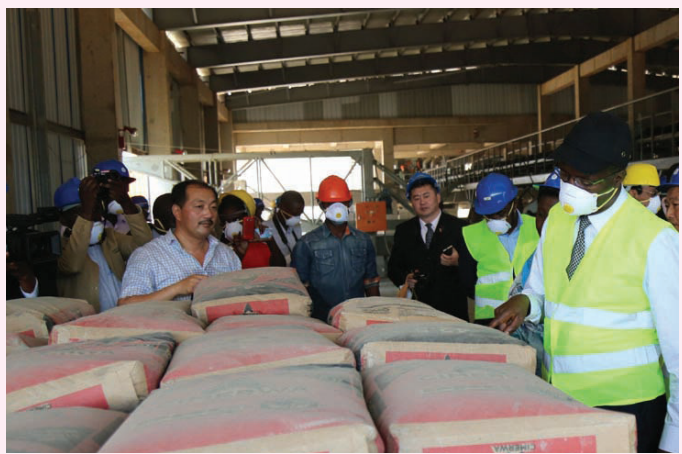
CIMERWA cement plant
(Photo credit: Timothy Kisambira)
Rwanda’s only cement manufacturer, CIMERWA Ltd, unveiled a new
plant expected to increase production and boost export revenues.
The new state-of-the-art plant in Muganza sector, Rusizi district, was
inaugurated by the Prime Minister, Anastase Murekezi.
The factory, worth $170 million, has the capacity to produce six timesthe current capacity of 100,000 tonnes per year
Speaking at the launch, Murekezi said the new plant presents
an opportunity for the country to start exporting cement to its
neighbours, while creating employment opportunities for Rwandans.
Increasing production capacity, according to Murekezi, makes it possible
for the plant to export up to 30% of total production (200,000 tonnes)
to other countries, such as DR Congo and Burundi.
This, according to the Prime Minister, will help drive sustainable
economic development and poverty reduction.
And, most importantly, exporting cement to neighbouring countries
means Rwanda will be able to reduce its trade deficit gap with at least
an additional $92 million per year in foreign revenues, according to the
National Bank of Rwanda (NBR).
Rwanda’s current cement demand is estimated at about 450,000 tonnes
per year.
However, demand across the borders in DR Congo and Burundi is more
than 900,000 tonnes.
Legodi Busisiwe, the Chief Executive Officer of CIMERWA Ltd, said
the new plant would play a critical role in enhancing competitiveness
of the local construction sector through reduced logistical costs.
“The new plant seeks to bring on board high quality products that will
help boost the capacity of the country’s infrastructure,” he said.
Busisiwe hailed the country’s new investment code as a step forward in
attracting more investments into the country.
The new plant comes at a time when the government is trying to narrow
the country’s trade deficit gap by boosting its exports to the tune of atleast 28% every year.

CIMERWA cement factory, Muganza sector, Rusizi district
The country’s trade deficit improved by 6.0% from $722.56 million in
2014 to $6779.22 million during the first five months of 2015.
There is hope that exporting cement could further narrow this gap.
Bringing down cement prices
Meanwhile, there is hope among market players that increasing cement
production will reduce the high prices of CIMERWA cement in the
country.
Currently, one bag of cement costs FRW 11,000, which is higher than
imported cement that goes for between FRW 8,500 and FRW 9,000.
Ephraim Karekezi, a Kigali-based engineer, believes the new plant
will help bring down cement prices.
“The cost of construction is high simply because of high prices of raw
materials, including cement. Therefore, the new cement plant offers
sector players the greenlight in addressing the question of affordabilityand propelling the sector towards economic excellence,” said Karekezi.

CIMERWA cement bags ready for the market
Figures from the National Institute of Statistics of Rwanda indicate there
has been a significant increase in the construction sector’s contribution
to the national economy.
The sector contributed FRW 109 billion to GDP during the first quarter
of 2015, up from FRW 106 billion in the same period of 2014.
Real estate activities contributed FRW 91 billion to the national economy,
up from FRW 83 billion during the first quarter of 2014.
More employment opportunities
Frederick Harerimana, the mayor of Rusizi district, said the new plant
offers immense opportunities to the construction industry and the
employment sector.
According to Vivens Kalinganire, the human resource manager at
CIMERWA, the new factory is expected to create more than 100 new
jobs in addition to the current 126 employees by the end of the year.Source: The New Times, by Peterson Tumwebaze. Published 19 August 2015
Exercise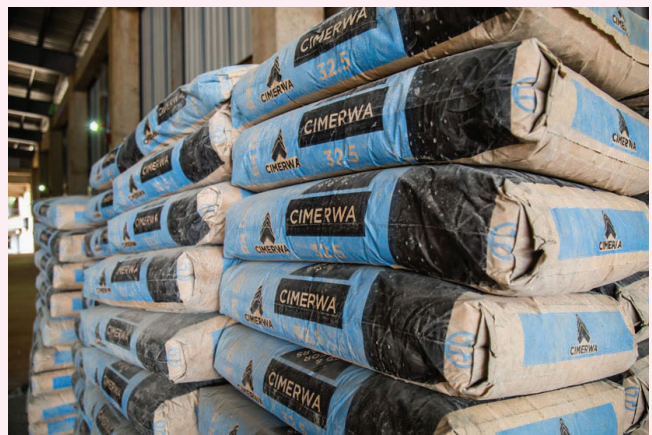
Answer these questions
1. How will Rwanda benefit from the new cement plant?
2. In your own words, explain what you understand by the phrase
‘trade deficit gap’.
3. Describe how the cement plant will reduce the trade deficit gap.
4. Using your knowledge of Economics, explain how the increase
in cement production at CIMERWA will reduce the high prices
of cement.
5. How is the cement plant poised to benefit from the significant
increase in the construction sector of the national economy?
Present perfect passive voice
Activity 2
Look at these sentences carefully.
(a) CIMERWA, the new factory, has created more jobs this year.
(b) New jobs have been created this year by CIMERWA, the
new factory.
What do you realise about the tenses and the subject clauses of thesentences above?
Exercise
Gap filling
Rewrite the sentences as instructed without changing the
meaning.
1. The new cement plant has boosted our economy.
(End: …… the new cement plant.)
2. The factory workers have manufactured 100 types of cars.
(Start: 100 types ……………)
3. The CEO has announced new jobs in his company.
(End: ……….CEO.)
4. The new trade tariffs have barred many industries from joining
the multinational trade.
(Start: Many industries ……………)
5. The new manager has instructed her workers to study the
market trends and adjust their systems of operation and
production.
(End: …………. new manager.)
Sentence completion
Complete sentences 6-8 meaningfully.
6. ……….. by the construction workers.
7. The new directive has been ………………
8. Indigenous firms have been ………. by the multinationalcorporations.
UNIT10:Living in a Foreign Country
During the time I was living in the foreign country, I realised that
living abroad does more for you than just being bilingual; it enables
you to form new relationships and to learn about the real culture
of a country. I never returned to the United States, but I will never
forget this memorable experience in my life.
Kayitesi
My goals
After studying this unit, I will be able to:
⦿ Describe recent activities, current activities, possibilities, plans and
future activities.
⦿ Compare cultures and describe emotions.
⦿ Read a letter from someone living in a foreign country.
⦿ Write sentences using ‘may’, ‘might’, ‘could’.⦿ To use: ‘can’, ‘may’, ‘have to’, ‘paragraphs’, ‘more’, ‘fewer’, ‘no’.
Describing recent activities
y Language useActivity 1
Discussion
Share with your classmates these questions.
(a) What is your dream destination?
(b) What have you heard about people who go to Europe or
America, or any other countries outside Rwanda? Describe
their experiences in those countries.
(c) Why do you think most people would love to visit those
countries?
(d) If you have ever travelled to Europe or America or any
other country overseas, describe to your classmates what
you saw. If you have never travelled there, visit the internet
facility of your school’s computer laboratory. Search about
a country overseas you would love to visit and find the
interesting details you would see. Describe those things toyour classmates
Activity 2
Discussion
Study the following photographs carefully that show New York City
in the United States of America and the City of London in the United
Kingdom. Describe what you see in each photograph and compare thetwo cities
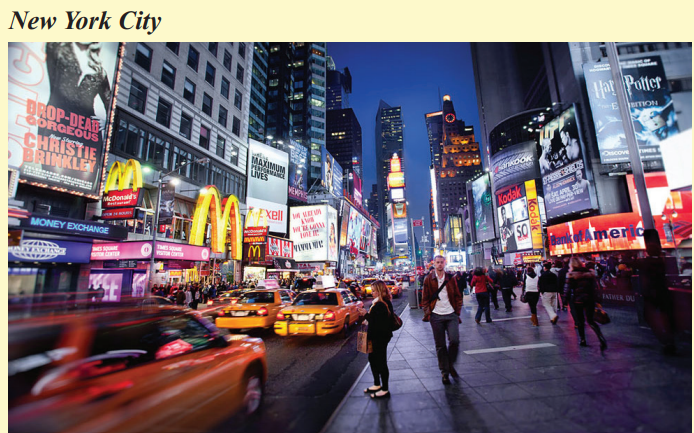
Activity 3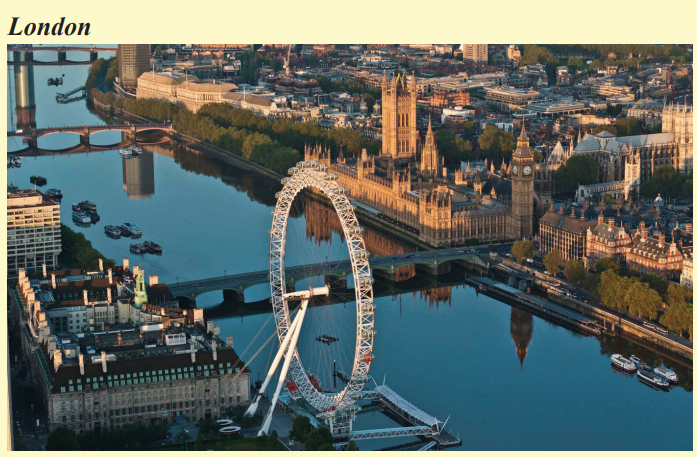
Look at the child in the picture holding the Rwanda national flag andUnited States of America flag. What message does the girl communicate?
Activity 4
Read the letter below carefully and compare the life in Rwanda with
that in the United States of America. Choose a secretary to present
your findings to the class for further discussion and comparison of your
answers.
My dear friend,
Thank you for the email. I stay with an aunt who has been living
in the United States since she was eighteen years old and she invited
me to stay with her many times. One day I decided to go. Staying
with her and her family was one of the greatest experiences in my
life. Besides learning a new language, I made new friends and Ireally got into the culture of a great and beautiful country.
When I arrived there, I got very excited. First, I was excited because
it was my first time in a foreign country, and second because I was
going to experience something really new in my life. On the other
hand, learning English wasn’t an easy process because my aunt used
to speak just Portuguese with me; I used to take English classes just
twice a week and all the students were foreign too. My experience
of learning English in a regular course was limited to this little
experience and a short period taking English as a second language
at the local college. Thus, from that period until the end of the time
there, I learnt the language with the people from the city and the
new friends I had met.
Besides the experience of studying a new language, making new
friends was the best aspect of living abroad. I had a girlfriend who
lived in a beautiful city by the Pacific Ocean and I used to spend
every weekend with her. We used to go out often and one of these
times I met my first American boyfriend. He was handsome and
very kind and we had a great time together. He took me to many
interesting places and showed me the authentic American way of
life by introducing me to his family, his friends and his culture.
Moreover, going out constantly and talking to him helped me to
improve the skills with the language and mainly to be familiar with
the American people and their habits and customs.
Another great experience I had was working as a babysitter. Once
I read in the newspaper an advertisement looking for a foreign girl
to take care of two children. At first I got really scared about the
big responsibility of taking care of two children, but I decided to
live this new adventure. The family’s house was in a very nice place
by the ocean and the children were very cute and curious about my
“weird accent”. In spite of the fact that this new experience wasn’t
easy due to my lack of practice at that time, everything went well
and the whole situation was very meaningful to my life.
During the time I was living in the foreign country, I realised that
living abroad does more for you than just being bilingual; it enables
you to form new relationships and to learn about the real culture
of a country. I never returned to the United States, but I will never
forget this memorable experience in my life.
KayitesiDebate the motion as a class
“Living in Rwanda and living in Europe; which do you prefer?” Give
reasons for your opinions.
Procedure for the debate
Activity 5
1. Ten people will take part in the debate. Five students will support
the motion and the other five will be against it.
2. Elect a chairperson, timekeeper and secretary to moderate the
debate. The timekeeper will help the speakers keep time; The
secretary will record what is said and announce the results; the
chairperson is the overall person in charge of moderating the
debate session.
3. Each speaker should prepare their points for debating well in
advance.
4. Each speaker should use three minutes. Points of information,
order, clarification, etc. will be raised and the chairperson will
decide which to allow or reject.
5. The rest of the class should listen attentively while taking notes.
6. The chairperson will choose a few students from the audience to
debate (propose or oppose) the motion.
7. The secretary will read the summary points from the audience to
agree or disagree with the motion. The secretary will declare the
side with majority points the winner.8. Finally, the chairperson will close the debate.
Describing current activities
Present continuous tense
Activity 1
Look at the photograph below of Imperial College in
London and read the sentence below it
Discuss with a classmate the meaning of the sentence. Use the sentence
to explain the time of the action in the present continuous tense.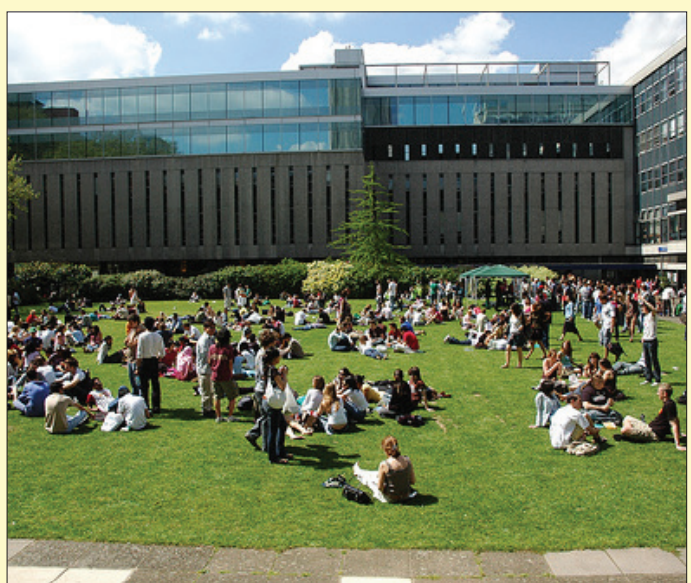
Imperial College in London
I am studying at Imperial College in London. (Is the speaker still at thecollege or not?)
Exercise
Below are some of the sentences extracted from the letter you read above.
Rewrite them in the present continuous tense. Share your answers with
your classmates.
1. I stay with an aunt who has been living in the United States since
she was eighteen years old.
2. I made new friends and I really got into the culture of a great and
beautiful country.
3. I was excited because it was my first time in a foreign country.
4. I used to take English classes just twice a week.
5. I learnt the language with the people from the city and the new
friends I had met.
6. I used to spend every weekend with her.
7. He took me to many interesting places and showed me the
authentic American way of life by introducing me to his family,
his friends and his culture.
8. Moreover, going out constantly and talking to him helped me to
improve the skills with the language and mainly to be familiar
with the American people and their habits and customs.
9. I was working as a babysitter.
10. I realised that living abroad does more for you than just being
bilingual.
Describing possibilities
Activity 1
Study the photographs and read about London.
Attractions that will amaze you about this wonderful
city in the world.
There are things that would catch your eye if you visited London
and leave you speechless regarding the great architectural designs of
buildings. From the modern Coca-Cola London Eye, to the historic
Tower of London, London’s top 10 tourist attractions are a must-see on
any London sightseeing trip. Even better, many London landmarks are
free to visit. There are also plenty of children-friendly places to visit in
London, such as the SEALIFE London Aquarium and Kensington’sScience Museum.

(Source: British Museum)
Founded in 1753, the British Museum’s remarkable collection spans over
two million years of human history. You will enjoy a unique comparison
of the treasures of world cultures under one roof, centred around the
magnificent Great Court
World-famous objects such as the Rosetta Stone, Parthenon sculptures,
and Egyptian mummies are visited by up to six million visitors per
year. In addition to the vast permanent collection, the museum’s
special exhibitions, displays and events are all designed to advance
understanding of the collection and cultures they represent. Some of
the facilities in this wonderful museum are:
The crowning glory of Trafalgar Square, London’s National Gallery, is
a vast space filled with Western European paintings from the 13th to the
19th centuries. Here, you will find works by the finest art masters suchas Van Gogh, Da Vinci, Botticelli, Constable, Renoir, Titian and Stubbs.
As well as the permanent (and permanently fascinating!) dinosaur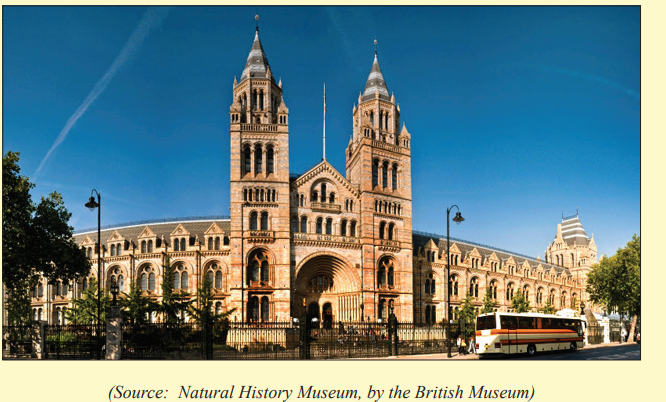
exhibition, the Natural History Museum boasts a collection of the
biggest, tallest and rarest animals in the world. Here you will see a
life-sized blue whale, a 40-million-year-old spider, and the beautiful
Central Hall.
(Source: Tate Modern, by the British Museum)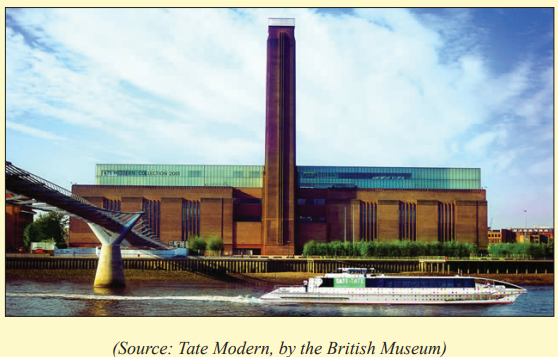
Sitting grandly on the banks of the Thames is Tate Modern, Britain’s
national museum of modern and contemporary art. Its unique shape is
due to it previously being a power station. The gallery’s restaurants offerfabulous views across the city.
The Coca-Cola London Eye is a major feature of London’s skyline. It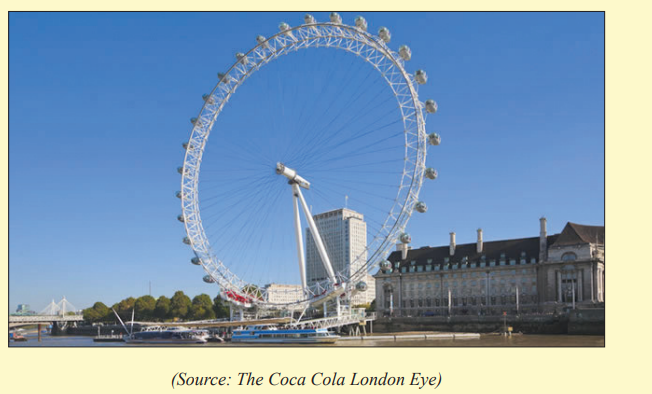
boasts some of London’s best views from its 32 capsules, each weighing
10 tonnes and holding up to 25 people. Climb aboard for a breathtaking
experience, with an unforgettable perspective of more than 55 ofLondon’s most famous landmarks – all in just 30 minutes!
From the future of space travel to asking that difficult question: “Who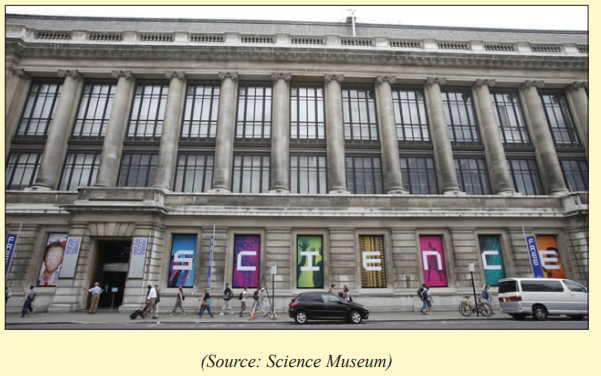
am I?”, the Science Museum makes your brain perform Olympic
standard mental gymnastics. See, touch and experience the major
scientific advances of the last 300 years; and don’t forget the awesomeImax Cinema.
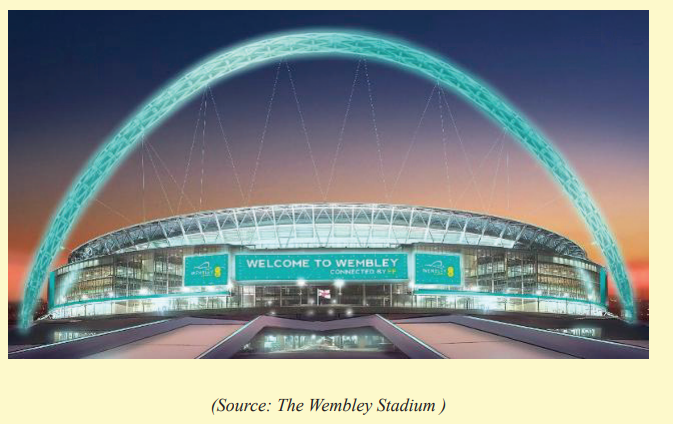
Take the unforgettable Wembley Stadium tour. Go behind the scenes into
England’s changing rooms. Walk in the footsteps of legends, through
the players’ tunnel towards the hallowed turf. Stand triumphantly in
front of the Royal Box with The Cup. Until your dream of playing at
Wembley comes true, the only way to experience all this and more is
to book your Wembley Stadium tour now.
The tour also includes ‘The FA150 Exhibition’ celebrating the history of
the Football Association’s tenure as the original governing body of the
world’s most popular sport. The exhibition includes the Original Rules
of Association Football from 1863 and the 1966 Jules Rimet Trophy(aka The World Cup)
Using ‘may’, ‘might’, ‘could’
Activity 2
After reading the passage, identify the places you would love to tour
and the things you would do in those places. Form sentences using may
might, could. Use the example below to guide you. Share your answerswith your classmates.
1. I might stay in London.
2. I could study in York.
3. I may rent a room at the university.
Grammar highlight: The modal verbs ‘might’, ‘could’, ‘may’ show ideas
of possibility or permission. Others, like ‘must’, ‘have to’ show obligation.‘Can’ shows ability. ‘Should’, ‘ought to’ are model verbs of advice.
Describing plans
Activity 1
Great Britain, also known as the United Kingdom, comprises four
countries, namely England, Scotland, Northern Ireland and Wales.
The photographs below show some of the cultural aspects and themountainous nature of Scotland. Study them and describe what you see.

Activity 2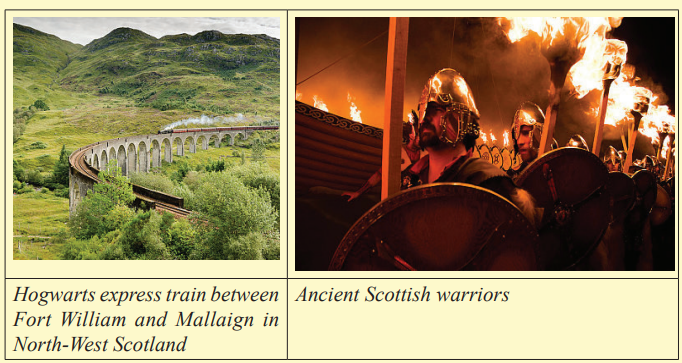
Carry out research about the interesting culture and social life in
Scotland. Assume you are living in Scotland. Use your research to write
a letter describing the interesting places to visit and social life to explore.Exchange your letters so that you can read through and compare them.
Describing future activities
Activity 1
Read this statement with a classmate. What is the time the action will
be taking place?
Examples
(a) I will be climbing mountains in Scotland.(b) She will be having a drink with her friends.
Activity 2
Rewrite the following sentences in the future as shown
in the examples above
1. I visit St. Mungo’s tomb every Friday.
2. We shall go to Glasgow Cathedral next week.
3. Mary Queen of Scots granted the lands of Provand to William
Baillie, a canon of the Cathedral.
4. The visitor enjoyed the experience of the Glenmorangie Distillery
tour.
5. You may have to retrain yourself!
6. The children will arrive in the royal yacht Britannia which is
perhaps the most famous ship in the world.
7. She has served the British royal family for over 40 years.
8. Guests are piped aboard via the Royal Brow and taken on a tour,
then welcomed into the State Apartments where they can enjoy
cocktails and canapés.
9. We will visit the historic Melrose Abbey.
10. The wheel will swing in the Tamfourhill area of Falkirk.
11. We will meet each other at Kelvingrove Art Gallery.
12. The tourists will visit the Melrose Abbey on Thursday.
13. We shall surf the Glasgow Science Centre on the internet.14. We will watch Blair Drummond Adventure on television
Comparing cultures
Activity 1
Discussion
Share your opinions about these questions.
(a) Compare the social and cultural lifestyles of Rwanda with
the Western lifestyles.
(b) Do you think there are certain customs we can borrow from
the Western countries into our cultures? Which ones?
(c) Describe the impact that Western cultures have had on our
cultures.
Choose a secretary to present your findings to the class for furtherdiscussion and comparison of your opinions

The English always say ‘sorry’. They queue up for buses
Activity 2
Read the two passages below carefully
Culture and social etiquette in the United Kingdom
There are no strict etiquette rules that you have to stick to when in the
UK. It is advisable, however, to demonstrate decent manners and respect
to the local culture and traditions.
The first, and most important step, is to be aware of the clearly distinct
nations which form the UK. The United Kingdom of Great Britain and
Northern Ireland consists of England, Scotland, Wales and Northern
Ireland. The citizens of any of these countries may be referred to as
“British”. This term is also the safest to use when not certain of a
person’s heritage. When certain of heritage, you are free to call the
different residents as follows: English, Scot, Welsh or Irish. While the
four countries share many customs, each has its own set of traditionsand history.
Greetings and meetings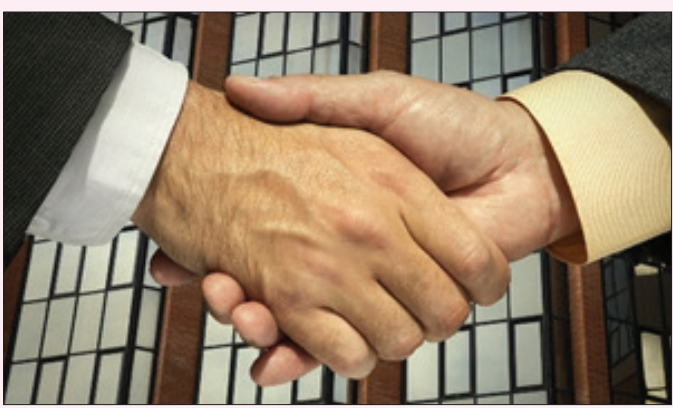
When first meeting a Briton, he or she may seem reserved and cold, but
that is just an impression. In reality, they are very friendly and helpful to
foreigners. A handshake is the common form of greeting, but try to avoid
prolonged eye contact, as it may make people feel ill at ease. Use last
names and appropriate titles until specifically invited to use first names.
It is proper to shake hands with everyone to whom you are introduced,
both men and women; the appropriate response to an introduction is“Pleased to meet you”.
Time and punctuality
British people are very strict when it comes to punctuality. In Britain
people make a great effort to arrive on time, so it is considered impolite
to be late, even by a few minutes. If you are delayed, be sure to inform
the person you are meeting. Here are some situations when you are
obliged to be on time, as well as some situations when it is advisable:
• For formal dinners, lunches, or appointments you always come at
the exact time appointed.
• For public meetings, plays, concerts, movies, sporting events,
classes, church services, and weddings, it’s best to arrive a few
minutes early.
• You can arrive any time during the hours specified for teas,
receptions and cocktail parties.
The British often use expressions such as “drop in any time” and “come
see me soon”. However, do not take these literally. To be on the safe
side, always telephone before visiting someone at home. If you receive
a written invitation to an event that says “RSVP”, you should respondto the sender as soon as possible, whether you are going to attend or not

Body language and dress code
British people are not very keen on displaying affection in public.
Hugging, kissing and touching are usually reserved for family
members and very close friends. You should also avoid talking loudly
in public or going to extremes with hand gestures during the course of
communication. The British like a certain amount of personal space. Do
not stand too close to another person or put your arm around someone’s
shoulder.
When it comes to clothes, there are no limits and restrictions on how to
dress. Just make sure that you respect the general rules when in formal
situations. Observation will reveal that people in larger cities dress
more formally, especially in London. Men and women wear wools and
tweeds for casual occasions. Slacks, sweaters and jackets are appropriate
for men and women. Do not wear a blazer to work -- it is country or
weekend wear. On formal occasions, always select an outfit that fits the
dress code. When attending a holiday dinner or cultural event, such as
a concert or theatre performance, it is best to dress formally.
General advice
Men should open doors for women and stand when a woman enters
a room, although it is generally accepted for men and women both to
hold the door open for each other, depending on who goes through the
door first.
It is important to respect the British desire for privacy. Don’t ask personal
questions about family background and origin, profession, marital status,
political preferences or money issues. It is considered extremely impolite
to violate a queue, so never push ahead in a line. It is also considered
very rude to try to sound British or mimic their accent.
Remember that humour is ever-present in English life.
It is often selfdeprecating, ribbing, sarcastic, sexist or racist.Try not to take offence.
Cultural etiquette dictates that when invited to someone’s home, you
should bring a small gift for the hostess. Give flowers, chocolates, wine,
champagne or books. Feel free to express your gratitude and delight with
the visit on the next day with a note or a telephone call.
Women’s rules
Women in Britain are entitled to equal respect and status as men, both
at work and daily life. The British have the habit to use ‘affectionate’
names when addressing someone, so do not take any offence if they
call you love, dearie, or darling. These are commonly used and not
considered rude.
It is acceptable, but may be misconstrued, for a foreign woman to invite
an English man to dinner. It is best to stick with lunch. Also, if you would
like to pay for your meal, you should state it at the outset.(Source: Kirina Boykova / Expatica
Describing cultures
Describing Rwandan culture
Greetings are a central part of social etiquette in Rwanda. In rural areas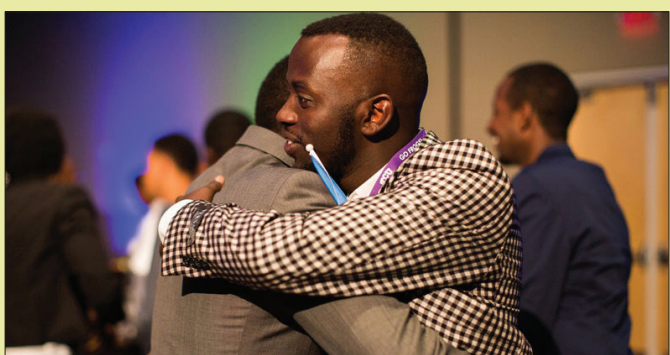
it is important to greet everyone that passes your way – MWARAMUTSE
(in the morning) and MWIRIWE (in the afternoon). People shake hands
with the right hand. Friends often lay a hand on the other’s hip while
the right hand touches the shoulder. To show respect of social status
people hold their right forearm with their left hand while shaking hands.
Men often share a touching of the sides of their foreheads, first right,
than left. Holding hands between people of the same sex is a sign of
friendship. When two people of the opposite sex talk there is very little
to no touching. When a man is greeting a woman it is best to wait for
the women to extend her hand.
Eye contact might be more indirect during a conversation; women and
children might look down or away to show respect.
It is best to avoid asking about someone’s ethnicity or making referrals
to the civil war. Almost every Rwandan has a story related to the 1994
genocide, a trauma so severe that it is difficult for many to cope with,
which is why it is improper to ask people what happened to them. Many
lost loved ones. Good topics of conversation include food, sport (soccer,
running), Rwanda’s landscape, Australia, etc. Rwandans love a goodjoke but avoid sarcasm as it might not translate.
In many situations people are flexible with appointed times, they don’t
tend to be overly punctual. This is different in business situations where
punctuality is valued.
Rwandan people have a set of gestures for pointing to and calling
people. If you want to point to someone hold out the arm with the palm
open and upward. It is considered very rude to point at a person with
your index finger. Calling someone to come over is done by extending
the arm with the palm turned down and bringing in the fingers towards
you, like a scratching motion. Rwandans also have proper ways to give
or receive things. Children learn to offer both hands when receiving an
object, especially form an adult, which shows respect.
The family unit in Rwanda includes husband, wife and children. People
from several related households comprise another kinship. The eldest
or most influential male is considered the head of this unit. Marriage is
very important as marriage and having a child mark a person’s transition
to full adulthood. To get married one has to pay a price for his bride
to her father. Ritual occasions such as weddings serve as important
recreational functions. Having children is very important, because dying
without having them means that no one will honour the deceased’s
spirit. Children who receive the privilege of education are expected to
financially assist the family later.
Clothing is very European but mostly second-hand as not many can
afford to buy new clothes. Rwandan people place great importance
on looking their best and take great pride in their appearance. Men
always wear long pants as shorts are only worn by young children and
schoolboys. In most rural areas, women have to wear clothing that
covers their legs.
Diet is high in starches and low in protein and fat. The most common
foods are various banana types, potatoes and beans (sometimes fish).
Meat is eaten very rarely. The most common is goat while beef is the
most desired but will only be available when someone has sacrificed a
bull or cow on a ceremonial occasion. Cattle are valued as a source of
prestige and milk. While food is not always offered to guests, drinks are.
It is seen as an insult not to offer a drink where others are drinking. Be
aware that it is not accepted for some women to drink alcohol. Bread,coffee and tea are popular for breakfast.
Activity 3
Summary writing
In about 100 words, make a comparison and contrast summary about the
cultural lifestyle of Britons and Rwandans based on the two passages
you have read. Compare your summaries with those of your classmates.
Activity 4
Research and essay writing
Conduct research about the cultural lifestyles (greeting, food, clothing
etc.) of another country of your choice. Compare their customs with
those of Rwanda. Compare your findings with those of your classmates
Talking about emotions
Letter writing
Activity 1
Assume you are in Europe. Use one of the countries you researched
about, and write a friendly letter describing the experiences and the new
life you are living. Compare your letters with those of your classmates.
References
Bishop, G. (1985). Curriculum Development: A Textbook for Students, London:
Macmillan
Carter, R., McCarthy (2006). Cambridge Grammar of English: Cambridge
University Press
Harmer, J. Edinburgh Gate (2001). The Practice of English Language Teaching:
Longman (3rd Ed)
Hancock, M. (2003). English Pronunciation in Use Intermediate (Audio CDs).
Cambridge: Cambridge University Press (book with CDs can be obtained
from Ikirezi Bookshop, Kigali)
Kadeghe, M. (2009). English for Tanzania Secondary Schools: Grammar and
Functional English, Dar es Salaam: Afroplus Industries Ltd.
Ladefoged, P. (2000). Vowels and Consonants, Oxford: Blackwell
Lucy, P. Mair. ‘African Marriage and Social Change.’ In: Survey of African
marriage and family life. Edited by Arthur Phillips, (London, Oxford
University Press, 1953) p.14
National Curriculum Development Centre (2010). Curriculum of English Language
for Primary Schools in Rwanda
National Curriculum Development Centre, Kigali, Ministry of Education, (2010),
Ordinary Level English Program
Roach, P. (2000). English Phonetics and Phonology, 3rd ed. Cambridge: Cambridge
University Press
Roach P. et al (eds.). (2003). Daniel Jones English Pronouncing Dictionary, 16th
ed, Cambridge: Cambridge University Press
Swan, M and Walter, C. (1998). The New Cambridge English Course.
Cambridge: Cambridge
Swan, M. (2005). Practical English Usage, New York: Oxford University Press
